Natural Resources Canada’s Office of Energy Efficiency
Leading Canadians to Energy Efficiency at Home, at Work and on the Road
For information regarding reproduction rights, contact Natural Resources Canada at copyright.droitdauteur@nrcan-rncan.gc.ca.
© Her Majesty the Queen in Right of Canada, as represented by the Minister of Natural Resources, 2016
Aussi disponible en français sous le titre :
Évolution de l’efficacité énergétique au Canada de 1990 à 2013
Cat. No. M141-1E-PDF (Online)
ISSN 1926-8254
Preface
This edition of Energy Efficiency Trends in Canada delivers on Canada’s commitment to provide a comprehensive summary of secondary energy use and related greenhouse gas (GHG) emissions in Canada. It also tracks trends in energy efficiency. This year’s edition is produced electronically.
For more secondary energy use statistics, see the comprehensive energy use database. The database includes most of the historical energy use and GHG emissions data used by Natural Resource Canada’s (NRCan’s) Office of Energy Efficiency (OEE). This database can be viewed at oee.nrcan.gc.ca/corporate/statistics/neud/dpa/data_e/databases.cfm.
This report covers the four sectors analyzed by the OEE, which are the residential, commercial/institutional, industrial and transportation sectors. The 2013 period is the most recent year for which data are available.
For more information about this product or the services that the OEE offers, contact:
Office of Energy Efficiency
Natural Resources Canada
580 Booth Street, 18th Floor
Ottawa ON K1A 0E4
Email: nrcan.statisticsandanalysis-statistiquesetanalyses.rncan@canada.ca
Table of Contents
- Chapter 1: Introduction
- Chapter 2: Energy use
- Overview – Energy use and GHG emissions
- Trends – Energy use and GHG emissions
- Energy intensity and efficiency
- Chapter 3: Residential sector
- Overview – Residential energy use and GHG emissions
- Trends – Residential energy use and GHG emissions
- Trends – Residential space heating energy use
- Trends – Residential water heating energy use
- Trends – Residential appliance energy use
- Trends – Space cooling energy use
- Trends – Lighting energy use
- Residential energy intensity and efficiency
- Chapter 4: Commercial/institutional sector
- Overview – Commercial/institutional energy use and GHG emissions
- Trends – Commercial/institutional energy use and GHG emissions
- Commercial/institutional energy intensity and efficiency
- Chapter 5: Industrial sector
- Overview – Industrial energy use and GHG emissions
- Trends – Industrial energy use and GHG emissions
- Trends – Mining energy use and GHG emissions
- Trends – Smelting and refining energy use and GHG emissions
- Trends – Pulp and paper energy use and GHG emissions
- Trends – Other manufacturing energy use and GHG emissions
- Industrial energy intensity and efficiency
- Chapter 6: Transportation sector
- Overview – Transportation energy use and GHG emissions
- Trends – Transportation energy use and GHG emissions
- Energy efficiency in the transportation sector
- Trends – Passenger transportation energy use and GHG emissions
- Passenger transportation energy intensity and efficiency
- Trends – Freight transportation energy use and GHG emissions
- Freight transportation energy intensity and efficiency
- Appendix A: Reconciliation of data
- Appendix B: Glossary of terms
- Appendix C: List of abbreviations
Chapter 1: Introduction
Canadians spent $195 billion on energy in 2013.
Energy accounts for a large segment of spending by households, businesses, and industries. In 2013, Canadians spent almost $195 billion on energy to heat and cool their homes and offices and to operate their appliances, cars, and industrial processes. This amount is equivalent to about 11 percent of the country’s gross domestic product (GDP).
This report provides an overview of Canada’s secondary energy use and related GHG emissions. In addition to providing detailed information about energy intensity and energy efficiency levels in 2013, this report also analyzes the energy intensity and efficiency trends between 1990 and 2013. Such monitoring aids the OEE in promoting energy efficiency in all aspects of Canadian life. It contributes toward the goal of making Canada a world leader in environmental responsibility in the development and use of natural resources.
Measurement of energy
To compare sources of energy, all energy consumption data presented in this report are expressed in joules. One joule is equivalent to the work required to produce one watt of power continuously for one second. One petajoule (PJ)Footnote 1 , is equivalent to the energy required by more than 9,000 households (excluding transportation requirements) over one year.
Two types of energy use
There are two general types of energy use: primary and secondary. Primary energy use (Figure 1.1) encompasses the total requirements for all users of energy. This includes secondary energy use. Additionally, primary energy use refers to the energy required to transform one form of energy to another (e.g. coal to electricity). It also includes the energy used to bring energy supplies to the consumer (e.g. pipeline). Further, it entails the energy used to feed industrial production processes (e.g. the natural gas used as feedstock by the chemical industries). In 2013, the total amount of primary energy consumed was estimated at 12,681 PJ (see Appendix A, Reconciliation of data, for more details).
Secondary energy useFootnote 2 (Figure 1.1) is the energy used by final consumers in various sectors of the economy. This includes, for example, the energy used by vehicles in the transportation sector. Secondary energy use also encompasses energy required to heat and cool homes or businesses in the residential and commercial/institutional sectors. In addition, it comprises energy required to run machinery in the industrial and agricultural sectors. Secondary energy use accounted for about 70 percent of the primary energy use in 2013, or 8,924.0 PJ.
This report focuses on secondary energy use and assesses trends in this category. The energy used to generate electricity is also included so that electricity emissions may be linked to the appropriate final users of electricity. This mapping of GHG emissions to appropriate electricity consumers is discussed in more detail in the section GHG emissions.
All subsequent references in this report to “energy” should be interpreted as secondary energy.
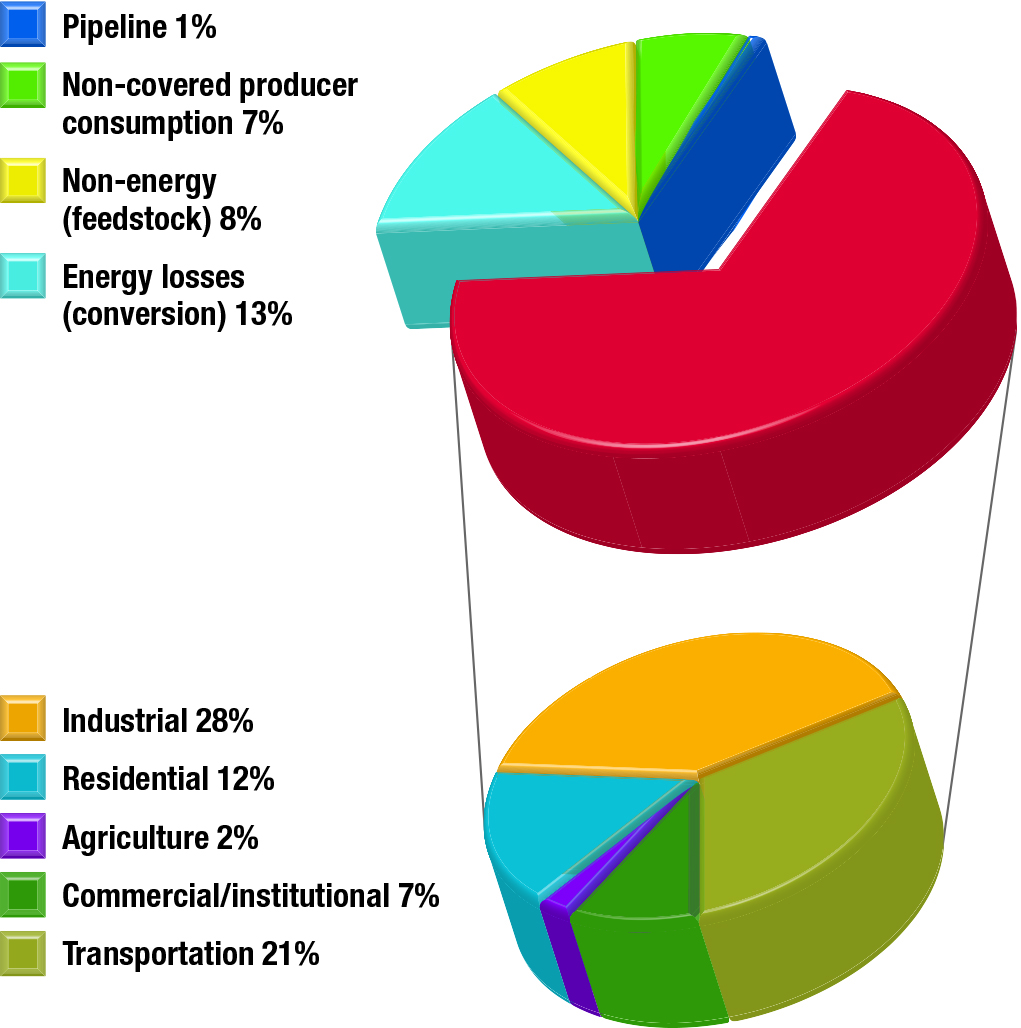
Figure 1.1 Primary and secondary energy use by sector, 2013
Text version
Figure 1.1 displays two pie charts; the first one shows that the secondary energy use covering industrial, transportation, residential, commercial and agriculture sectors accounted for 70% of the total primary energy used in Canada in 2013. The other 30% is accounted for by energy losses (conversion) (13%), non-energy use (feedstock) (8%), producer consumption (7%) and pipeline (1%). The second pie chart demonstrates that the industrial sector accounts for the highest share of 28% of total energy use, the transportation sector 21%, the residential sector 12%, the commercial sector 7% and the agriculture sector 2%.
GHG emissions
This report also analyzes energy-related GHG emissions, including carbon dioxide (CO2), methane (CH4), and nitrous oxide (N2O). CO2 represents almost 97 percent of Canada’s energy-related GHG emissions.
Total Canadian GHG emissions are estimated to have been 725 megatonnes (Mt) in 2013; about 67 percent of this total (or 487.0 Mt) resulted from secondary energy use (including electricity-related GHG emissions).Footnote 3
Unlike other end-use energy sources, electricity use does not produce any GHG emissions at the point of consumption. GHG emissions related to electricity are emitted at the point of generation. These are sometimes referred to as indirect emissions.
Therefore, it is a common practice in energy end-use analysis to allocate GHG emissions associated with electricity production to the sector that uses that electricity. This allocation is done by multiplying the amount of electricity used by a national average emission factor that reflects the average mix of fuels used to generate electricity in Canada.
Environment Canada’s National Inventory Report, 1990–2013 – Greenhouse Gas Sources and Sinks in Canada has more information about total Canadian GHG emissions. This GHG inventory was prepared according to the specifications of the Intergovernmental Panel on Climate Change, accounting for all types of GHG emissions in Canada. However, NRCan’s OEE developed a sectoral mapping that is better suited to energy end-use analysis.
All subsequent references in this report to GHG emissions are expressed in tonnes of carbon dioxide equivalent (CO2e). They include only emissions directly attributable to secondary energy use and indirect emissions attributable to electricity used as final demand, unless otherwise specified.
Energy intensity and energy efficiency
The term energy intensity is used frequently throughout this report. Energy intensity is the ratio of energy use per unit of activity. Because energy intensity is a simple calculation for which data are readily available, it is often used as a proxy for energy efficiency. However, this practice can be misleading: in addition to pure energy efficiency, energy intensity captures the impact of many factors that influence energy demand, such as weather or structural change.
Because of this inherent shortcoming in the energy intensity measure, the OEE tracks energy efficiency in a way that gauges changes in energy demand due to changes in activity, economic structure, service level, and weather. In summary, the energy efficiency measure factors out these items from the energy intensity calculation.
The methodology of this factorization – the Log-Mean Divisia Index I (LMDI I) methodology – is an internationally recognized factorization analysis technique. It decomposes changes in energy use into the various drivers in each sector so that energy efficiency can be assessed.Footnote 4
In this report
This report describes secondary energy use in Canada, both overall and at a sectoral level. For each sector, the status in 2013 of energy use and GHG emissions is described, followed by the trends in energy use and GHG emissions from 1990 to 2013. Finally, the overall and sector analysis provides the results of the factorization analysis and a detailed discussion of the trends in energy efficiency and energy intensity over the sample period.
Chapter 2: Energy use
Over the 1990–2013 period,
- Energy efficiency improved 24.2 percent, saving 1,613.2 PJ or $37.6 billion in energy and avoiding 85.4 Mt of GHG emissions.
- Total secondary energy use in Canada increased 28 percent. It would have increased 51 percent without energy efficiency improvements.
- Canada’s energy intensity per unit of GDP improved 25 percent, but per capita energy use increased by 1 percent.
Overview – Energy use and GHG emissions
Among all the sectors of the economy, the industrial sector accounts for the largest share of energy use and is second in terms of GHG emissions in Canada.
One petajoule is approximately equal to the energy used by more than 9,000 households in one year (excluding transportation).
Energy is used in all five sectors of the economy: residential, commercial/institutional, industrial, transportation, and agriculture. In 2013, these sectors used a total of 8,924.0 PJ of energy. The industrial sector accounted for the largest share of energy, followed by transportation, residential, commercial/institutional, and agriculture. Total GHG emissions associated with the energy use of the five sectors was 487.0 Mt in 2013.
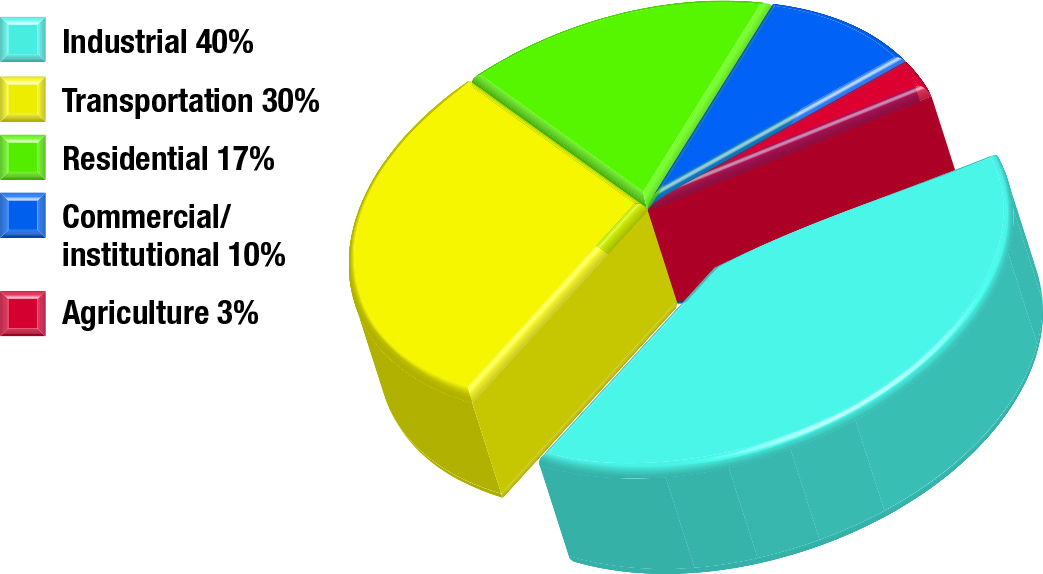
Figure 2.1 Secondary energy use by sector, 2013
Text version
Figure 2.1 is a pie chart demonstrating that in 2013, the industrial sector was the largest energy user, accounting for 40% of total secondary energy use. The transportation sector was the second largest energy user at 30%, followed by the residential sector at 17%, the commercial/institutional sector at 10% and the agricultural sector at 3%.
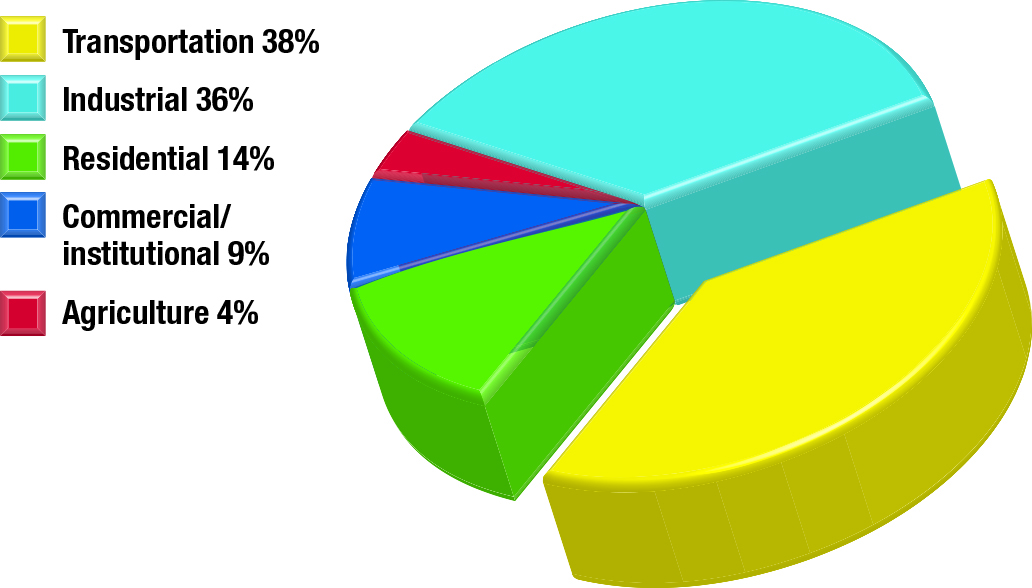
Figure 2.2 GHG emissions by sector, 2013
Text version
Figure 2.2 is a pie chart illustrating the distribution of greenhouse gas emissions by sector. The transportation sector accounted for 38% of total greenhouse gases emitted in 2013, followed by the industrial sector at 36%, the residential sector at 14%, the commercial/institutional sector at 9% and the agriculture sector at 4%.
Figures 2.1 and 2.2 show the distribution of secondary energy use and GHG emissions by sector. Energy consumed by the transportation and agriculture sectors is relatively more GHG-intensive than the other sectors.
Natural gas and electricity are the main types of end-use energy purchased in Canada.
Natural gas and electricity are used in all sectors of the economy, while motor gasoline is mainly used in the transportation and agriculture sectors. In 2013, natural gas and electricity accounted for almost half the energy used in Canada (Figure 2.3). The motor gasoline and other oil products category (diesel fuel oil, light fuel oil, kerosene, and heavy fuel oil) represented approximately 33 percent of energy usage.

Figure 2.3 Secondary energy use by fuel type, 2013
Text version
Figure 2.3 is a pie chart illustrating the distribution of secondary energy use by fuel type in 2013. The natural gas accounted for the highest share of 29% followed by the electricity 19%, other oil products including diesel fuel oil, light fuel oil, kerosene and heavy fuel oil accounted for 16%, and motor gasoline 17%.
* Other fuels include coal, coke, coke oven gas, liquefied petroleum gas and gas plant natural gas liquids, and waste fuels from the cement industry.
Trends – Energy use and GHG emissions
Energy use grew much more slowly than the economy, and slightly more than the population.
Between 1990 and 2013, energy use in Canada increased by 28 percent, from 6,957.1 PJ to 8,924.0 PJ (Figure 2.4). At the same time, the Canadian population grew 27.0 percent (approximately 1 percent per year) and GDP increased 71.7 percent (about 2.4 percent per year). More generally, energy use per unit of GDP declined 25 percent, but energy use on a per capita basis increased about 1 percent.
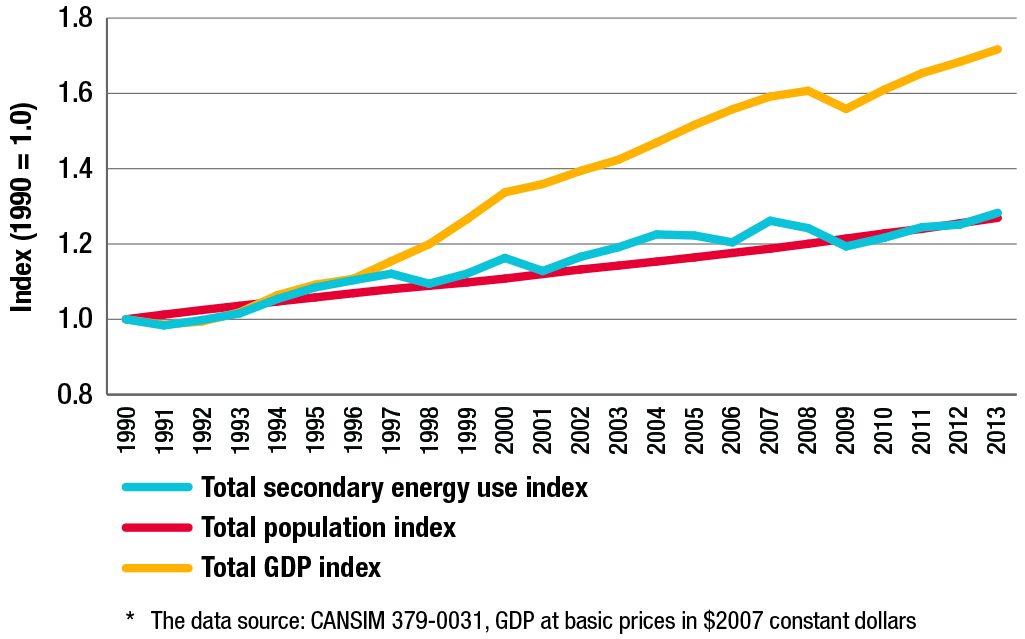
Figure 2.4 Total secondary energy use, Canadian population and GDP*, 1990–2013
Text version
Figure 2.4 is a graph with three curves each representing total secondary energy use index, total population index, and total GDP index with base year 1990. Between 1990 and 2013, the GDP index grew 71.7%, whereas the energy use grew 28% and the population growth was 27%.
Energy use has been growing at the fastest rate in the transportation sector.
The industrial sector uses the most energy in our economy, consuming 3,525.3 PJ of energy in 2013. However, energy use growth in the transportation sector outpaced all other sectors. Over 1990–2013, transportation energy use grew about 43 percent primarily due to a 78 percent growth in freight energy use.
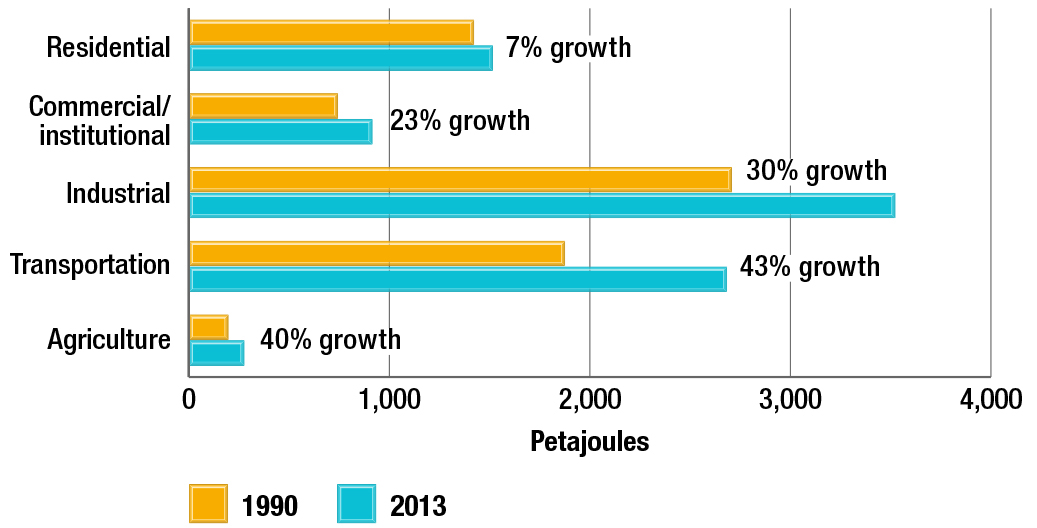
Figure 2.5 Total secondary energy use and growth rate by sector, 1990 and 2013
Text version
Figure 2.5 is a graph with horizontal bars on energy consumption by sector in 1990 and 2013. The energy consumption of residential sector increased by 7% in 2013 from1990, the commercial/institutional sector by 23%, the industrial sector by 30%, the transportation sector by 43% and the agriculture sector by 40%.
Growth in energy use was reflected in growth of GHG emissions. In 2013, Canada’s GHG emissions excluding electricity-related emissions increased 31 percent compared to 1990, while emissions including electricity-related emissions grew 21 percent. In 2013, electricity demand showed a gradual recovery from the trough of 2009, reaching close to the pre-recession peak but still 4 percent lower than the 2008 level. During this period, the fuel mix to generate electricity changed significantly. In particular, the share of coal use for electricity generation fell from 25 percent in 2008 to 18 percent in 2013. As a result, the total GHG emissions avoided from the reduction of coal use contributed to an overall decrease of GHG emissions.
The transportation sector experienced the highest growth in emissions at 40 percent followed by the agriculture sector at 37 percent (Figure 2.6).
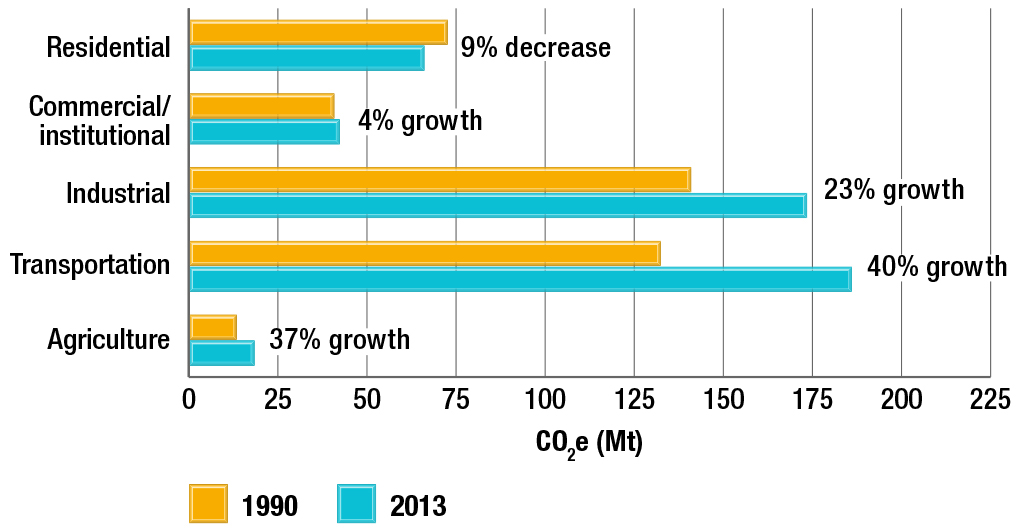
Figure 2.6 Total GHG emissions and growth by sector, 1990 and 2013
Text version
Figure 2.6 is a graph with horizontal bars on GHG emissions and growth by sector in 1990 and 2014. The GHG emission of residential sector decreased by 9% in 2013 compared to 1990, the commercial/institutional sector increased by 4%, the industrial sector by 23%, the transportation sector increased by 40%, and the agriculture sector by 37%.
The transportation sector accounted for the largest proportion, or 38 percent, of energy-related emissions (186.1 Mt CO2e), followed by the industrial sector, 36 percent (173.6 Mt CO2e), including electricity-related emissions. This difference in the shares of energy and emissions is driven by the dominance of refined petroleum products in the transportation sector providing for a more GHG-intensive energy mix.
Energy intensity and efficiency
Canada improved its energy efficiency between 1990 and 2013. The following section discusses two indicators of energy efficiency: energy intensity and an energy efficiency measure using factorization.
Energy intensity
Canada’s energy intensity improved 25 percent between 1990 and 2013, but per capita energy use increased about 1 percent.
Energy intensity, when defined as the amount of energy required per unit of activity (GDP), improved 25 percent between 1990 and 2013 (Figure 2.7). This reduction in energy intensity reflects an overall improvement in energy efficiency, which is how effectively energy is being used in producing one unit of GDP. More simply, if the economy in 2013 had produced the same level of GDP that it did in 1990, it would have used much less energy.
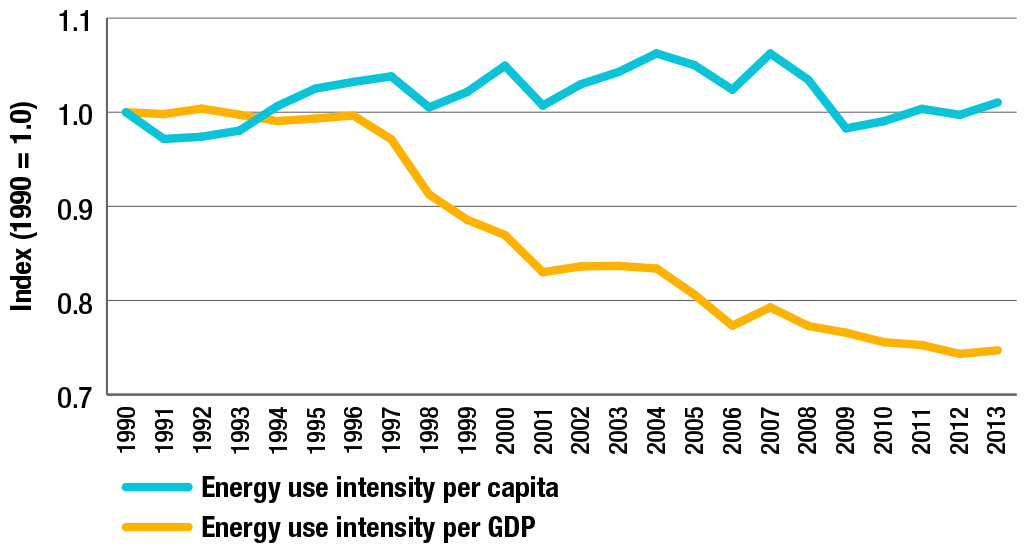
Figure 2.7 Total secondary energy use intensity per capita and unit of GDP, Index, 1990–2013
Text version
Figure 2.7 is graph with two curves each representing the index of total secondary energy use intensity per capita and the index of energy use intensity per unit of GDP from 1990 to 2013. The energy intensity per GDP improved 25.3% in 2013 compared to1990 whereas the intensity per capita showed an increase of 1% in the same period.
Similarly, the amount of energy required per capita, which is the energy intensity for each individual, increased about 1 percent between 1990 and 2013 (Figure 2.7). This upward trend in part reflects the increasing use of electronic goods, increasing ownership of passenger light trucks and increasing distance and weight of goods transported by heavy trucks. In other words, although Canada is producing economic values more efficiently, each household is using a greater number of energy-consuming goods and services per capita than in 1990. This is despite the fact that many electronic goods have become increasingly energy efficient since 1990.
Energy efficiency
Energy efficiency improved 24.2 percent since 1990. This improvement reduced energy use by approximately 1,613.2 PJ, decreased GHG emissions by 85.4 Mt and saved Canadians $37.6 billion in 2013.
One of the greatest sources of untapped energy is the energy we waste. Isolating and tracking energy efficiency in the Canadian economy is carried out in a conscious effort to publicize this energy resource. This analysis examines all areas of the economy to determine what would have happened had there been no improvements and to identify, from the underlying data, areas that can continue to improve energy efficiency.
Energy efficiency refers to how effectively energy is used to provide a certain level of service or output. To isolate the effect of energy efficiency in the economy, as well as in individual sectors, the analysis uses a factorization method. Factorization separates the changes in the amount of energy used into six effects: activity, structure, weather, service level, capacity utilization rate and energy efficiency.
- activity effect – Activity is defined differently in each sector. For example, in the residential sector, it is defined as the number of households and the floor space of residences. In the industrial sector, it is defined as industrial GDP, gross output (GO), and physical industrial output, such as tonnes of steel.
- structure effect – Structure refers to changes in the makeup of each sector. For example, in the industrial sector, a relative increase in activity in one industry over another is considered a structural change.
- weather effect – Fluctuations in weather lead to changes in heating and cooling requirements. This is measured in terms of heating and cooling degree-days. This effect is taken into account in the residential and commercial/institutional sectors, where heating and cooling account for a significant share of energy use.
- service level effect – Service level refers to the penetration rate of devices and equipment. For example, the term denotes use of auxiliary equipment in commercial/institutional buildings and appliances in homes, or the amount of cooled floor space. Although these devices are becoming more efficient, the addition of more devices would represent an increase in service levels, which has tended to offset these gains in efficiency.
- capacity utilization rate effectFootnote 5 – Capacity utilization rate refers to the proportion of the installed production capacity that is in use. For more details on capacity utilization rate, see Chapter 5 related to the industrial sector.
- energy efficiency effect – Energy efficiency refers to how effectively energy is being used, that is, using less energy to provide the same level of energy service. Energy efficiency gains occur primarily with improvements in technology or processes. An example would be insulating a home to use less energy for heating and cooling or replacing incandescent lights with fluorescent lights.
As Figure 2.8 indicates, without significant ongoing improvements in energy efficiency in end-use sectors, energy use would have increased 51 percent between 1990 and 2013 instead of 28 percent. These energy savings of 1,613.2 PJ are equivalent to the energy use of about 35.3 million cars in 2013.
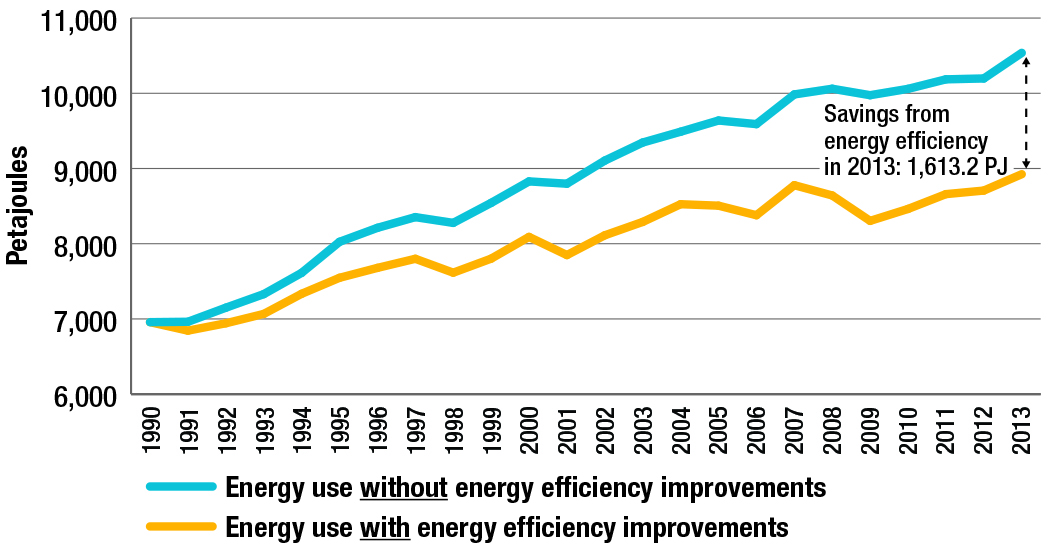
Figure 2.8 Secondary energy use, with and without energy efficiency improvements, 1990–2013
Text version
Figure 2.8 is a graph with two curves that shows energy consumption with and without improvements in energy efficiency between 1990 and 2013. The gap between the two lines represents the energy savings due to the energy efficiency improvements. The savings in 2013 were 1613.2 PJ.
Figure 2.9 illustrates the relative impact of each effect on energy use over the 1990–2013 period for the economy as a whole. The following is a summary of, and rationale for, the results:
- activity effect – Canada’s GDP grew 71.7 percent between 1990 and 2013. The overall growth in activity effect is estimated to have increased energy use by 54 percent, or 3,774.4 PJ, with a corresponding 200.2 Mt increase in GHG emissions.
- structure effect – Over the 1990–2013 period, a shift in production toward industries that are less energy-intensive resulted in a decrease of 531.2 PJ and an 18.8 Mt decrease in GHG emissions.
- weather effect – In 2013, the winter was slightly colder and the summer was hotter than that of 1990. The net result was an overall increase in energy demand for temperature control of 12.1 PJ and a 0.5 Mt increase in GHG emissions.
- service level effect – From 1990 to 2013, changes in service level (e.g. increased use of computers, printers, and photocopiers in the commercial/institutional sector) raised energy use by 162.8 PJ and increased GHG emissions by 7.3 Mt.
- capacity utilization effect – The overall lower capacity utilization rate compared to the past decade during the pre-recession period (1999–2008) resulted in 45.6 PJ of energy waste and thereby increased GHG emissions by 2.2 Mt.
- energy efficiency effect – As noted above, improvements in energy efficiency saved 1,613.2 PJ of energy and avoided 85.4 Mt of GHG emissions from 1990 to 2013.

Figure 2.9 Summary of factors influencing the change in energy use, 1990–2013
Text version
Figure 2.9 is a graph with vertical bars that indicates the impact of various factors on the change in total secondary energy consumption in Canada over the 1990 and 2013. These factors are measured by activity effect, structure effect, weather effect, service level effect, capacity utilization rate effect and energy efficiency effect. Total change in energy use (1966.8 PJ) is equal to the activity effect (3774.4 PJ) plus the structure effect (-531.2 PJ) plus the service level effect (162.8 PJ) plus the capacity utilization rate effect (45.6 PJ) plus the weather effect 12.1 PJ) plus the energy efficiency effect (-1613.2 PJ) and other (82.3 PJ).
Chapter 3: Residential sector
Over the 1990–2013 period,
- Energy efficiency in the residential sector improved 45 percent, saving Canadians 639 PJ of energy and $12 billion in energy costs in 2013.
- Residential energy use increased 6.5 percent. It would have increased 51 percent without energy efficiency improvements.
- Energy intensity per household decreased 24 percent, while energy use per square metre decreased even more at 35 percent.
Overview – Residential energy use and GHG emissions
In Canada, 83 percent of all residential energy use was for space and water heating in 2013.
In 2013, Canadians spent $28.5 billion on household energy needs. Total household energy use accounted for 17 percent of all energy used (Figure 3.1), and total household GHG emissions accounted for 14 percent of all secondary energy use-related GHGs emitted in Canada (Figure 3.2). Specifically, residential energy use was 1,517.5 PJ, emitting 66.2 Mt of GHGs.
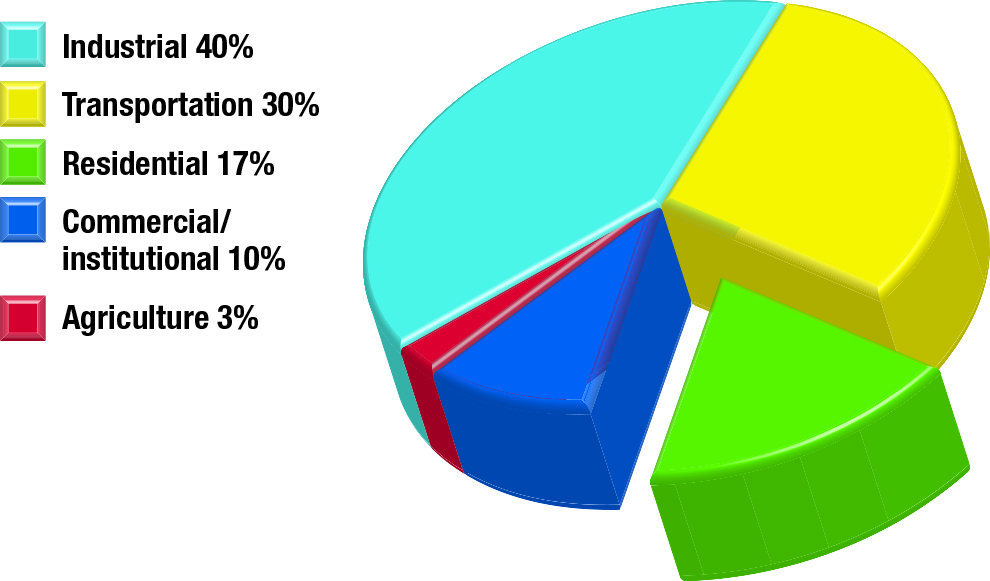
Figure 3.1 Secondary energy use by sector, 2013
Text version
Figure 3.1 is a pie chart demonstrating that in 2013, the industrial sector was the largest energy user, accounting for 40 percent of total secondary energy used. The transportation sector was the second largest energy user at 30 percent, followed by the residential sector at 17 percent, the commercial/institutional sector at 10 percent and the agricultural sector at 3 percent.

Figure 3.2 GHG emissions by sector, 2013
Text version
Figure 3.2 is a pie chart illustrating the distribution of greenhouse gas emissions by sector in percentage. The transportation sector accounted for 38% of the total greenhouse gases emitted in 2013, followed by the industrial sector at 36%, the residential sector at 14%, the commercial/institutional sector at 9% and the agriculture sector at 4%.
Natural gas, electricity, wood, heating oil and propane were the sources of energy being used. Within a household, these forms of energy were used for a variety of activities, as seen in Figure 3.3. Because of Canada’s cold climate, 63 percent of Canada’s residential energy use was for space heating in 2013. Water heating accounted for 19 percent. Appliances were also major energy users in Canadian dwellings, followed by lighting and space cooling.
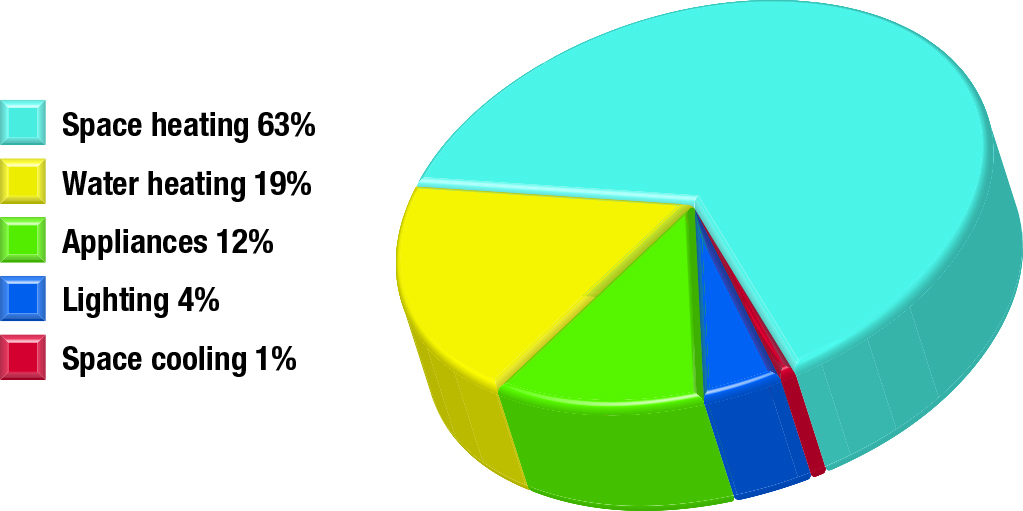
Figure 3.3 Distribution of residential energy use by end use, 2013
Text version
Figure 3.3 is a pie chart showing the distribution of residential energy use by end-use in 2013. Space heating accounted for 63% of Canada’s residential energy use, while water heating was at 19%. Appliances (12%) were also major energy users in Canadian dwellings, followed by lighting (4%) and space cooling (1%).
Trends – Residential energy use and GHG emissions
Population growth and fewer people per household led to a 40 percent rise in the number of households, which contributed to a 6.5 percent increase in residential energy use from 1990 to 2013.
The 3.9 million households added in Canada since 1990 is approximately the same as the total households of Quebec, New Brunswick, and Newfoundland and Labrador in 2013.
Between 1990 and 2013, the population grew 27 percent (7.5 million people) and the number of households increased 40 percent (3.9 million). The rise in the number of households, combined with increased average living space and the higher penetration rate of appliances, contributed to the increase of 6.5 percent, or 93 PJ, in residential energy use from 1,424.5 PJ to 1,517.5 PJ. As homeowners gradually switched to cleaner energy sources, the associated GHG emissions decreased 9 percent, from 72.8 Mt to 66.2 Mt during the period.
The mix of energy used in the residential sector changed slightly over the period. Specifically, natural gas and electricity became even more dominant, while wood and heating oil use declined.
Figure 3.4 illustrates the fuel mix used in this sector. Natural gas and electricity together accounted for 82.5 percent of all residential energy use in 2013, compared to 70 percent in 1990, while heating oil saw its share decrease from 13 percent to 5 percent over the period. The increase in natural gas and electricity share largely reflected the increased availability of natural gas and lower natural gas prices relative to oil. It was also in part the result of relatively higher efficiency ratings for gas and electric furnaces.

Figure 3.4 Residential energy use by fuel type and number of households, 1990 and 2013
Text version
Figure 3.4 is a graph with vertical bars that illustrates the residential energy use by fuel type (showed by vertical bars) and the number of households in Canada (showed by a curve) in 1990 and 2013. Natural gas and electricity became even more dominant while heating oil use declined. The number of households in Canada increased from 9.9 million to 13.8 million.
Canadians have bigger homes with fewer people living in them.
The choices Canadians made with respect to their living space also contributed to an increase in energy use. Average living space per household in 2013 was 17 percent greater than it was in 1990. Specifically, average occupied living space in 1990 was 122 square metres (m2) compared to 142 m2 of living space in 2013 (Figure 3.5). At the same time, the number of individuals per household fell to 2.5 in 2013 from 2.8 in 1990. This trend, coupled with population growth, has meant more dwellings built and therefore more energy consumed.
Since 1990, Canadians use more devices that consume energy. In addition, more Canadians choose to cool their homes during the summer months due to warmer weather and higher income earnings. These choices increased residential energy use. The impact of these changes and the choices made by Canadians are further discussed in the following section, where each end use is examined.
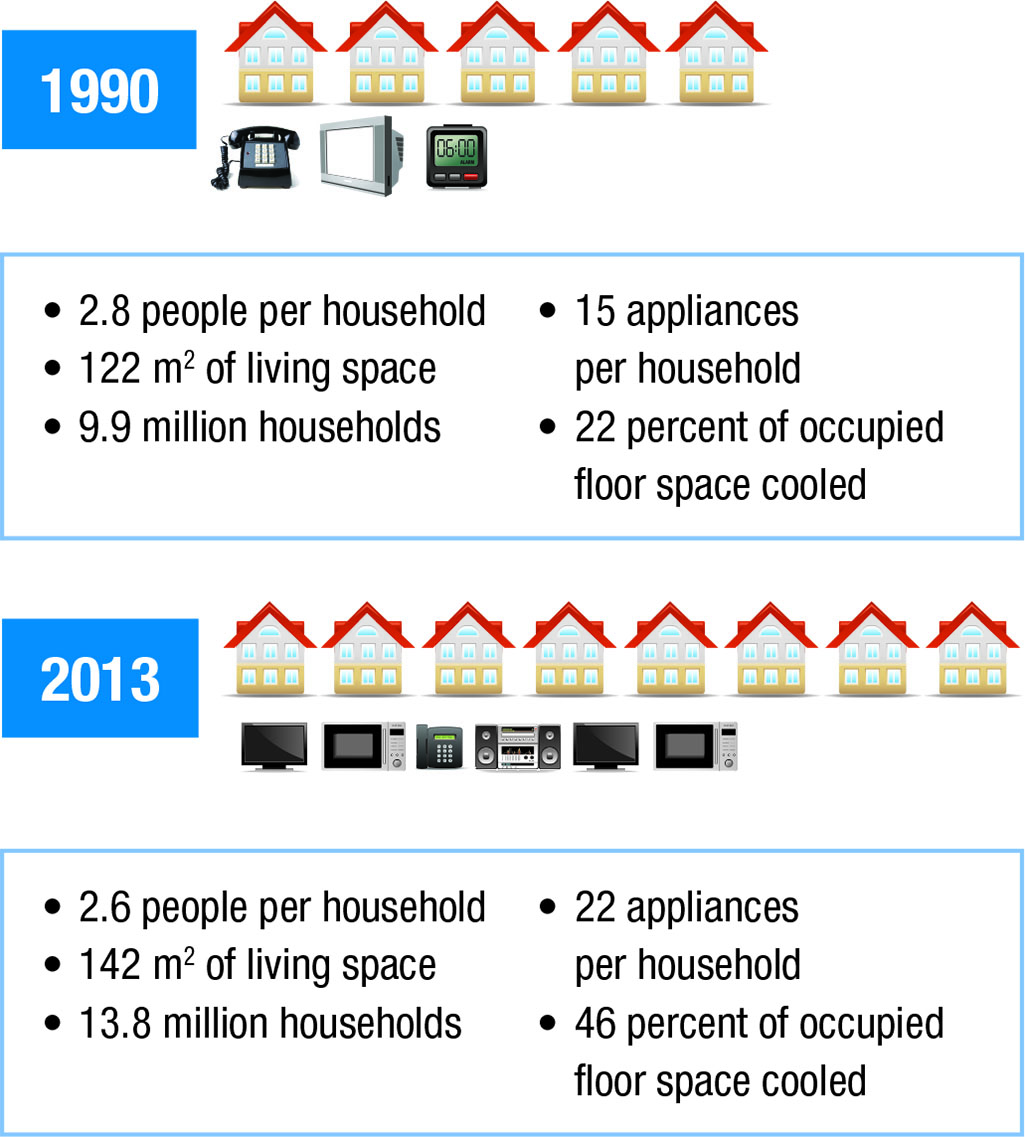
Figure 3.5 Residential energy indicators, 1990 and 2013
Text version
Figure 3.5 is a chart that compares residential energy indicators in 1990 and 2013. Average living space in 2013 was 16 percent greater than in 1990. Average occupied living space in 1990 was 122 square metres compared to 142 square metres in 2013. The number of individuals per household fell to 2.6 in 2013 from 2.8 in 1990.
Trends – Residential space heating energy use
Despite a 38.5 percent decline in space heating energy intensity (GJ/m2), total space heating energy use increased 0.3 percent between 1990 and 2013.
Two thirds (67 percent) of residential energy demand in 1990 came from space heating; the proportion declined to 63 percent in 2013, as consumers shifted toward the installation of medium- and high-efficiency furnaces.
The amount of energy used by the residential sector to heat each square metre of living space decreased significantly between 1990 and 2013. The decrease in space heating intensity from 0.79 gigajoules per square metre (GJ/m2) to 0.49 GJ/m2 (Figure 3.6) was driven mainly by energy efficiency gains.
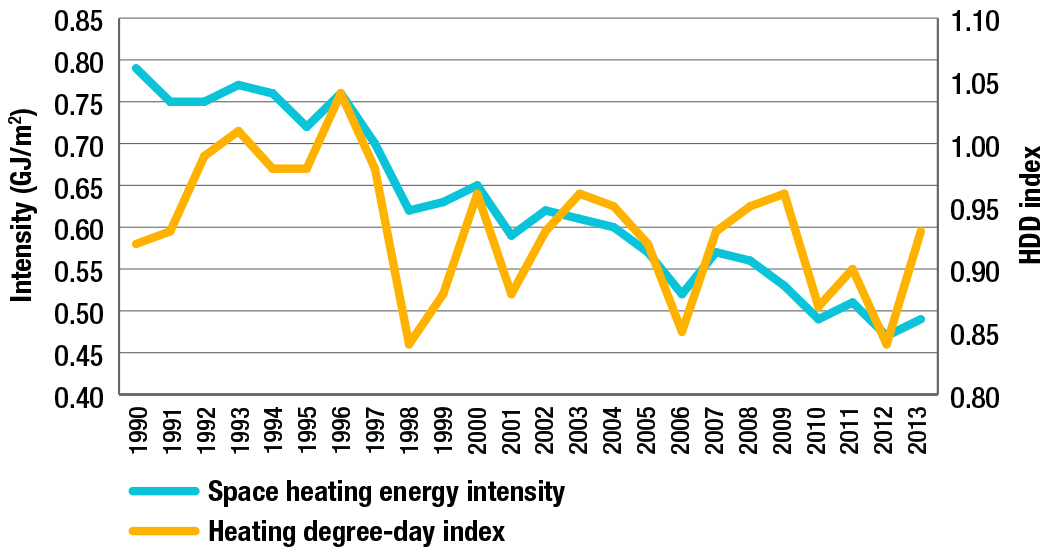
Figure 3.6 Space heating energy intensity and heating degree-day index, 1990–2013
Text version
Figure 3.6 is a graph with two lines that shows the indexes of space heating energy intensity and heating degree day index between 1990 and 2013.
Energy efficiency gains were achieved, to a large extent, by the replacement of less efficient systems with regulated medium- and high-efficiency systems. From 1990 to 2013, the proportion of high-efficiency gas furnaces installed in Canadian houses climbed from 3 to 29 percent of the whole heating system market. In the early 90s, medium-efficiency oil heating systems were rarely installed in the residential sector (only 2 percent of the market share), whereas by 2013, almost all oil heating systems installed (98 percent) were medium-efficiency.
Even though space heating intensity decreased 38.5 percent during the period, this was not enough to compensate for the fact that the number of households increased 40 percent. Additionally, the average Canadian home was larger in 2013 than it was in 1990 (Figure 3.5). Consequently, the energy required to heat all the dwellings in Canada increased 0.3 percent from 957.5 PJ in 1990 to 960.3 PJ in 2013, which accounted for approximately 63 percent of all residential energy use.
Trends – Residential water heating energy use
Less energy is required per household for hot water due to increased penetration of newer and more efficient natural gas water heaters and a decline in household size.
More Canadians shifted from using oil-fired water heaters to those that use natural gas and that are, on average, more energy-efficient (Figure 3.7). In addition, current minimum energy performance standards mean that new water heaters use less energy than older models. As older stock is replaced by new stock, energy efficiency gains are achieved. These changes, combined with a decrease in household size, resulted in a 9 percent decrease in the energy used per household for heating water (from 23.3 GJ per household in 1990 to 21.3 GJ per household in 2013).
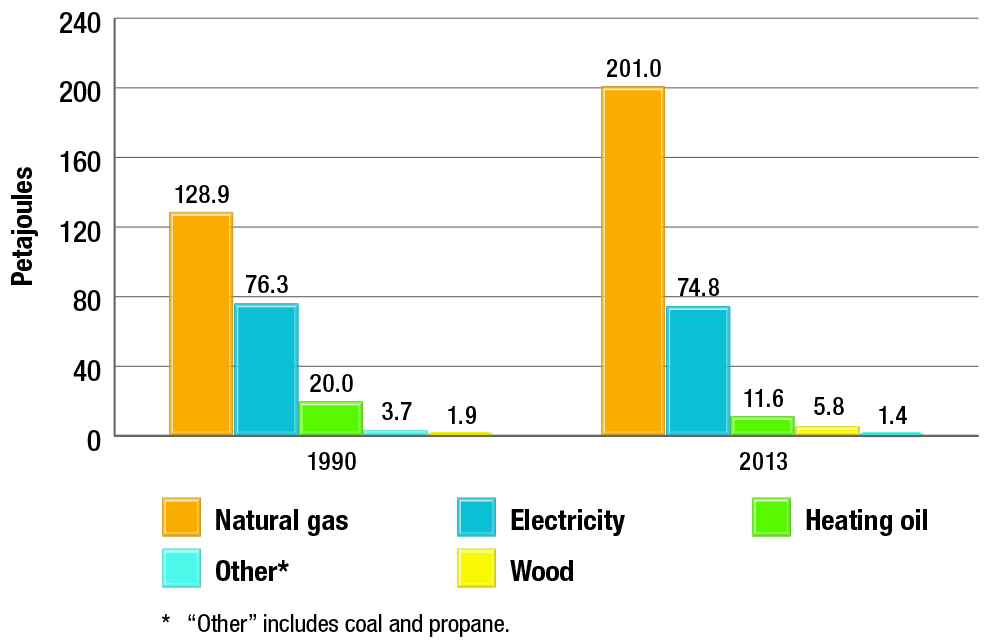
Figure 3.7 Water heating energy use by fuel type, 1990 and 2013
Text version
Figure 3.7 is a chart with vertical bars on water heating energy use by fuel type in 1990 and 2013. More Canadians shifted from using oil-fired water heaters to those that use natural gas.
Although there was a decrease in per-household energy used to heat water, the total number of households grew more quickly than energy efficiency improvements from new equipment. The result was an overall increase of 28 percent in residential water heating energy use, from 230.8 PJ to 294.6 PJ. In 2013, 19 percent of the residential energy demand was used for water heating.
Trends – Residential appliance energy use
Energy efficiency gains of major appliances improved significantly; on average, a new dishwasher purchased in 2013 was three times more efficient than a unit produced in 1990, while a new refrigerator sold in 2013 required only half of the energy consumed by a 1990 model.
The increased number of minor appliances offset the benefits of the energy efficiency gains of major appliances.
The number of major appliances operated in Canada between 1990 and 2013 increased 53 percent (Figure 3.8). However, the total amount of energy that households used to power major appliances decreased 26 percent over the same period due to energy efficiency improvements. In fact, the average unit energy use of all major household appliances decreased noticeably from 1990 to 2013.
The largest percentage decrease for new major electric appliances was in the unit energy use of clothes washers (Figure 3.9), which in 2013 used 72 percent less energy than in 1990 (from 134 kilowatt hours per year [kWh/yr] to 37 kWh/yr).Footnote 6 A new fridge in 1990 used an average of 956 kWh/yr versus 416 kWh/yr in 2013, a decrease of 56 percent. These improvements in efficiency were due mainly to the introduction of minimum efficiency standards in the 1990s.
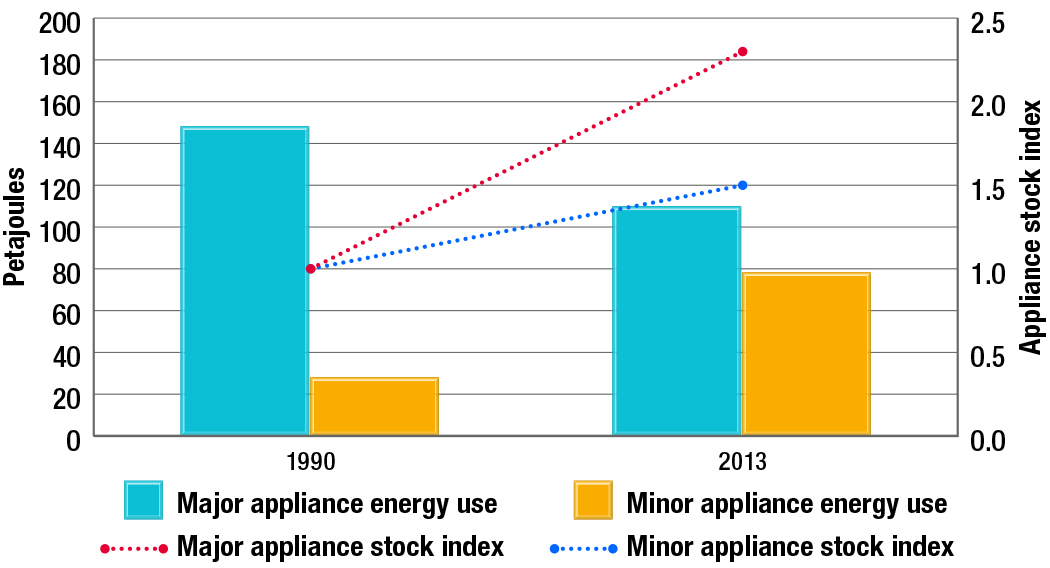
Figure 3.8 Residential energy use and appliance stock index by appliance type, 1990 and 2013
Text version
Figure 3.8 is a chart with vertical bars that shows residential energy use and appliance stock index by appliance type in 1990 and 2013. The number of major appliances operated in Canada between 1990 and 2013 increased 53 percent. However, the total amount of energy that households used to power major appliances decreased 26 percent over the same period due to energy efficiency improvements.
Energy use for powering all household minor appliances more than doubled between 1990 and 2013. This increase of 50.3 PJ was equivalent to the energy required to power 28 million new refrigerators in 2013.
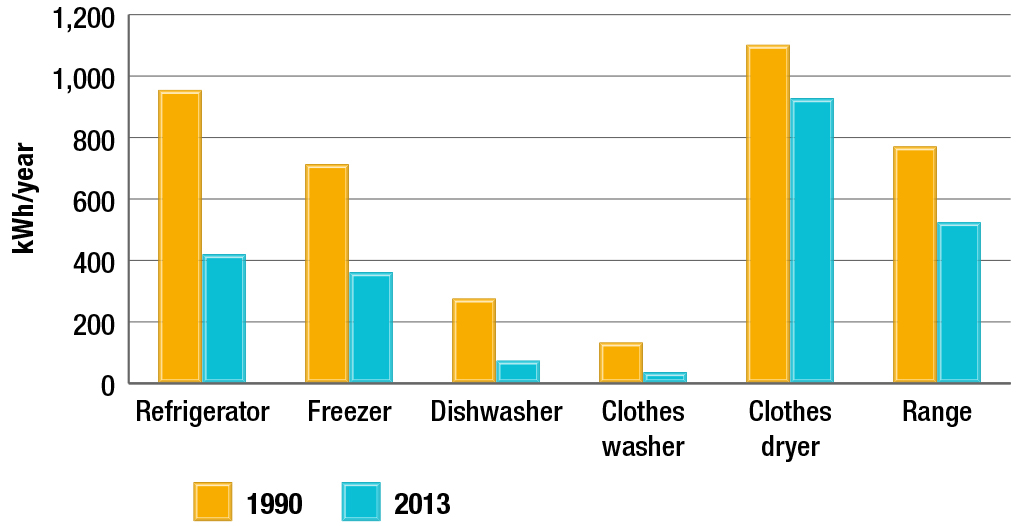
Figure 3.9 Unit energy consumption for new major electric appliances, 1990 and 2013
Text version
Figure 3.9 is a chart with vertical bars that illustrates unit energy consumption for new major electric appliances in 1990 and 2013. Compared to other major appliances, clothes washers saw the largest decline in unit energy use (-72%).
In contrast to trends for major appliances, energy use for smaller appliances such as televisions, VCRs, DVDs, stereo systems and personal computers more than doubled (+178 percent). This increase more than outweighed the energy use reduction from major appliances. One example of the rapid growth in minor appliances is the increased penetration of cell phones. In 1990, cell phones were present in one out of 56 households, but by 2013, each household owned more than one cell phone on average. Furthermore, the rapid penetration of digital TVs, DVDs, digital cable boxes, personal computers, and particularly video game consoles (from less than 4,000 in 1990 to 8 million in 2013) also contributed to the increase.
Trends – Space cooling energy use
More Canadians lived in larger and air-conditioned homes.
The amount of occupied floor space with air conditioners tripled in 2013 to 906 million m2, from 268 million m2 in 1990. The percentage of occupied floor space cooled rose from 22 percent in 1990 to 46 percent in 2013. Because of that and the fact that the summer in 2013 was much hotter than that in 1990, the energy required to cool Canadian homes rose 95 percent (Figure 3.10), from 10 PJ to 19 PJ over the same period.
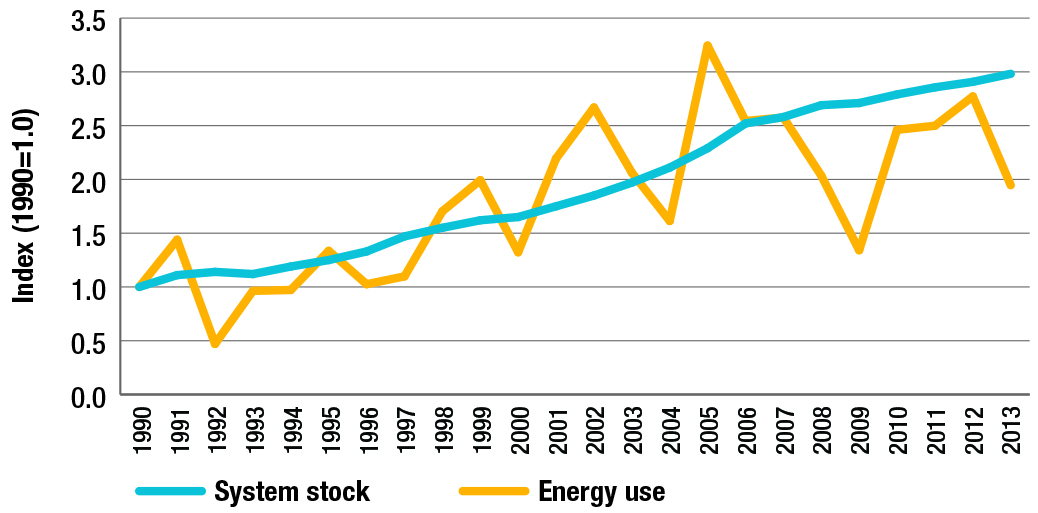
Figure 3.10 Space cooling system stock and energy use, 1990-2013
Text version
Figure 3.10 is a graph with two lines illustrating the indexes of space cooling system stock and energy use with 1990 = 1. Energy required to cool Canadian homes rose 95% between 1990 and 2013.
The increase in energy used for space cooling would have been more profound if not for efficiency improvements associated with room and central air conditioners. Compared to 1990, the stock of room and central air conditioners in 2013 were 61 and 34 percent more efficient, respectively.
Trends – Lighting energy use
The market share of energy-efficient lighting alternatives increased significantly between 1990 and 2013.
Despite a drop in lighting energy use per household, the energy required to light all the households in Canada increased 10 percent, from 49.5 PJ to 54.5 PJ (Figure 3.11). This was entirely due to the 37 percent increase in the number of households, as the energy required to light each household in Canada decreased 19 percent, from 5.0 GJ to 3.9 GJ.

Figure 3.11 Lighting energy use per household and total lighting energy use, 1990–2013
Text version
Figure 3.11 is a graph with two lines showing lighting energy use per household and total lighting energy use between 1990 and 2013. Total lighting energy use increased 10% from 49.5 PJ to 54.5 PJ while lighting energy use per household decreased 19% from 5.0 GJ to 3.9 GJ.
Some of the decrease in lighting energy use per household can be associated with the increased use of compact fluorescent lights (CFLs) and light-emitting diode (LED) lights, which use less energy to produce a certain level of light. The use of LEDs (excluding LED holiday lights) was zero percent in 2007, and it surged to 14 percent in 2013 (Figure 3.12). CFL and LED bulbs are 75 percent to 80 percent more energy-efficient and have 10 to 25 times longer in-service life than traditional incandescent bulbs.

Figure 3.12 Penetration of energy saving lights by bulb type 2007 and 2013
Text version
Figure 3.12 is a chart with vertical bars demonstrating the number of light bulbs per household by bulb type in 1990 and 2013. As illustrated in the chart, the use of compact fluorescent lamps (CFLs) increased considerably, while the use of incandescent bulbs declined.
Residential energy intensity and efficiency
Energy intensity
The average household has reduced its energy use by 24 percent since 1990.
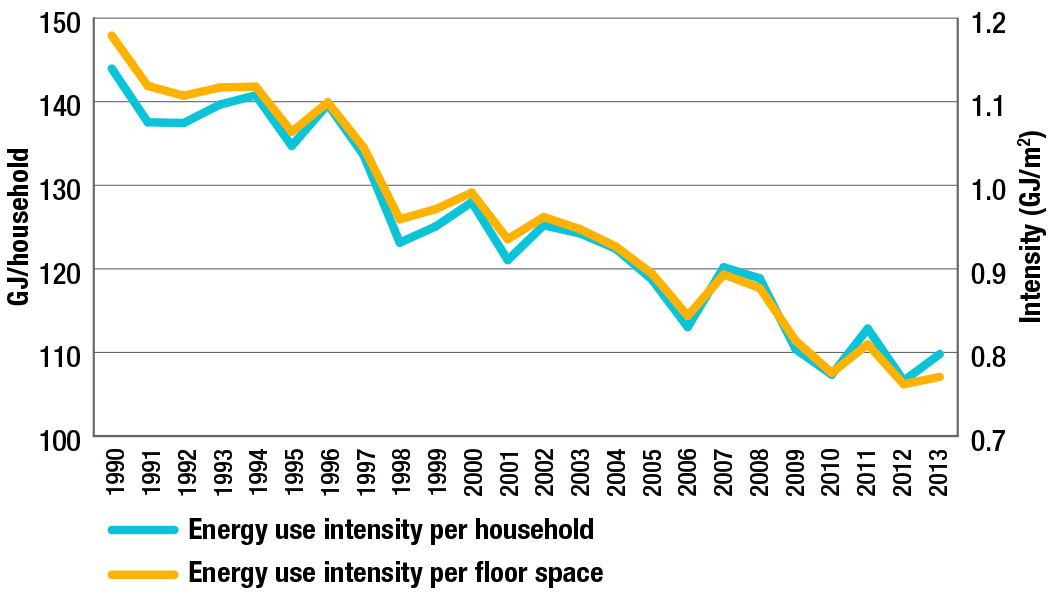
Figure 3.13 Residential energy intensity per household and floor space, 1990–2013
Text version
Figure 3.13 is a graph with two lines showing residential energy use per household (GJ/household) and per floor space (GJ/m2) from 1990 to 2013. Energy use per household decreased from 144 GJ in 1990 to 110 GJ in 2013, while energy use per square metre decreased from 1.18 GJ to 0.77 GJ.
In the residential sector, energy intensity is usually expressed as energy consumed per household. It can also be expressed as energy consumed per square metre of house area. Energy intensity decreased 24 percent, from 144 GJ per household in 1990 to 110 GJ in 2013 (Figure 3.13). This occurred despite the average household operating more appliances, its living space becoming larger and its use of space cooling increasing. Energy use per square metre decreased even more, from 1.18 GJ to 0.77 GJ, or 35 percent.
Energy efficiency
Energy efficiency improvements resulted in energy savings of $12 billion in the residential sector in 2013.
Energy efficiency improvements in the residential sector have resulted in significant savings between 1990 and 2013. These improvements include changes to the residential thermal envelope (insulation, windows, etc.) and changes to the efficiency of energy-consuming items in the home, such as furnaces, appliances, lighting and air conditioning.
Energy efficiency in the residential sector improved 45 percent from 1990 to 2013, allowing Canadians to save 639 PJ of energy (Figure 3.14) and $12 billion in energy costs in 2013.
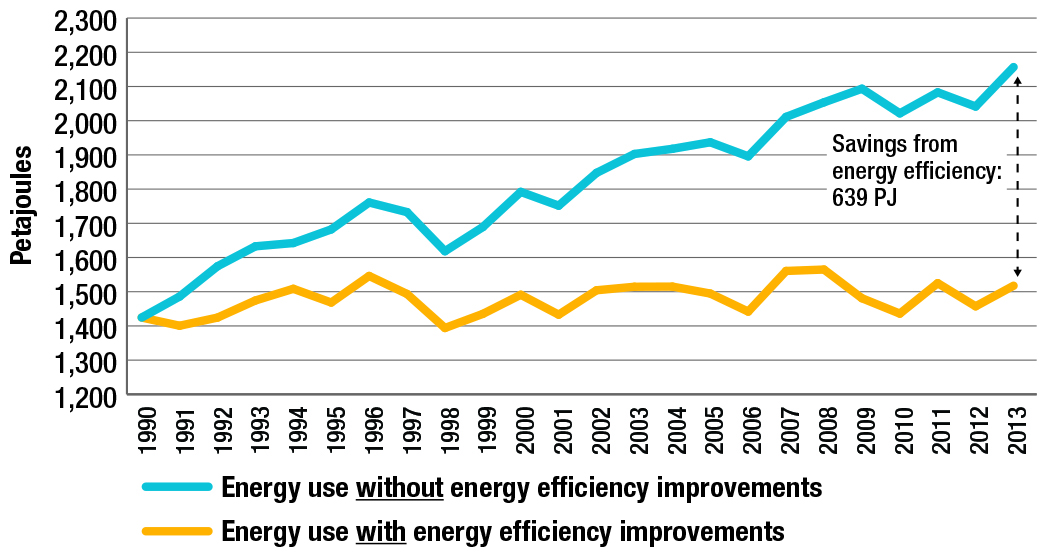
Figure 3.14 Residential energy use, with and without energy efficiency improvements, 1990–2013
Text version
Figure 3.14 is a graph with two lines that shows the change in residential energy use between 1990 and 2013, actual and without energy efficiency improvements. Energy efficiency in the residential sector improved 45% from 1990 to 2013, allowing Canadians to save 639 PJ of energy in 2013.
These energy efficiency savings translated into an average savings of $869 per Canadian household in 2013.
Figure 3.15 illustrates the influence that various factors had on the change in residential energy use between 1990 and 2013. These effects are as follows:
- activity effect – As measured by combining a mix of households and floor space, energy use increased 45 percent (644 PJ) and GHG emissions increased 30 Mt. Growth in activity was driven by a 63 percent increase in floor area and a 40 percent rise in the number of households.
- structure effect – The decrease in the relative share of single-family houses resulted in the sector using 1.6 PJ less energy and avoiding 0.06 Mt of GHGs.
- weather effect – In 2013, the winter was slightly colder and the summer was hotter than in 1990. The net result was an overall increase in energy demand of 11 PJ and 0.6 Mt more GHGs.
- service level effect – The increased penetration rate of appliances and the increased floor space cooled by space cooling units were responsible for 79 PJ of the increase in energy and a 3.7 Mt increase in GHGs.
- energy efficiency effect – Improvements to the thermal envelope of houses and to the efficiency of residential appliances and space and water heating equipment led to an overall energy efficiency gain in the residential sector. This saved 639 PJ of energy and 27 Mt of GHG emissions.

Figure 3.15 Impact of activity, structure, service level, weather and energy efficiency on the change in residential energy use, 1990–2013
Text version
Figure 3.15 is a graph with vertical bars showing the impact of that indicates the impact of various factors on the change in residential energy use between 1990 and 2013. These factors are measured by activity effect, structure effect, weather effect, service level effect and energy efficiency effect. Total change in energy use (93 PJ) is equal to the activity effect (644 PJ) plus the structure effect (-1.6 PJ) plus the weather effect (11 PJ) plus service level effect (79 PJ) plus the energy efficiency effect (-639 PJ).
Chapter 4: Commercial/institutional sector
Over the 1990–2013 period,
- Energy efficiency in the commercial/institutional sector improved 33 percent, saving Canadians 241.8 PJ of energy and $5.4 billion in energy costs in 2013.
- Commercial/institutional energy use increased 23 percent. It would have increased 55 percent without energy efficiency improvements.
- Energy intensity (GJ/m²) decreased 15 percent.
Note: In 2014, Statistics Canada revised the amount of electricity used in the commercial/institutional sector. This revision affects the 2013 data with a backcast to 1990. This edition reflects the revisions made by Statistics Canada. Consequently, the energy breakdown will be slightly different from the previous editions.
Overview – Commercial/institutional energy use and GHG emissions
In 2013, the commercial/institutional sector was responsible for 10 percent of the total energy used in Canada, ranking it as the fourth largest energy consumer after the residential sector, which consumed 17 percent (see Figure 4.1). To provide services to Canadians, commercial business owners and institutions spent more than $20.6 billion on energy. In terms of GHGs, this sector was responsible for 9 percent of the total emissions produced in Canada in 2013 (see Figure 4.2).
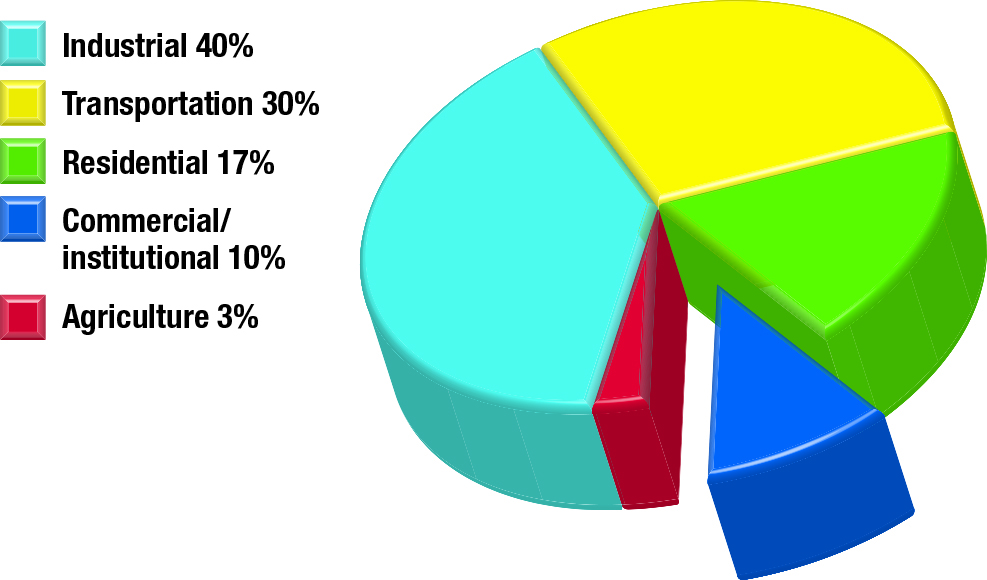
Figure 4.1 Secondary energy use by sector, 2013
Text version
Figure 4.1 is a pie chart demonstrating that in 2013, the industrial sector was the largest energy user, accounting for 40 percent of total secondary energy used. The transportation sector was the second largest energy user at 30 percent, followed by the residential sector at 17 percent, the commercial/institutional sector at 10 percent and the agricultural sector at 3 percent.
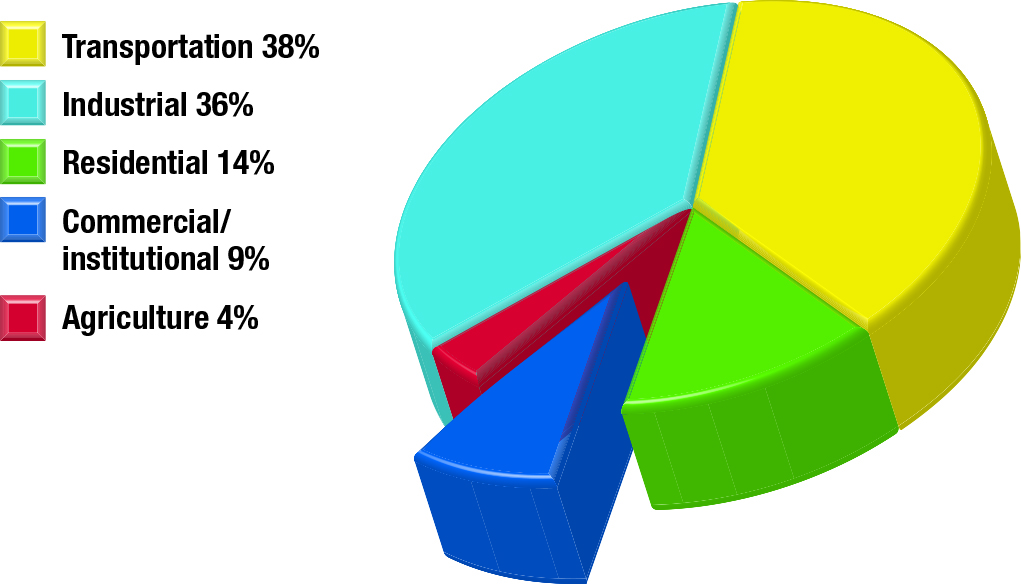
Figure 4.2 GHG emissions by sector, 2013
Text version
Figure 4.2 is a pie chart illustrating the distribution of greenhouse gas emissions by sector. The transportation sector accounted for 38 percent of the total greenhouse gases emitted in 2013, followed by the industrial sector at 36 percent, the residential sector at 14 percent, the commercial/institutional sector at 9 percent and the agriculture sector at 4 percent.
In the commercial/institutionalFootnote 7 sector, energy is used for various purposes, such as space heating, cooling, lighting and water heating, as well as for operating auxiliary equipment (such as computers and medical equipment) and auxiliary motors. Space heating accounts for the largest share of energy use, about 55 percent, followed by auxiliary equipment at 14 percent (Figure 4.3). Street lighting is included in total energy but it is excluded from the factorization analysis because it is not associated with floor space activity.
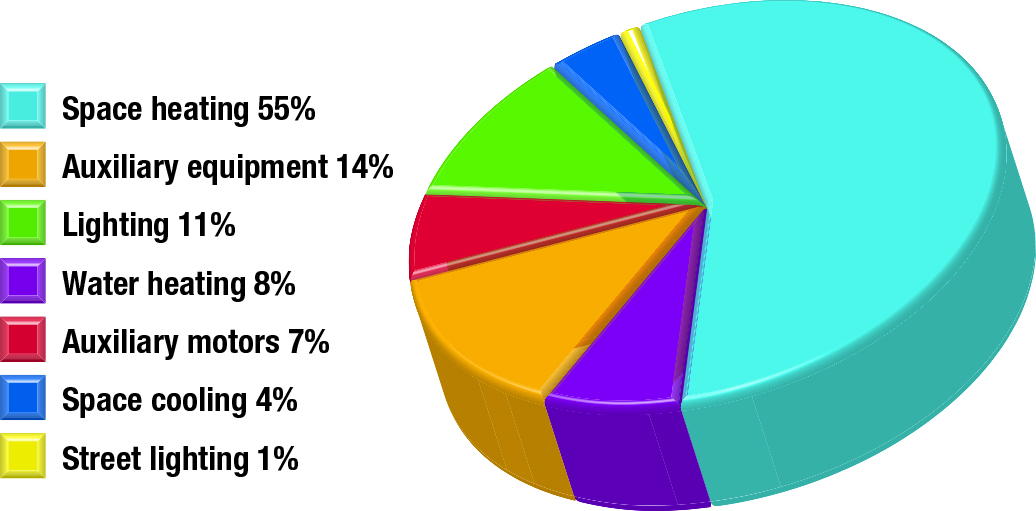
Figure 4.3 Commercial/institutional energy use by end use, 2013
Text version
Figure 4.3 is a pie chart illustrating energy use by end-use in the commercial/institutional sector in 2013. The chart shows that energy is used for different purposes in the sector, such as space heating (55%), cooling (4%), lighting (11%), water heating (8%), as well as for operating auxiliary equipment (14%) and motors (7%). Street lighting accounted for 1% of total energy use.
The commercial/institutional sector includes activities related to trade, finance, real estate, public administration, educational and commercial services. These activities have been grouped into 10 subsectors (see Figure 4.4 for a complete list of activities).
Offices, retail trade and educational services account for about 71 percent of the total Canadian commercial/ institutional floor space, which was estimated at 743.1 million m² in 2013.
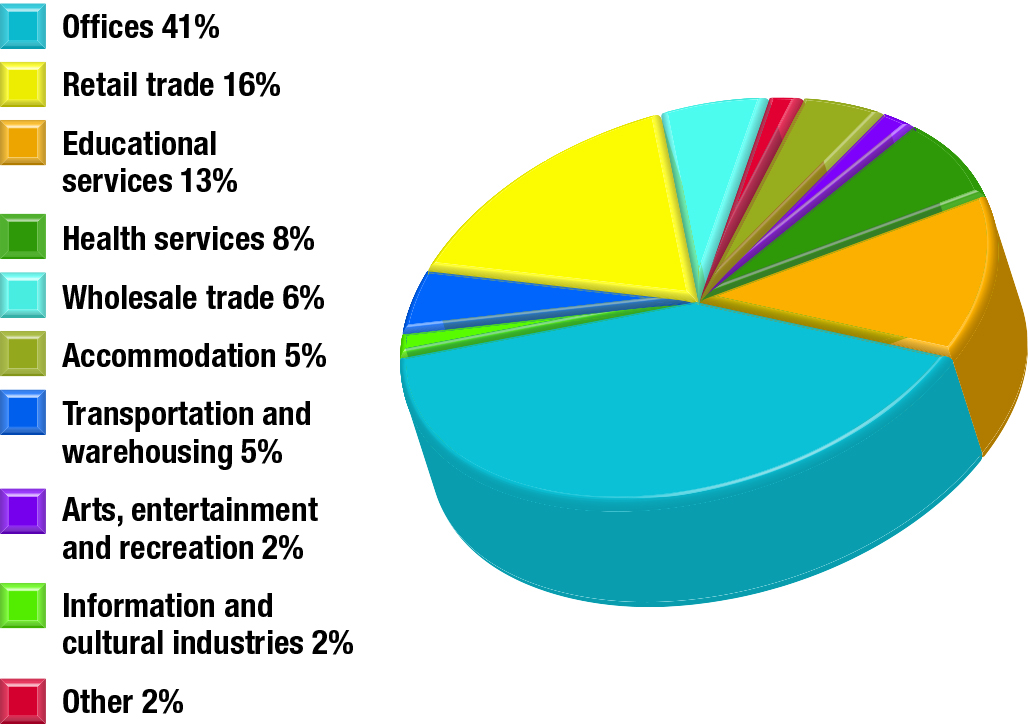
Figure 4.4 Commercial/institutional floor space by activity type, 2013
Text version
Figure 4.4 is a pie chart illustrating the distribution of the floor space by activity type, in 2013. The distribution of the floor space is showed as follows: offices account for 41 percent, retail trade for 16 percent, educational services for 13 percent, health care and social assistance for 8 percent, wholesale trade for 6 percent,, accommodation and food services for 5 percent, transportation and warehousing for 5 percent, Arts, entertainment and recreation for 2 percent, information and cultural industries for 2 percent and other services for 2 percent.
Trends – Commercial/institutional energy use and GHG emissions
In 2013, the total amount of energy used in the commercial/institutional sector equaled about 60 percent of the amount used by the residential sector, but usage grew three times faster than it did in the residential sector between 1990 and 2013.
From 1990 to 2013, total commercial/institutional energy use increased 23 percent, from 745.6 PJ to 917.1 PJ, including street lighting. At the same time, GDP for the commercial/institutional sector grew 89 percent and floor space grew approximately 46 percent. The GHG emissions associated with the sector’s energy use, including electricity-related emissions, increased about 4 percent over the same period.
Natural gas and electricity are the main energy sources used in the commercial/institutional sector (see Figure 4.5), accounting for about 54 and 39 percent of this sector’s total energy use, respectively. Electricity is the primary energy source for lighting, space cooling, and auxiliary motors and equipment. Natural gas and the remaining fuels are the primary energy sources for space and water heating. However, natural gas and propane are also used, in smaller proportions, to provide energy for auxiliary equipment, such as propane-powered stoves and natural gas-fired space cooling.
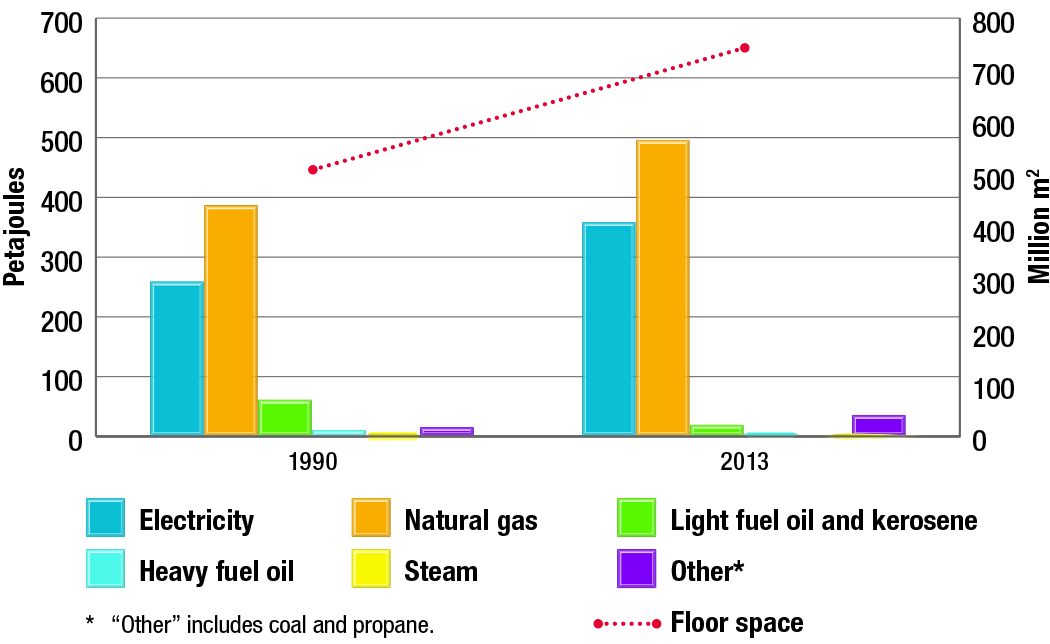
Figure 4.5 Commercial/institutional energy use by fuel type and floor space, 1990 and 2013
Text version
Figure 4.5 is a graph with vertical bars that illustrates the Commercial/institutional energy use by fuel type (showed by vertical bars) and floor space (showed by a curve) in 1990 and 2013. The growth is consistent with the overall increase in commercial/institutional floor space in Canada. The floor space increased from 510 million square meters in 1990 to 743 million square meters in 2013.
The rapid expansion of new technologies increased the use of electronic equipment in all commercial/institutional subsector activities in Canada since 1990.
As shown in Figure 4.6, seven end uses were responsible for the growth in commercial/ institutional energy use. This growth is consistent with the overall increase in commercial/institutional floor space in Canada, except for street lighting, which does not relate to floor space activity. Space heating continues to be the primary end use in the sector, while auxiliary equipment use drove the main part, or 45 percent, of the total increase in energy use. Auxiliary equipment has shown a large increase in energy requirement (141 percent) resulting, in part, from the increasing computerization of all work spaces related to commercial/institutional activities (Figure 4.6).
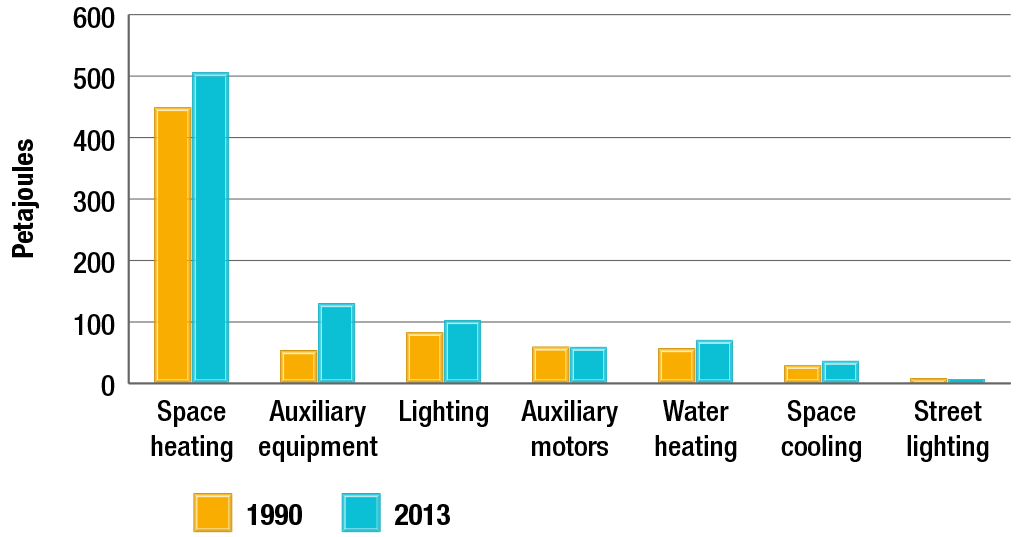
Figure 4.6 Commercial/institutional energy use by end use, 1990 and 2013
Text version
Figure 4.6 is a graph with vertical bars that illustrates the Commercial/institutional energy use by fuel type (showed by vertical bars) and floor space (showed by a curve) in 1990 and 2013. Seven end-uses were responsible for the growth in commercial/institutional energy use: Space heating used 450 PJ in 1990 and 507 PJ in 2013. Space cooling 30 PJ in 1990 and 37 PJ in 2013, Lighting 84 PJ in 1990 and 103 PJ in 2013, Water heating 58 PJ in 1990 and 71 PJ in 2013, auxiliary equipment 54 PJ in 1990 and 131 PJ in 2013, auxiliary motors 60 PJ in 1990 and 60 PJ in 2013 and street lighting 8.9 PJ in 1990 and 7.3 PJ in 2013.
Office activities drove about half of the increase in demand for energy in Canada’s commercial/ institutional sector.
As shown in Figure 4.7, the office subsector accounted for the largest share of energy use in 2013 (35 percent). This subsector includes public administration and activities related to finance and insurance; real estate and rental and leasing; professional, scientific and technical services; and other offices. Retail trade (17 percent) and educational services (13 percent) were the next largest users.
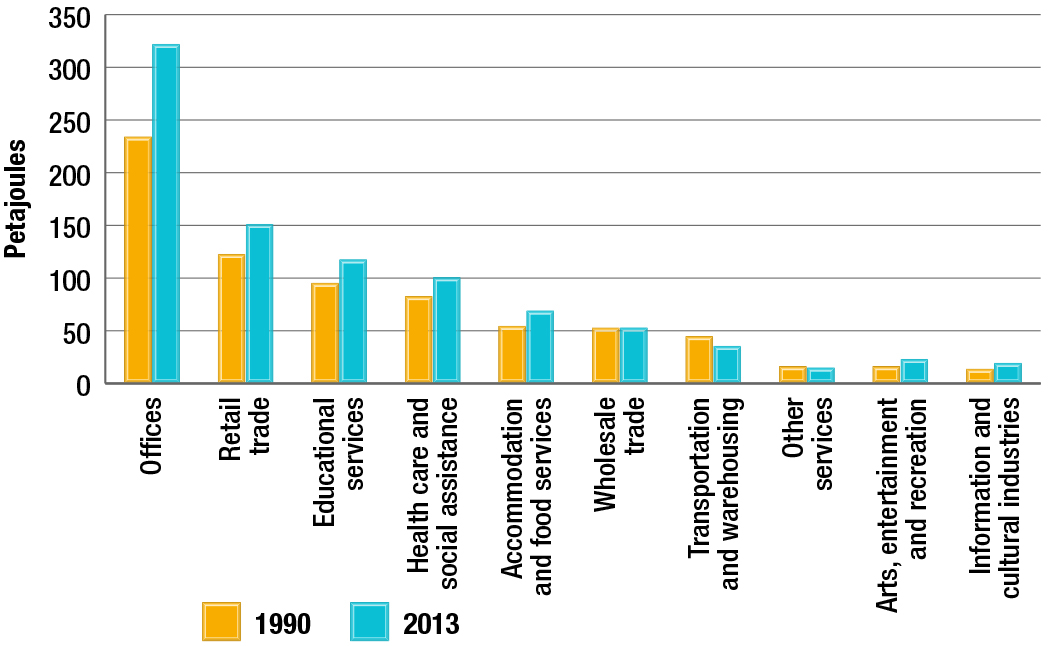
Figure 4.7 Commercial/institutional energy use by activity type, 1990 and 2013
Text version
Figure 4.7 is a graph with horizontal bars that shows the Commercial/institutional energy use by activity type in 1990 and 2013. The growth in energy use in the sector can be explained by mainly 10 activities : offices used 234.5 PJ in 1990 and 322.4 PJ in 2013, retail trade 123.0 PJ in 1990 and 151.5 PJ in 2013, educational services 95.7 PJ in 1990 and 117.9 PJ in 2013, health care and social assistance 83.0 PJ in 1990 and 100.9 PJ in 2013, accommodation and food services 54.9 PJ in 1990 and 69.4 PJ in 2013, wholesale trade 53.2 PJ in 1990 and 53.2 PJ in 2013, transportation and warehousing 45.1 PJ in 1990 and 35.9 PJ in 2013, arts, entertainment and recreation 16.5 PJ in 1990 and 23.4 PJ in 2013, information and cultural industries 14.2 PJ in 1990 and 19.8 PJ in 2013 and other services 16.5 PJ in 1990 and 15.3 PJ in 2013.
Thirteen million people worked in Canada’s commercial/institutional sector in 2013.Footnote 8
Several indicators can help explain the growth in energy use in the commercial/institutional sector, including floor space, GDP and the number of employees (Figure 4.8).
While some gains in energy efficiency were made in terms of overall energy use per floor space, this was offset by an increase in energy requirements for auxiliary equipment. There was not only an overall increase in computerization of the work environment in this sector during this period, but also an increase in the actual number of devices required per employee.

Figure 4.8 Commercial/institutional energy indicators, 1990 and 2013
Text version
Figure 4.8 is an illustration of energy indicators for Commercial/institutional in 1990 and in 2013. It shows an increase in floor space from 510 million square meters in 1990 to 743 million square meters in 2013, an increase of employees from 9 million in 1990 to 13 millions in 2013 and an increase of GDP from $557 billion ($2007) in 1990 to $1052 billion ($2007) in 2013.
Commercial/institutional energy intensity and efficiency
Energy intensity
Accommodation and food services is the most energy-intensive commercial/institutional activity.
In the commercial/institutional sector, energy intensity refers to the amount of energy used per unit of floor space (GJ/m²).
As shown in Figure 4.9, accommodation and food services consumed 1.85 GJ/m² in 2013, followed by health care and social assistance activities, which consumed 1.81 GJ/m². They are the most energy-intensive activity types despite a 17 and 18 percent decrease, respectively, in the energy intensity of these subsectors. This high energy intensity may be attributable to the energy-demanding nature of their activities (restaurants, laundry) and services (extensive hours of operation), as well as the use of new technologies, which translates into the proliferation of the amount of electronic equipment.
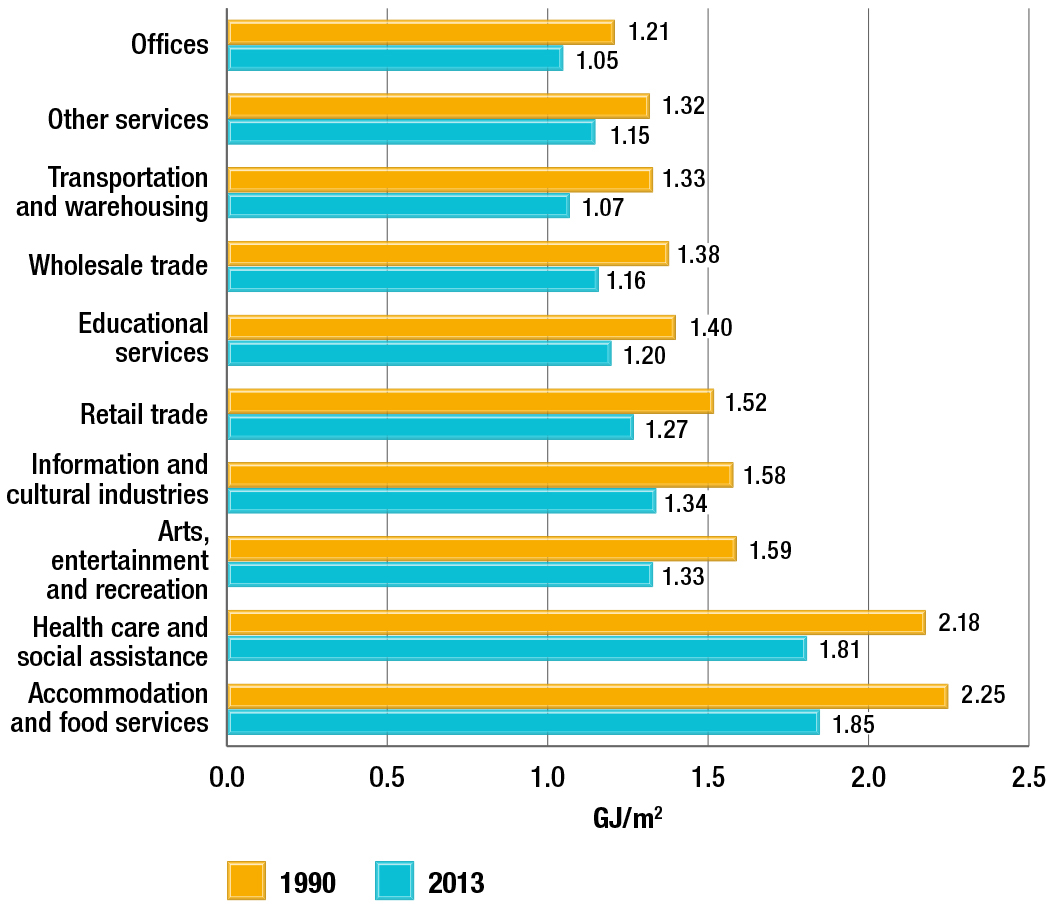
Figure 4.9 Commercial/institutional energy intensity by activity type, 1990 and 2013
Text version
Figure 4.9 is a graph with horizontal bars that shows the Commercial/institutional energy intensity by activity type in 1990 and 2013. The energy intensity is illustrated in 10 activity sectors per unit of floor space (GJ/m2): office intensity was 1.2 in 1990 and 1.1 in 2013, retail trade 1.5 in 1990 and 1.3 in 2013, educational services 1.4 in 1990 and 1.2 in 2013, health care and social assistance 2.2 in 1990 and 1.8 in 2013, accommodation and food services 2.3 in 1990 and 1.9 in 2013, wholesale trade 1.4 in 1990 and 1.2 in 2013, transportation and warehousing 1.3 in 1990 and 1.1 in 2013, arts, entertainment and recreation 1.6 in 1990 and 1.3 in 2013, information and cultural industries 1.6 in 1990 and 1.3 in 2013 and other services 1.3 in 1990 and 1.2 in 2013.
The commercial/institutional sector as a whole experienced a 15 percent decrease in energy intensity in terms of energy consumed per unit of floor space (GJ/m²). However, the sector reduced its energy intensity by 35 percent when measured against economic activity (PJ/$GDP).
Energy efficiency
Energy efficiency improvements in Canada have resulted in energy savings of $5.4 billion in the commercial/institutional sector since 1990.
Energy efficiency improvements in the commercial/institutional sector were very similar to those in the residential sector. They include changes to the thermal envelope of buildings (insulation, windows, etc.) and increased efficiency of various energy-consuming items in commercial/institutional buildings such as furnaces, auxiliary equipment and lighting. This sector’s energy efficiency improved 33 percent from 1990 to 2013 and resulted in an energy savings of 241.8 PJ, or $5.4 billion, in 2013 (Figure 4.10).
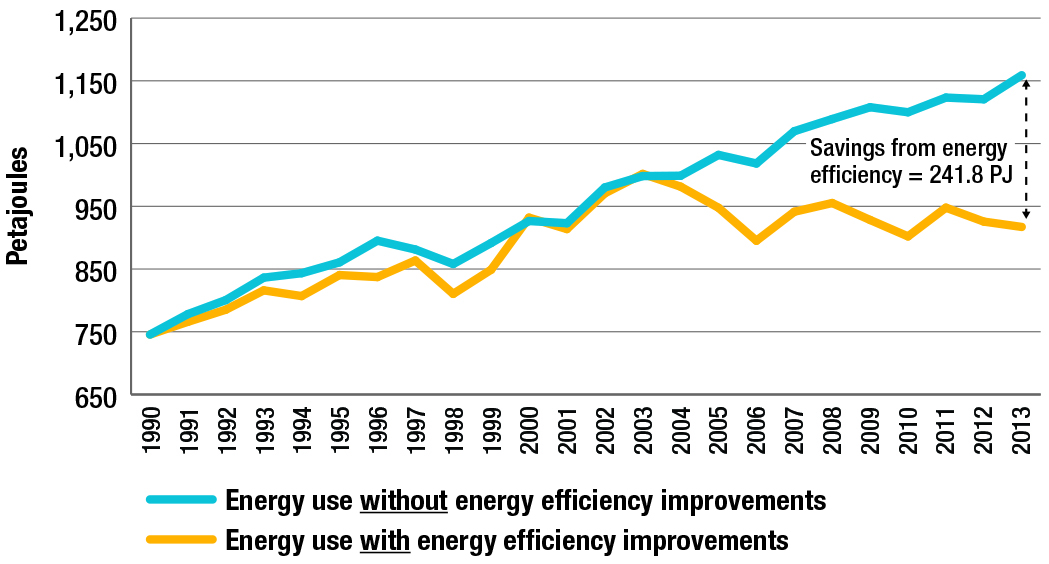
Figure 4.10 Commercial/institutional energy use, with and without energy efficiency improvements, 1990–2013
Text version
Figure 4.10 is a graph with two curves that shows energy consumption for Commercial/institutional, with and without improvements in energy efficiency between 1990 and 2013. The graph illustrates a growing energy saving that reached 241.8 PJ in 2013.
Figure 4.11 illustrates the influence that various factors had on the change in commercial/institutional sector energy use between 1990 and 2013. These effects are as follows:
- activity effect – A 43 percent increase in floor space led to a 329.3 PJ growth in energy use and a 15.2 Mt increase in GHG emissions.
- structure effect – The effect of structure changes in the sector (the mix of activity types) was small and therefore had a marginal effect on energy use and GHG emissions.
- weather effect – In 2013, the winter was slightly colder and the summer was hotter than in 1990. The net result was an increase of 1.6 PJ in energy demand and 0.1 Mt in GHG emissions.
- service level effect – An increase in the service level of auxiliary equipment, such as the penetration rate of office equipment (e.g. computers, fax machines and photocopiers), led to an 83.6 PJ increase in energy use and a 3.9 Mt increase in GHG emissions.
- energy efficiency effect – The 33 percent improvement in energy efficiency saved 241.8 PJ of energy and 11.2 Mt of GHG emissions.
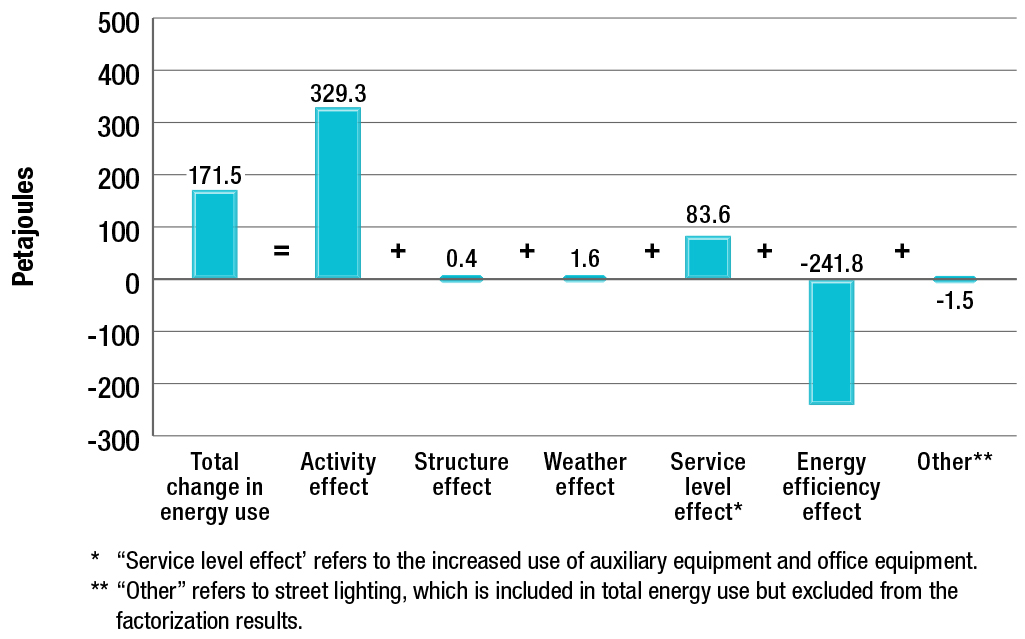
Figure 4.11 Impact of activity, structure, weather, service level and energy efficiency on the change in commercial/ institutional energy use, 1990–2013
Text version
Figure 4.11 is a graph with vertical bars that indicates the impact of various factors on the change in commercial/institutional energy use between 1990 and 2013. These factors are measured by the activity effect, the structure effect, weather effect, service level effect and Energy efficiency effect. Total change in energy use (171.5 PJ) is equal to activity effect (329.3 PJ) plus structure effect (0.4 PJ) plus weather effect (1.6 PJ) plus service level effect (83.6 PJ) plus energy efficiency effect (-241.8 PJ) + other (-1.5 PJ). Other refers to street lighting, which is included in total energy use but excluded from the factorization results.
Chapter 5: Industrial sector
Over the 1990–2013,
- Canadian industry saved $3.0 billion in energy costs due to an 8.1 percent energy efficiency improvement, saving 220.1 PJ.
- Industrial energy use increased 30 percent. It would have increased 38 percent without energy efficiency improvements.
- Energy intensity (MJ/$2007 – GDP) decreased 9 percent.
Overview – Industrial energy use and GHG emissions
The industrial sector used the most energy of any sector in Canada but had fewer GHG emissions than the transportation sector.
The industrial sector includes all manufacturing, mining, forestry and construction activities. In 2013 alone, these industries spent $47.6 billion for energy. Total energy use by industry accounted for 40 percent of the total energy use (Figure 5.1) and 36 percent of end-use GHG emissions (Figure 5.2).
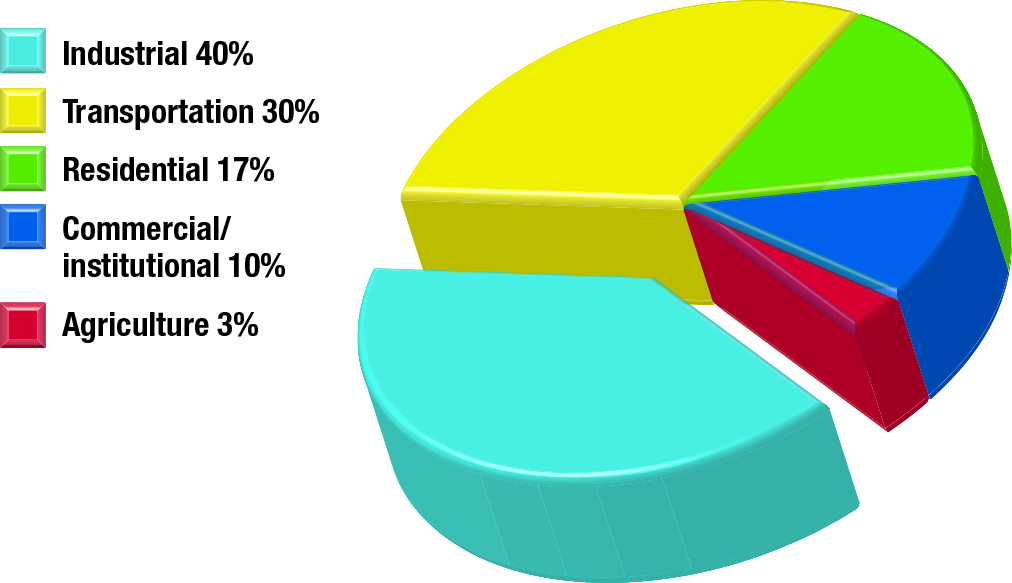
Figure 5.1 Secondary energy use by sector, 2013
Text version
Figure 5.1 is a pie chart demonstrating that in 2013, the industrial sector was the largest energy user, accounting for 40 percent of total secondary energy use. The transportation sector was the second largest energy user at 30 percent, followed by the residential sector at 17 percent, the commercial/institutional sector at 10 percent and the agricultural sector at 3 percent.
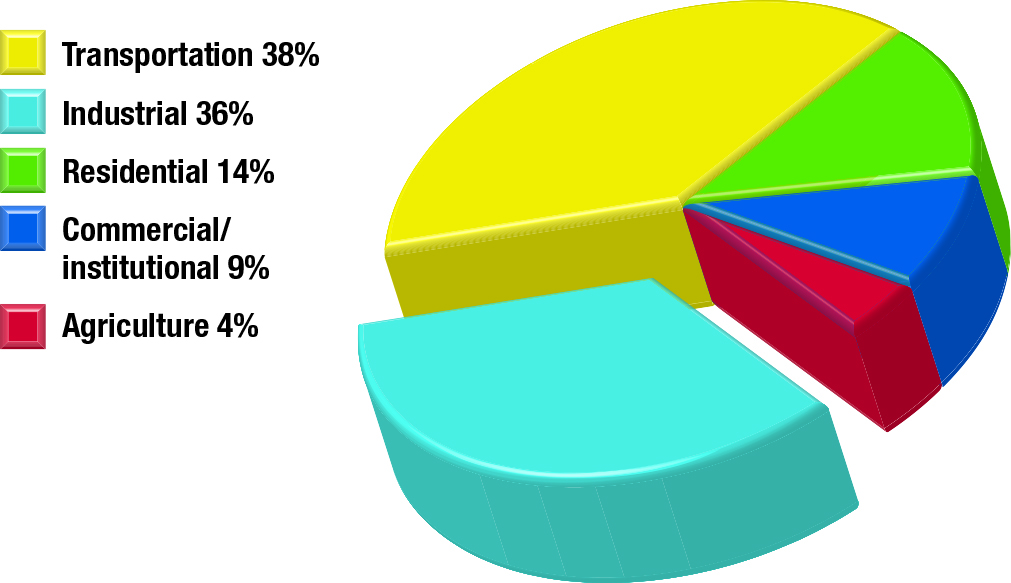
Figure 5.2 GHG emissions by sector, 2013
Text version
Figure 5.2 is a pie chart illustrating the distribution of greenhouse gas emissions by sector. The transportation sector accounted for 38 percent of total greenhouse gases emitted in 2013, followed by the industrial sector at 36 percent, the residential sector at 14 percent, the commercial/institutional sector at 9 percent and the agriculture sector at 4 percent.
The energy use of an industry is not necessarily proportional to its level of economic activity.
In 2013, the industrial sector’s share of GDP accounted for 26 percent of the Canadian total (excluding agriculture). The main contributor to industrial GDP was “other manufacturing,” which includes the food and beverage, textile, computer and electronic industries, among others. Construction and mining were the only other two industries that contributed more than 10 percent to the industrial sector’s GDP (see Figure 5.3).
Although GDP is an indicator of economic activity, a notable characteristic of the industrial sector is that the industries with the highest activity level do not necessarily use the most energy. For example, the pulp and paper industry is responsible for 16.4 percent of industrial energy use but only 1.7 percent of economic activity. In contrast, an industry such as construction is responsible for 27.4 percent of the economic activity but only 2.3 percent of industrial energy use (see Figure 5.3).
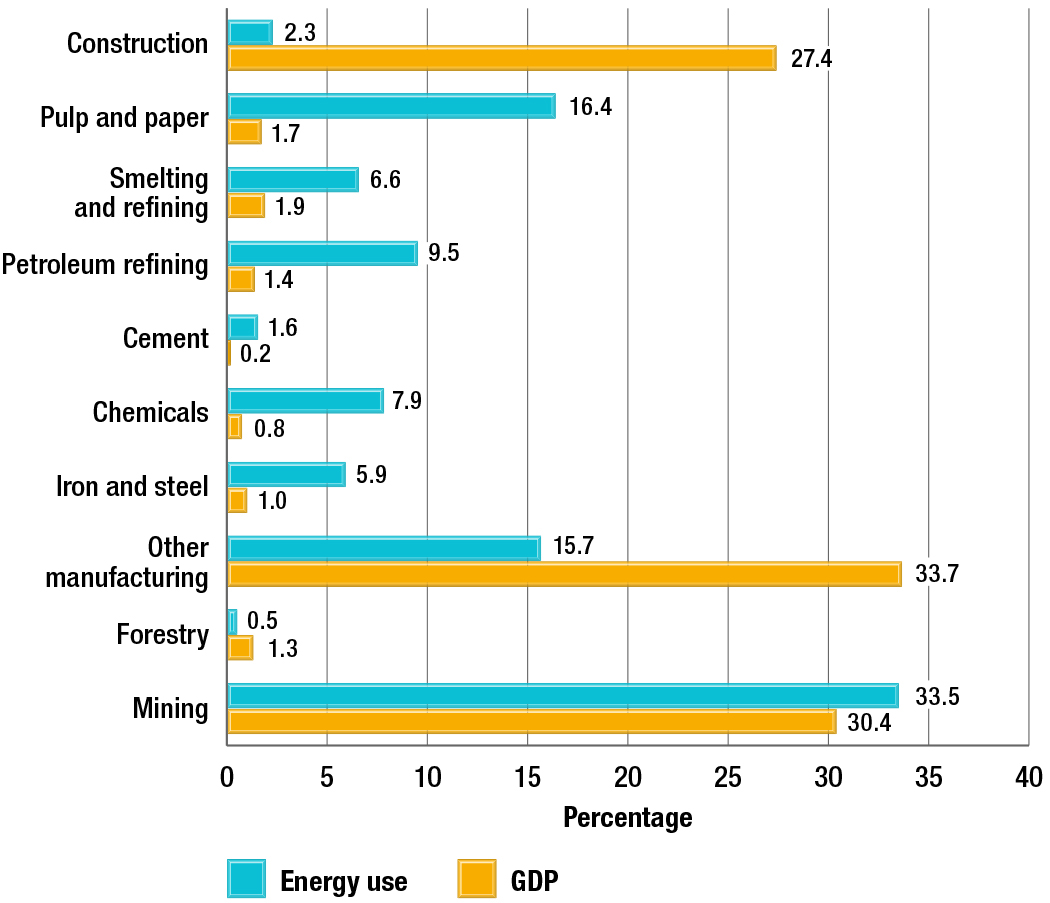
Figure 5.3 Distribution of energy use and activity by industry, 2013
Text version
Figure 5.3 is a graph with horizontal bars showing the distribution of energy use and activity by industry in 2013 (percent). The pulp and paper industry is responsible for 16 percent of industrial energy use, but only 1.7 percent of economic activity. In contrast, an industry such as construction is responsible for 27 percent of the economic activity, but only 2.3 percent of industrial energy use.
Variation of fuel use by industry
In the industrial sector, energy is used primarily to produce heat, to generate steam or as a source of motive power. For example, coal is one of the types of energy used by the cement industry to heat cement kilns. Many other industries use natural gas to fuel boilers for steam generation and electricity to power motors for pumps and fans.
Natural gas and electricity were the main fuels used in the industrial sector in 2013, meeting 38 percent and 21 percent, respectively, of the sector’s energy needs. Wood waste and pulping liquor (12 percent) and still gas and petroleum coke (14 percent) were the other most used fuel types.
Wood waste and pulping liquor are primarily used in the pulp and paper industry because they are recycled materials produced only by this industry. However, some of the electricity produced from these materials is sold to other industries.
Trends – Industrial energy use and GHG emissions
From 1990 to 2013, industrial energy use increased 30 percent, from 2,710.0 PJ to 3,525.3 PJ. The associated end-use GHGs increased 23 percent, from 141.1 Mt to 173.6 Mt. GDP increased 44 percent from $285 billion ($2007) in 1990 to $409 billion ($2007) in 2013 (Figure 5.4).
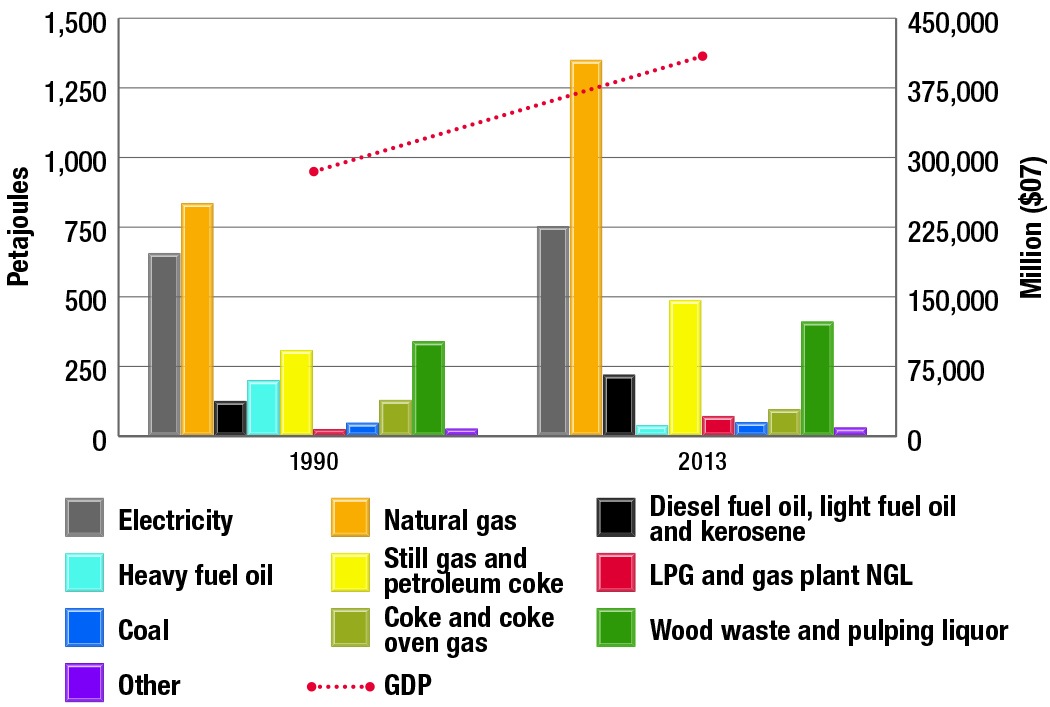
Figure 5.4 Industrial energy use by fuel type and GDP, 1990 and 2013
Text version
Figure 5.4 is a graph with vertical bars showing industrial energy use by fuel type and GDP, 1990 and 2013. GDP increased 44 percent from $285 billion ($2007) in 1990 to $409 billion ($2007) in 2013. The fuel shares remained relatively constant in most cases.
In most cases, fuel shares remained relatively constant between 1990 and 2013 as fuel consumption increased for most fuel types during this period. The exceptions were heavy fuel oil (HFO), which experienced an 84 percent decrease, and coke and coke oven gas, which decreased 43 percent.
One reason for the decline in use of HFO was that the pulp and paper industry, the largest user of HFO, adopted alternate forms of fuels such as pulping liquor. Fuel switching was facilitated by the use of interruptible contracts, with energy suppliers allowing the industry to react to changes in relative fuel prices.
Forestry, mining, and smelting and refining have all experienced strong growth in energy use since 1990. However, forestry consumes proportionately less energy than mining and smelting and refining. The trends for these main contributors to energy demand are now described in greater detail, along with the trends for the pulp and paper industry and other manufacturing.
Trends – Mining energy use and GHG emissions
The mining industry comprises industries engaged in oil and gas extraction, coal mining, metal ore mining, non-metallic mineral mining, quarrying, and support activities for mining and oil and gas extraction.Footnote 9
Since 1990, the mining industry’s energy consumption and its associated end-use emissions have both more than tripled. The GDP of the mining industry increased 50 percent over the 1990–2013 period, from $83 billion ($2007) to $125 billion ($2007), compared to a 44 percent increase for the entire industrial sector.
Upstream mining was the biggest contributor to mining’s GDP, representing 85 percent ($106 billion) in 2013. Activity in the oil sands was the main driver in the increase in energy demand from the mining industries.
Upstream mining includes oil sands mining operations. Since the late 1990s, production from non-conventional resources (oil sands) increased. Driven by technological advances, which have lowered production costs, and by additional revenue from higher crude oil prices, investment in oil sands projects has become much more attractive.
The production of bitumen and synthetic crude oil in 1985 was 35,000 cubic metres per day (m3/day). It reached 71,000 m3/day by 1996 and climbed to 308,000 m3/day by 2013. This increase is the principal factor explaining the 396 percent increase in the energy used by the upstream mining industry since 1990 (Figure 5.5).
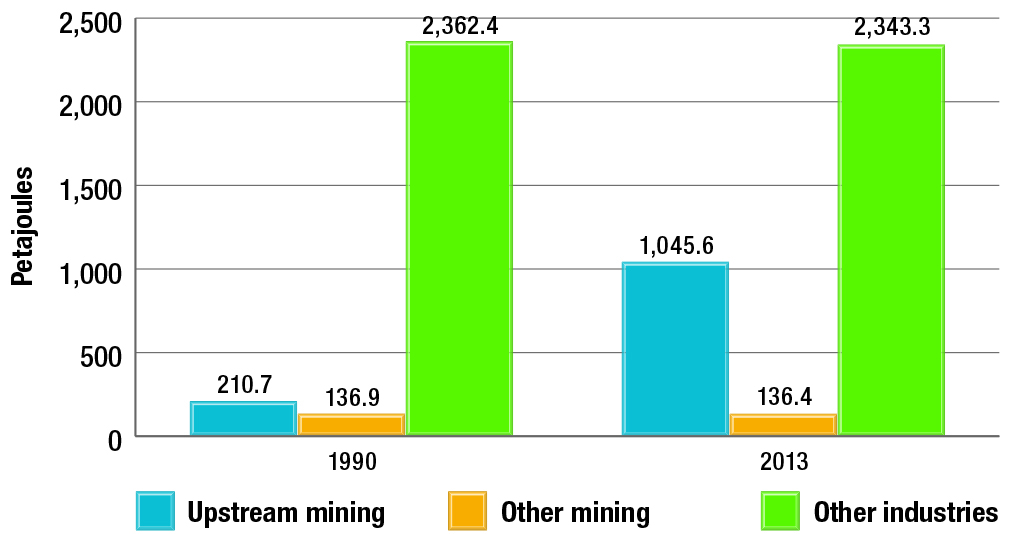
Figure 5.5 Industrial energy use by selected industry, 1990 and 2013
Text version
The production of bitumen and synthetic crude oil in 1985 was 35,000 cubic metres per day (m3/day). It reached 71,000 m3/day by 1996 and climbed to 308,000 m3/day by 2013. This increase is the principal factor explaining the increase of 396 percent in the energy used by the upstream mining industry since 1990.
Trends – Smelting and refining energy use and GHG emissions
The smelting and refining industries are primarily engaged in the production of aluminum, nickel, copper, zinc, lead and magnesium.
The smelting and refining subsector is the third largest contributor to growth in energy demand. This was mainly driven by economic growth, as the GDP increased from $3.8 billion ($2007) in 1990 to $7.9 billion ($2007) in 2013 – a 106 percent increase. During the same period, associated GHG emissions fell 7 percent.
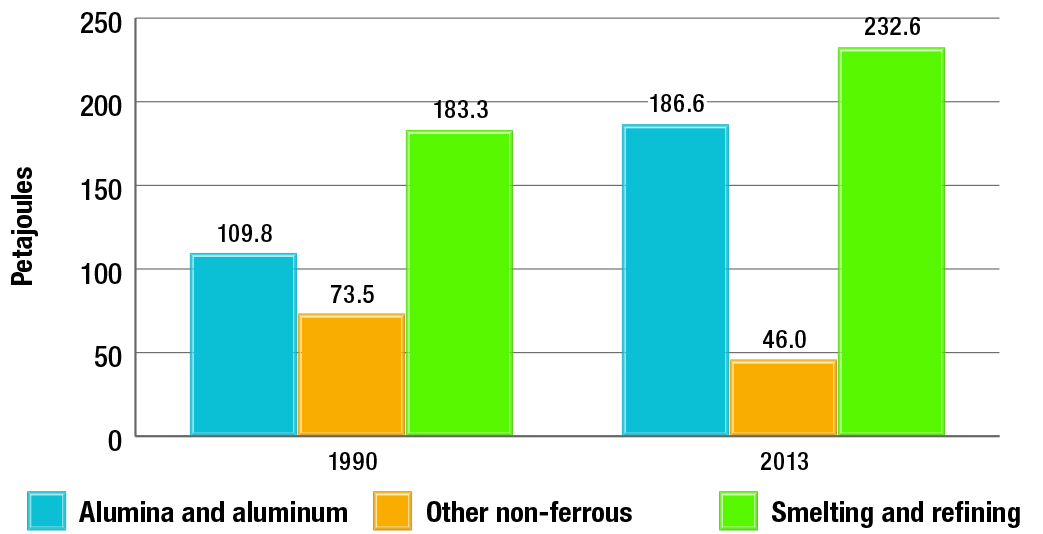
Figure 5.6 Smelting and refining energy use by selected industry, 1990 and 2013
Text version
Figure 5.6 is a vertical bar graph of smelting and refining energy use by selected industry, 1990 and 2013. The production of aluminum grew 89 percent between 1990 and 2013 and is responsible for most of the 70 percent growth in energy use in this subsector since 1990.
The production of aluminum grew 89 percent between 1990 and 2013 and is responsible for most of the 70 percent growth in energy use in this subsector since 1990 (see Figure 5.6).
Trends – Pulp and paper energy use and GHG emissions
The pulp and paper industry is engaged in the manufacturing of pulp, paper and paper products and is the main user of biomass as a source of energy.
Pulp and paper production decreased its energy use by 21 percent since 1990 and now represents 16 percent of sectoral energy use. The largest decline came from the newsprint mill industry, with a 55 percent decrease since 1990 (Figure 5.7). GHG emissions decreased 57 percent since 1990 for the sector as a whole.
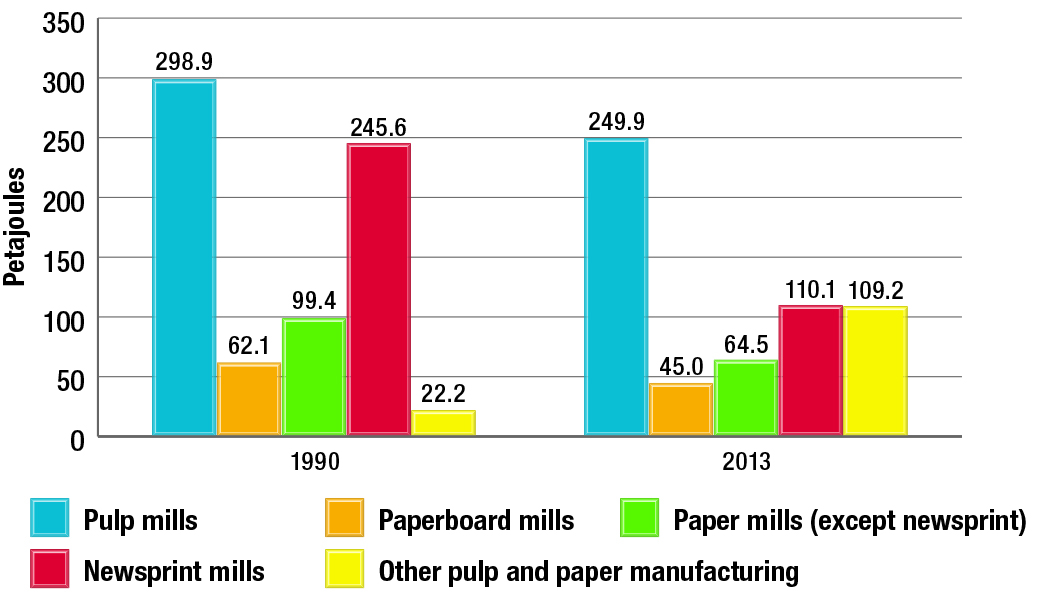
Figure 5.7 Energy consumption by subsector of the pulp and paper industry, 1990 and 2013
Text version
Figure 5.7 is a vertical bar graph of energy consumption by subsector of the pulp and paper industry, 1990 and 2013. Pulp and paper production decreased its energy use by 21 percent since 1990, and now represents 16 percent of sectorial energy use. The largest decline came from the newsprint mill industry, with a 57 percent decrease since 1990.
Trends – Other manufacturing energy use and GHG emissions
Other manufacturing is a residual category of manufacturing industries not classified elsewhere in the industrial sector definition used in this analysis. This category includes many industries, such as wood products, food and beverage, and motor vehicle manufacturing.
Other manufacturing energy use increased slightly from 551.1 PJ to 553.0 PJ between 1990 and 2013. GHG emissions declined from 28.7 Mt to 22.8 Mt, while GDP increased from $103.3 billion ($2007) to $138.0 billion ($2007) since 1990.
The biggest energy consumer in the other manufacturing category is the wood products industry. These establishments are engaged in
- sawing logs into lumber and similar products, or preserving these products
- making products that improve the natural characteristics of wood, for example, by making veneers, plywood, reconstituted wood panel products or engineered wood assemblies
- making a diverse range of wood products such as millwork
The wood products industry represented 11 percent of the other manufacturing subsector’s energy use with 61.2 PJ. Its average annual increase is 1.7 percent.
Industrial energy intensity and efficiency
Energy intensity
Several factors influenced the trends in energy use and energy intensity. Since 1990, energy intensity decreased at an average annual rate of 0.4 percent from 9.5 MJ/$2007 – GDP in 1990 to 8.6 MJ/$2007 – GDP in 2013 (see Figure 5.8). Between 2009 and 2013, industrial capacity utilization rose from 73 to 81 percent. This is still below the pre-recession 82 percent capacity utilization seen in 2007.
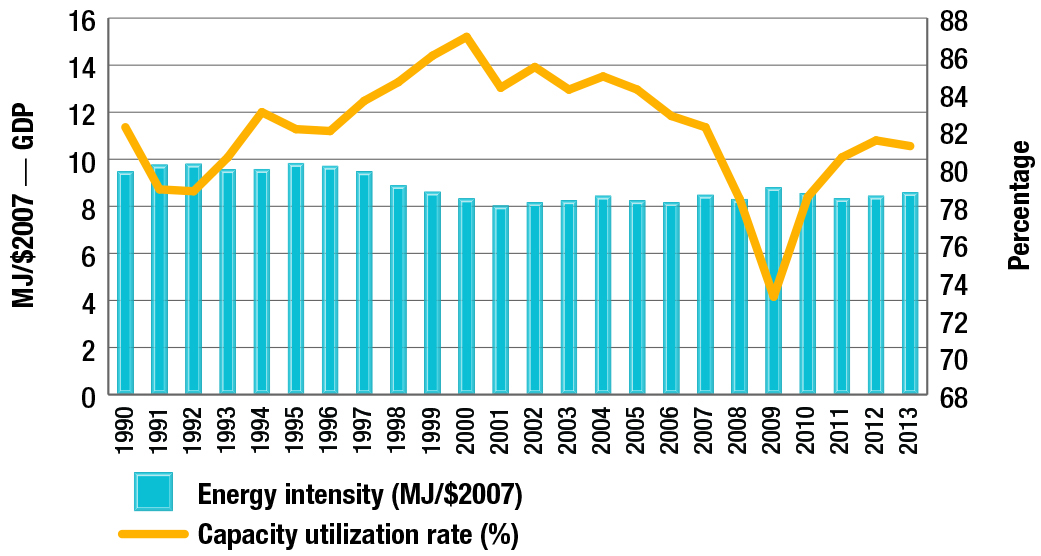
Figure 5.8 Capacity utilization and energy intensity per year
Text version
Figure 5.8 shows capacity utilization and energy intensity per year. Since 1990, energy intensity decreased at an average annual rate of 0.4 percent, from 9.5 MJ/$2007 – GDP in 1990 to 8.6 MJ/$2007 – GDP in 2013.
At the aggregate industry level, 6 of the 10 industries reduced their energy intensityFootnote 10 over the 1990–2013 period. Three industries experienced an increase: mining, forestry, and chemical manufacturing. The biggest increase in energy intensity was 156 percent in forestry. Figure 5.9 illustrates that energy use in forestry increased 147 percent, while GDP fell 4 percent. In the mining sector, the move toward unconventional crude oil production contributed to the increase in energy intensity.
Gains in energy efficiency and a shift toward less energy-intensive activities were contributing factors in the subsectors that decreased their energy intensity. Energy efficiency improvements in the form of more efficient capital and management practices are important factors. Another key variable linked to energy intensity is the capacity utilization rate. This rate is calculated by dividing the actual production level for an establishment (measured in dollars or units) by the establishment’s maximum production level under normal conditions.

Figure 5.9 Change in GDP and energy use by subsector, 1990–2013
Text version
Figure 5.9 is a horizontal bar graph showing the change in GDP and energy use, 1990–2013. The biggest increase in energy intensity was 156 percent in forestry. Figure 5.9 illustrates that energy use in forestry increased 147 percent, while GDP fell 4 percent.
Energy efficiency
In 2013, Canadian industry saved $3.0 billion in energy costs due to an 8.1 percent energy efficiency improvement. Industry saved 220.1 PJ of energy, or 10.8 Mt of GHG emissions.

Figure 5.10 Industrial energy use, with and without energy efficiency improvements, 1990–2013
Text version
Figure 5.10 is a graph with two curves that show industrial energy use, with and without energy efficiency improvements, 1990–2013. In 2013, Canadian industry saved $3.0 billion in energy costs due to energy efficiency improvements. Industry saved 220.1 PJ of energy or 10.8 Mt of GHG emissions.
Figure 5.11 illustrates the influence that various factors had on the change in industrial energy use between 1990 and 2013. These effects are as follows:
- activity effect – Activity (the mix of GDP, gross output [GO] and production units) increased energy use by 1,859.6 PJ and GHG emissions by 91.6 Mt.
- structure effect – The structural changes in the industrial sector, specifically, a relative decrease in the activity share of energy-intensive industries, helped the sector to reduce its energy use and GHG emissions by 869.7 PJ and 42.8 Mt, respectively.
- capacity utilization effect – The capacity utilization effect increased industrial energy use by 45.6 PJ and emitted 2.2 Mt more GHGs.
- energy efficiency effect – Improvements in the energy efficiency of the industrial sector avoided 220.1 PJ of energy use and 10.8 Mt of GHG emissions.
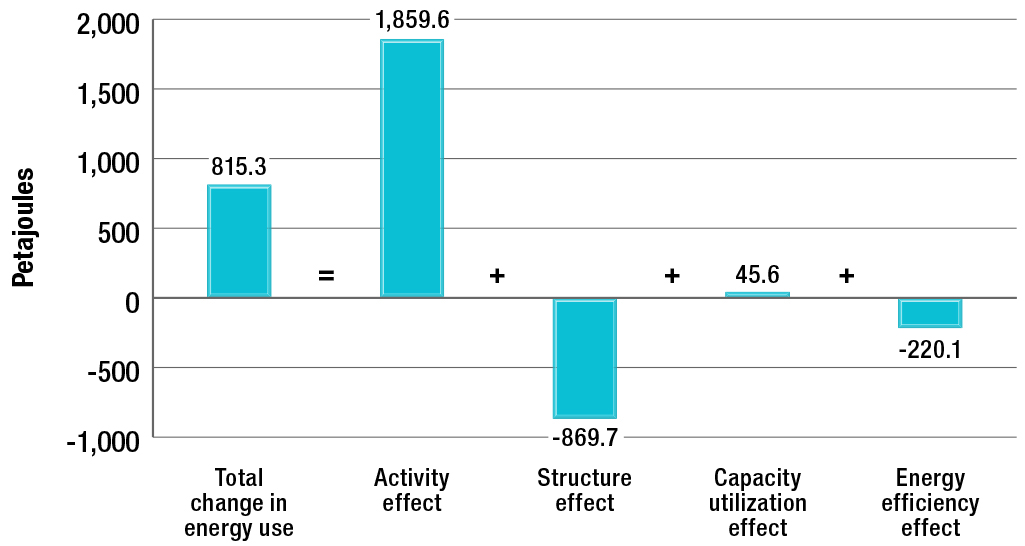
Figure 5.11 Impact of activity, structure, capacity utilization and energy efficiency on the change in industrial energy use, 1990–2013
Text version
Figure 5.11 is a vertical bar graph showing the impact of activity, structure, energy efficiency and capacity utilization on the change in industrial energy use, 1990–2013. Activity increased the energy use by 1859.6 PJ. The structural changes in the industrial sector helped reduce its energy use by 869.7 PJ. The capacity utilization effect increased industrial energy use by 45.6 PJ. Improvements in the energy efficiency of the industrial sector avoided 220.1 PJ of energy use.
Furthermore, manufacturing energy efficiency savings were 418.9 PJ in 2013.
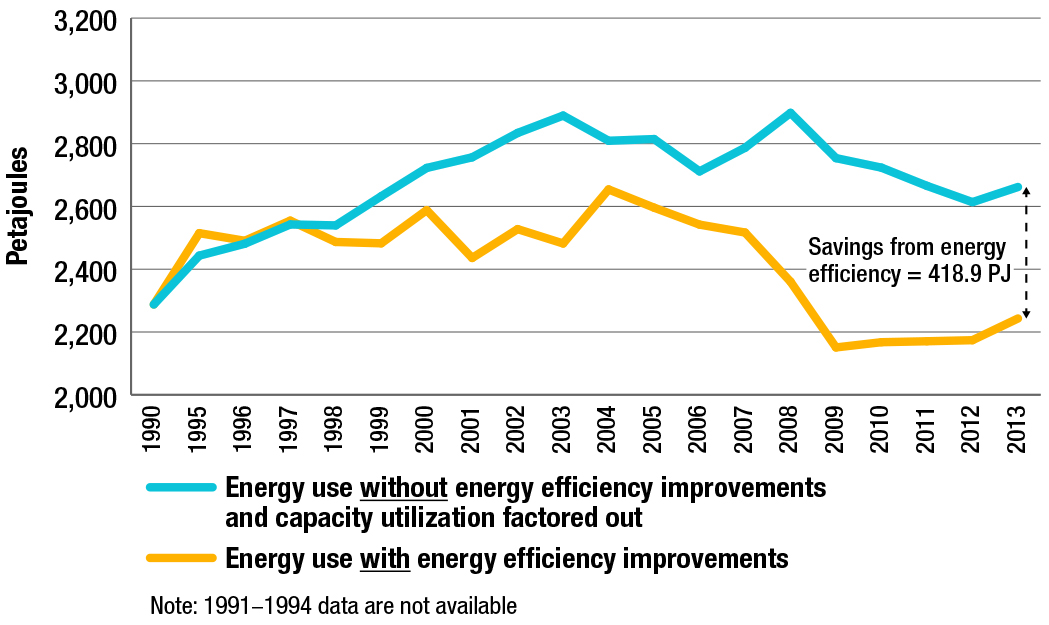
Figure 5.12 Manufacturing energy use, with and without energy efficiency improvements, 1990–2013
Text version
Figure 5.12 is a graph with two lines that show manufacturing energy use, with and without energy efficiency improvements, 1990–2013. Manufacturing energy efficiency savings grow to 418.9 PJ in 2013 if we factor out capacity utilization.
Also, to provide a better assessment of energy efficiency gains from the rest of the industry, the factorization analysis was produced without the upstream mining sector.
Without upstream mining, Canadian industries improved energy efficiency by 35 percent, which represents 939.8 PJ of savings (Figure 5.13).
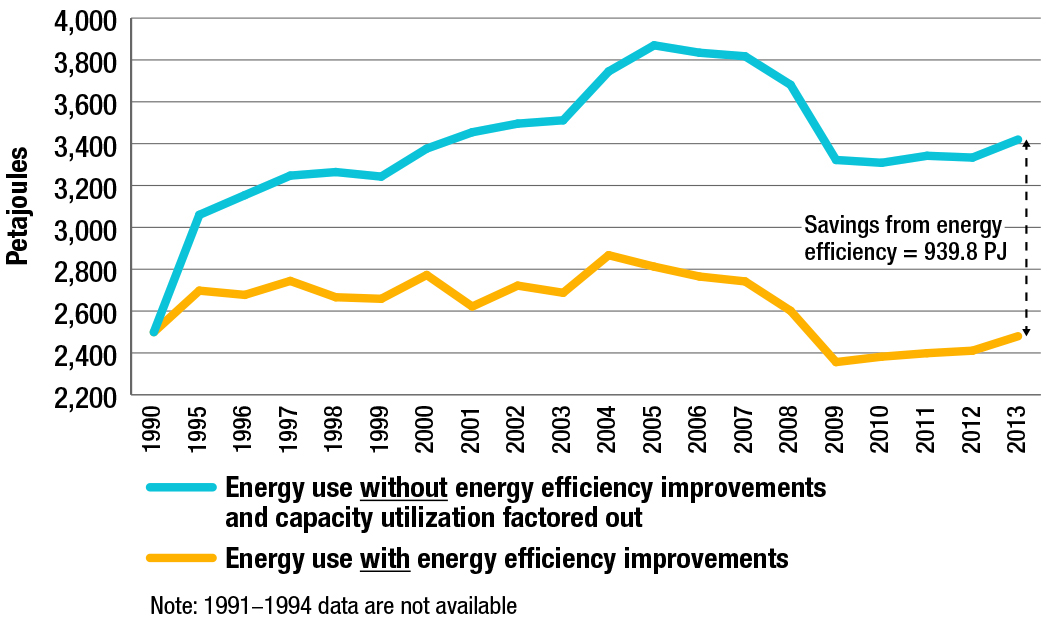
Figure 5.13 Industrial energy use, with and without energy efficiency improvements (without upstream mining), 1990–2013
Text version
Figure 5.13 is a graph with two lines showing industrial energy use, with and without energy efficiency improvements (without upstream mining), 1990–2013. Without upstream mining, Canadian industries improved energy efficiency by 35 percent, which represents 939.8 PJ of savings.
Figure 5.14 presents the impact of activity, structure, capacity utilization and energy efficiency on the change in industrial energy use without upstream mining:
- activity effect – The mix of GDP, GO and production units (activity measures) increased energy use by 1,560.2 PJ and GHG emissions by 76.8 Mt.
- structure effect – The structural changes in the industrial sector helped the sector to reduce its energy use and GHG emissions by 1,038.8 PJ and 51.2 Mt, respectively.
- capacity utilization effect – The capacity utilization effect increased energy use by 398.9 PJ and emitted 19.6 Mt more GHGs.
- energy efficiency effect – Improvements in the energy efficiency of the industrial sector avoided 939.8 PJ of energy use and 46.3 Mt of GHG emissions.
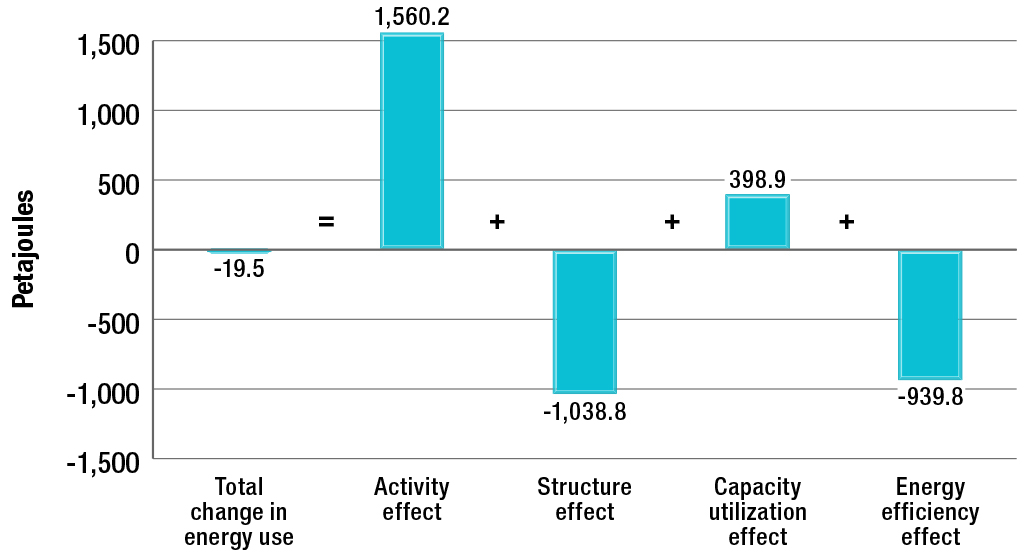
Figure 5.14 Impact of activity, structure, capacity utilization and energy efficiency on the change in industrial energy use (without upstream mining), 1990–2013
Text version
Figure 5.14 is a vertical bar graph showing the impact of activity, structure, energy efficiency and capacity utilization on the change in industrial energy use (without upstream mining), 1990–2013. The mix of activity measures increased the energy use by 1,560.2 PJ. The structural changes in the industrial sector helped the sector to reduce its energy use by 1038.8 PJ. The capacity utilization effect increased energy use by 398.9 PJ. Improvements in the energy efficiency of the industrial sector avoided 939.8 PJ of energy use.
Chapter 6: Transportation sector
Over the 1990–2013 period,
- Energy efficiency in the transportation sector improved 29 percent, saving Canadians 512.1 PJ of energy and $17.2 billion in energy costs in 2013.
- Total transportation energy use increased 43 percent, from 1,877.9 PJ to 2,685.5 PJ.
Passenger transportation
- Passenger transportation energy efficiency improved 27 percent, saving 300.0 PJ, or $10.2 billion in energy costs in 2013.
- Passenger transportation energy use increased by 20 percent. It would have increased 46 percent without energy efficiency improvements.
Freight transportation
- Freight transportation energy efficiency improved 31 percent, saving 212.1 PJ, or $7.0 billion in energy costs in 2013.
- Freight transportation energy use increased by 78 percent. It would have increased 109 percent without energy efficiency improvements.
Overview – Transportation energy use and GHG emissions
Though the transportation sector was second to the industrial sector in energy consumption, it was first in energy expenditure in 2013.
The transportation sector is diverse and covers several modes of transport including road, air, rail and marine. In Canada, these modes of transport are used for transporting both people and goods. This chapter describes the energy consumption for the transportation of both these entities.
In 2013, Canadians, individuals and businesses, spent $90.1 billion on fuel for transportation, making it the largest expenditure of all the sectors in the country. This expenditure was more than double that of the industrial sector. This can be explained by the particularly high cost of fuels compared to those of other energy sources in the other sectors.
The transportation sector comes second, at 30 percent (Figure 6.1), in energy consumption in Canada and first, at 38 percent (Figure 6.2), in the emission of associated GHGs. This sector produces a greater portion of GHG emissions because the main fuels consumed for transportation are more GHG-intensive than those used by other sectors of the economy.
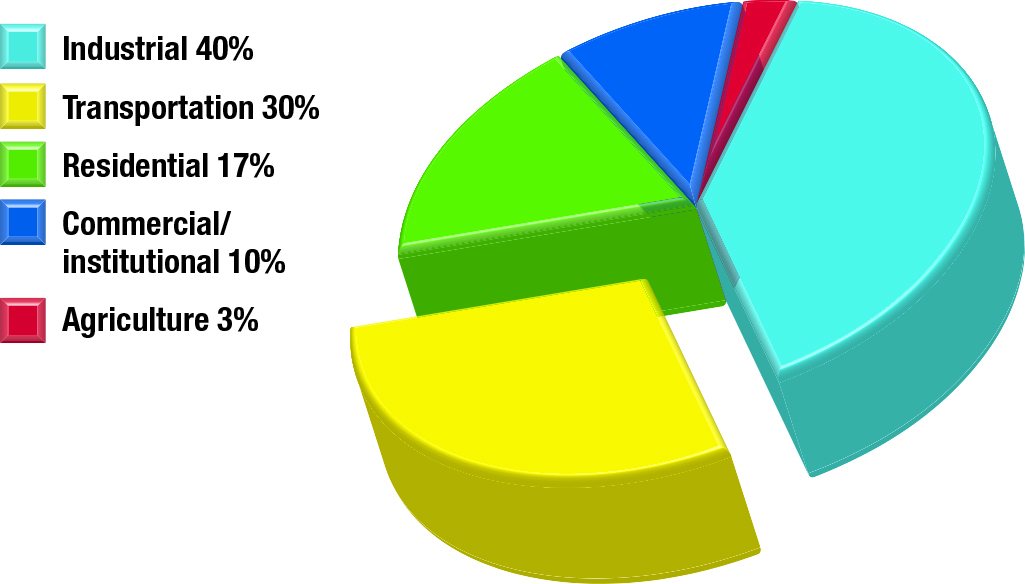
Figure 6.1 Secondary energy use by sector, 2013
Text version
Figure 6.1 is a pie chart demonstrating that in 2013, the industrial sector was the largest energy user, accounting for 40 percent of total secondary energy use. The transportation sector was the second largest energy user at 30 percent, followed by the residential sector at 17 percent, the commercial/institutional sector at 10 percent and the agricultural sector at 3 percent.
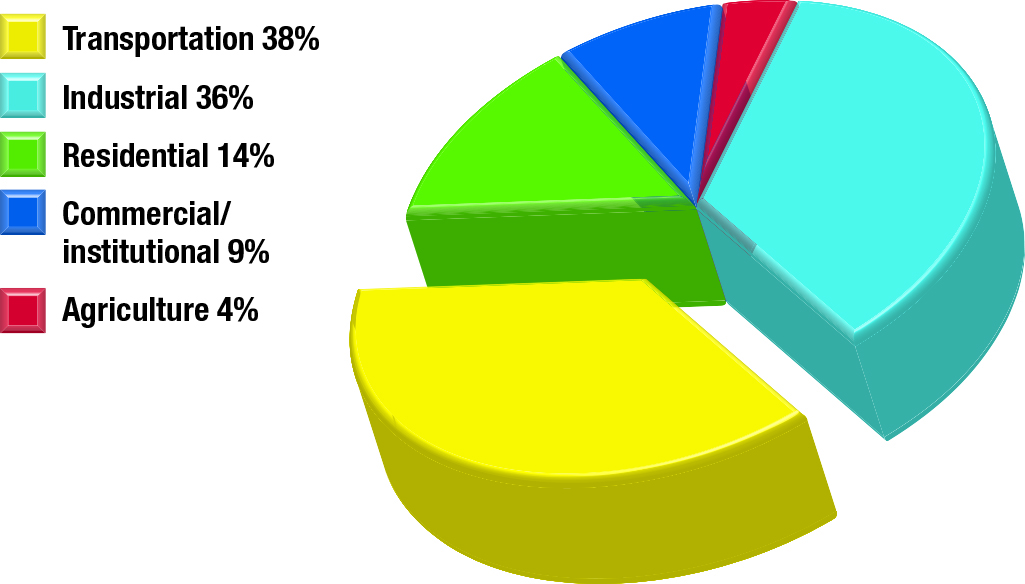
Figure 6.2 GHG emissions by sector, 2013
Text version
Figure 6.2 is a pie chart illustrating the distribution of greenhouse gas emissions by sector. The transportation sector accounted for 38 percent of total greenhouse gases emitted in 2013, followed by the industrial sector at 36 percent, the residential sector at 14 percent, the commercial/institutional sector at 9 percent and the agriculture sector at 4 percent.
In this sector, the modes of passenger transportation accounted for 51 percent of the total energy consumption, while the freight transportation subsector accounted for 45 percent (Figure 6.3). The remaining 4 percent of energy consumption was used by off-road vehicles. This category includes all the machines whose main use is not on public roads, such as snowmobiles and lawn mowers. Off-road transportation has not been analyzed in this report due to the lack of data available for this category and the low share of energy consumption by off-road vehicles.
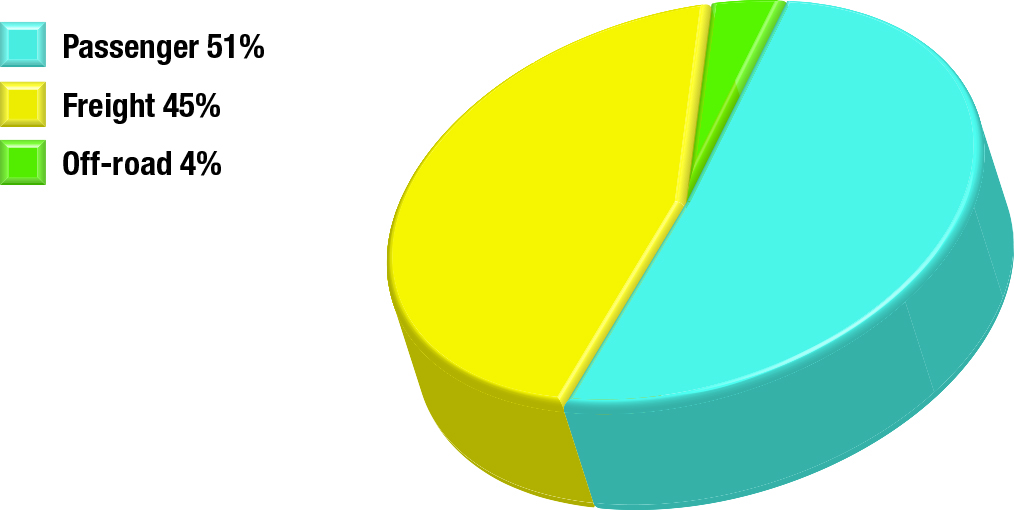
Figure 6.3 Energy use by subsector, 2013
Text version
Figure 6.3 is a pie chart showing that in the transportation sector, in 2013, passenger modes consumed more than half (51 percent) of total transportation energy use, while freight transportation accounted for 45 percent; off road vehicles represented only 4 percent.
Trends – Transportation energy use and GHG emissions
Growth of freight transportation has increased the demand for energy in the transportation sector.
Between 1990 and 2013, the total energy consumption for the transportation sector increased 43 percent, from 1,877.9 PJ to 2,685.5 PJ, and associated GHG emissions increased 40 percent, from 132.6 Mt to 186.1 Mt.
Among the subsectors, freight transportation experienced more rapid growth, representing 65 percent of the increase in energy consumption in the transportation sector. Furthermore, the growing preference to use heavy-duty trucks, which typically consume more energy than other modes of transportation, in itself accounts for 46 percent of the increase in energy consumption of freight transportation and 30 percent of all transportation.
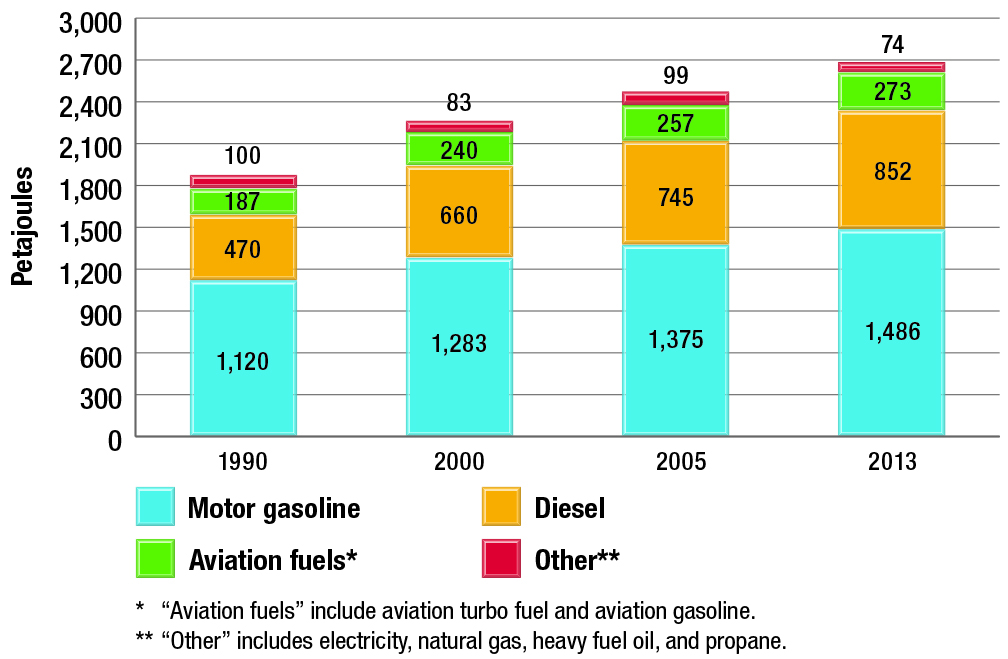
Figure 6.4 Transportation energy use by energy source, selected years
Text version
Figure 6.4 is a graph with stacked columns on transportation sector energy use by energy source. During the period from 1990 to 2013, motor gasoline and diesel were the main energy types consumed in the transportation sector, representing 87 percent of the total consumption. Aviation fuels represented 9 percent of total consumption and the other fuel types (electricity, natural gas, residual fuel oils and propane) accounted for 4 percent.
The growth of the freight transportation sector was the main contributor to an 81 percent increase in the demand for diesel fuel.
As Figure 6.4 shows, motor gasoline and diesel are the main energy types consumed in the transportation sector, representing 87 percent of the total consumption in 2013. Aviation turbine fuel, heavy fuel oil, propane, aviation gasoline, electricity and natural gas are also shown in the order of the quantities consumed. Motor gasoline dominates the market with 55 percent of all transportation energy, followed by diesel with 32 percent and, lastly, other energy sources accounting for 13 percent.
During the period from 1990 to 2013, diesel consumption increased 81 percent, particularly because of the increasing use of heavy-duty vehicles on Canadian roads, which alone contributed to 63 percent of this increase. Moreover, motor gasoline consumption, including ethanol, increased 33 percent, with freight transportation vehicles and passenger vehicles accounting for almost half (176.7 PJ) and more than a third (140.0 PJ) of that figure, respectively. Consumption of some fuels such as aviation gasoline, propane and natural gas declined over the same period.
Energy efficiency in the transportation sector
Energy efficiency improvements in the transportation sector resulted in energy savings of 512.1 PJ or $17.2 billion for Canada in 2013.
Between 1990 and 2013, energy efficiency in the transportation sector improved by 29 percent, which resulted in energy savings worth $17.2 billion, or 512.1 PJ of energy in 2013 (Figure 6.5). These savings were largely due to some energy efficiency improvements in trucks used for freight transportation and in light-duty vehicles used in passenger transportation.
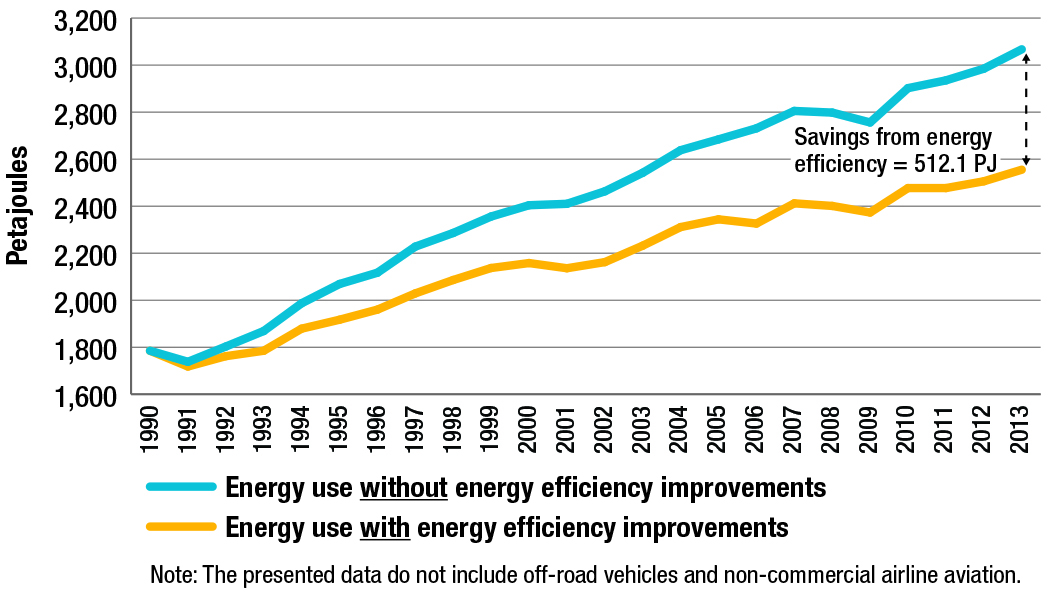
Figure 6.5 Transportation energy use, with and without energy efficiency improvements, 1990–2013
Text version
Figure 6.5 is a graph with two curves that show the energy use in the transportation sector, actual and without energy efficiency improvements between 1990 and 2013. Energy efficiency improved 29 percent, saving $17.2 billion or 512.1 PJ of energy. Without improvements in energy efficiency, increases attributable to activity and structure would have increased transportation energy use by 43 percent.
Trends – Passenger transportation energy use and GHG emissions
Light-duty vehicles (small cars, large cars, light trucks and motorcycles) are the main mode of transportation used by Canadians for passenger transportation. Air transport, rail transport and transportation by bus or coach are also used, though to a lesser extent.
With regard to the passenger transportation subsector, energy consumption is related to passenger-kilometres (Pkm). A Pkm is calculated by multiplying the number of passengers carried by the distance covered. Consequently, when two passengers are travelling in the same vehicle and are transported across a distance of 10 kilometres, it is the equivalent of 20 Pkm. When the Pkm number rises, an increase in energy consumption is normally observed, unless there have been improvements in energy efficiency to compensate for the activity increase.
The number of light-duty vehicles per inhabitant has increased slightly.
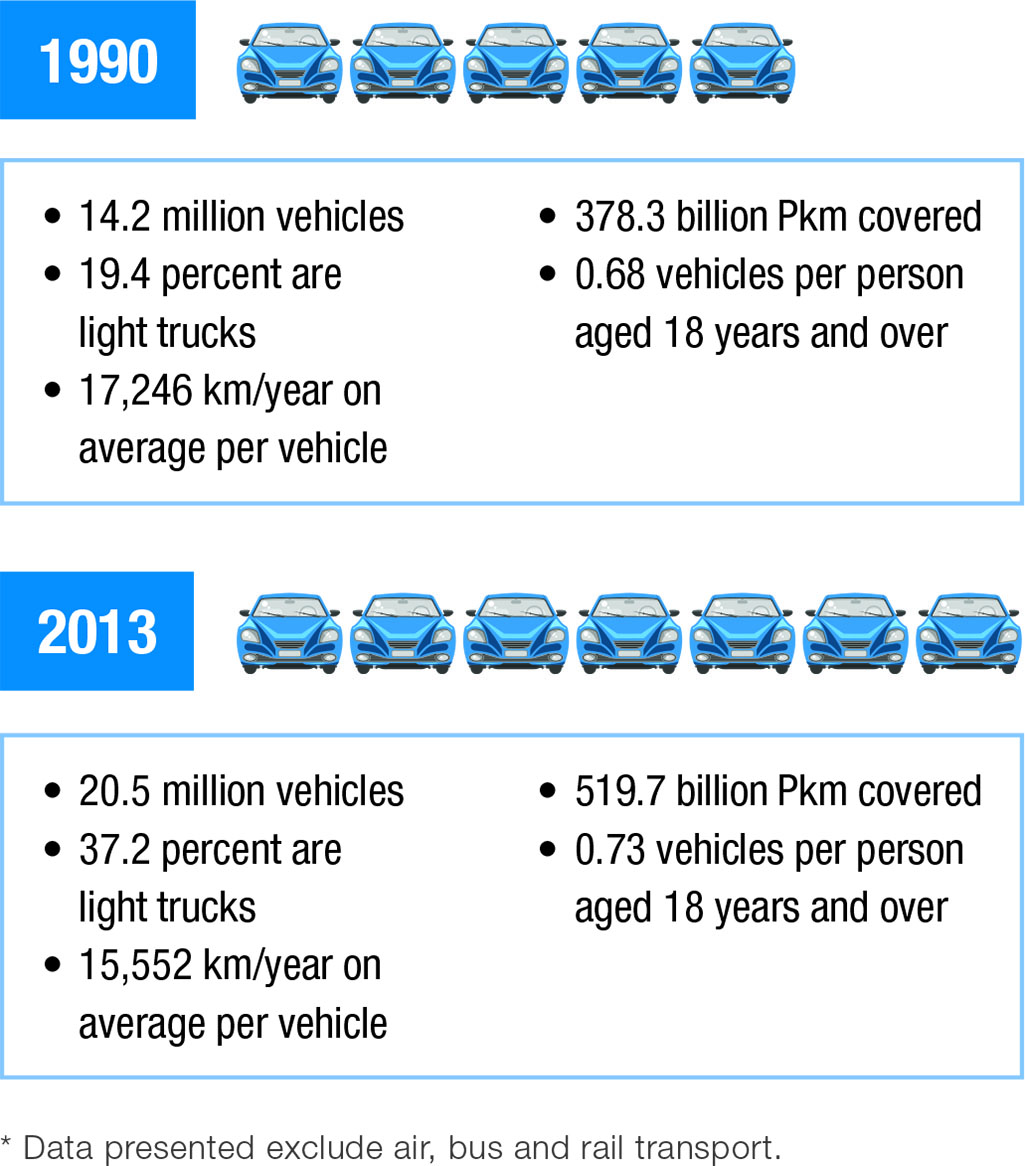
Figure 6.6 Energy indicators for passenger transportation,* 1990 and 2013
Text version
Figure 6.6 is an illustration of energy indicators for passenger transportation in 1990 and in 2013. It shows a slight increase in the number of vehicles per person aged 18 years and over, from 0.68 vehicles in 1990 to 0.73 in 2013. The passenger vehicle stock was 14.2 million in 1990 and 20.5 million in 2013. The proportion of light trucks was 19.4 percent in 1990 and 37.2 in 2013. Passenger vehicles travelled an average of 17246 km/year in 1990 and 15552 km/year in 2013. Finally, 378.3 billion Pkm was covered in 1990 and 519.7 billion in 2013.
* Data presented exclude air, bus and rail transport.
Figure 6.6 shows a slight increase in the number of vehicles per person aged 18 years and over, from 0.68 vehicles in 1990 to 0.73 in 2013. Moreover, the distance covered in Pkm by light vehicles for passenger transportation (excluding urban transportation and coaches) increased on average by 1.4 percent per year. The distance covered in Pkm for urban transportation and coaches increased on average by 2.6 percent per year between 1990 and 2013. Consequently, the market share of public transit has increased over the past 23 years. Over this period, the energy consumption for passenger transportation increased by 20 percent, from 1,151.1 to 1,379.6 PJ, and the associated GHG emissions increased 16 percent, from 80.6 to 93.5 Mt.
The mix of fuels used in the passenger transportation subsector has remained relatively constant. Motor gasoline has been the main energy source, representing 75 percent of the combination of fuels used in 2013, followed by aviation turbine fuel and diesel (Figure 6.7).
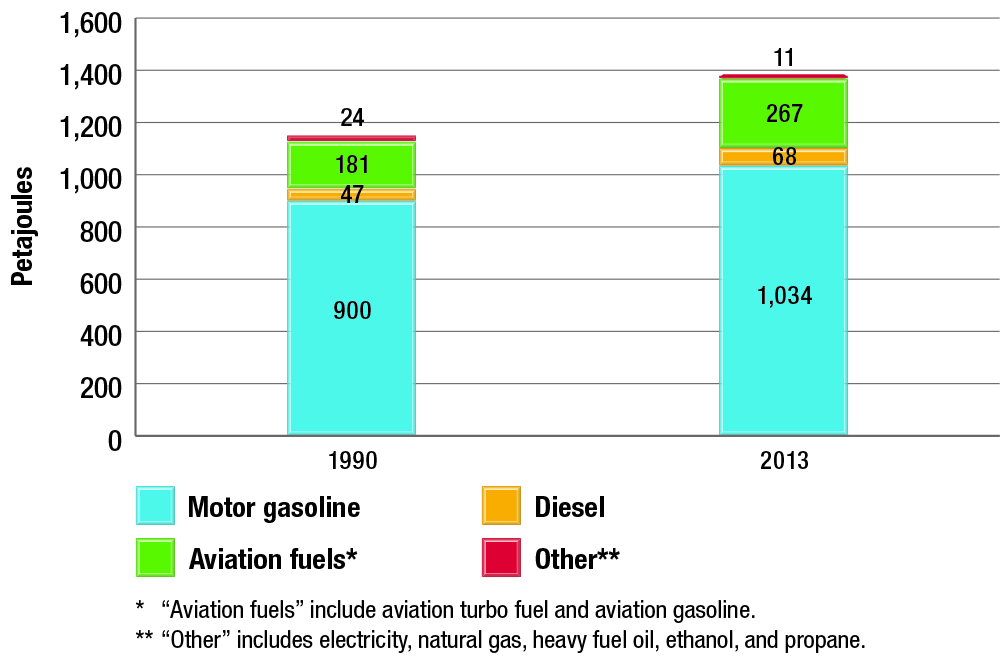
Figure 6.7 Passenger transportation energy use by fuel type, 1990 and 2013
Text version
Figure 6.7 is a graph with stacked columns on energy consumption for passenger transportation by fuel type in 1990 and 2013. Motor gasoline has been the main energy source, representing 75 percent of the combination of fuels used in 2013, followed by aviation turbine fuel and diesel.
More Canadians are driving minivans and sport utility vehicles.
The choices made by Canadians to meet their transportation needs are contributing to an increase in energy consumption. A growing number of Canadians bought light trucks (including minivans and sport utility vehicles [SUV]) rather than vehicles that have better ranking in fuel consumption. In 2013, light-truck sales comprised 45 percent of new vehicles sold for passenger transportation, compared to 24 percent in 1990. This shift from cars to light trucks has resulted in a significant increase in passenger-transportation energy consumption. Between 1990 and 2013, energy consumption associated with the use of light trucks increased at a faster pace than that associated with any other mode of passenger transportation, with the exception of motorcycles, representing an increase of 131 percent (Figure 6.8).
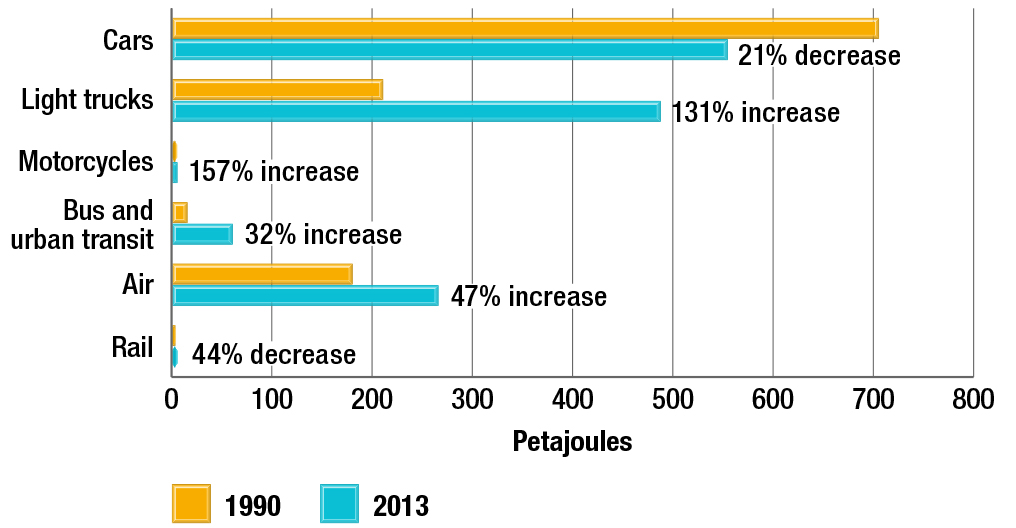
Figure 6.8 Passenger transportation energy use by mode of transportation, 1990 and 2013
Text version
Figure 6.8 is a graph with horizontal bars on energy consumption for passenger transportation by mode of transportation in 1990 and 2013.The energy consumption for light trucks increased by 131 percent over the period 1990-2013, motorcycle by 157 percent, air by 47 percent and bus and urban transit by 32 percent. The energy consumption of other modes decreased such as rail by 44 percent, car by 21 percent.
Air transport is becoming more popular.
Since 1990, Canadians are increasingly using air transport,Footnote 11 translating into a significant increase of Pkm (133 percent). However, during the same period, the increase in energy consumption was lower (47 percent), which indicates growing efficiency by this mode of transportation. Two important factors contributed to this improvement. The first factor resides in the increasing effort by carriers to adapt the size of the aircraft based on the market size. The second factor is the implementation in 1994 and 1995 of the “Open Skies” agreement between Canada and the Unites States, which allowed the addition of many short-haul routes operated by regional air carriers that use smaller aircraft.Footnote 12
Passenger transportation energy intensity and efficiency
Energy intensity
Energy intensity in the context of passenger transportation is defined as the amount of energy used to move one person over a distance of one kilometre. Between 1990 and 2013, energy intensity declined by 21 percent, from 2.3 megajoules (MJ) per Pkm covered to 1.8 MJ/Pkm. Improved vehicle fuel performance is the main reason for this reduction. The average fuel performance is measured by the quantity of litres consumed to cover a distance of 100 km (L/100 km).
Figure 6.9 indicates that all modes of transportation, with the exception of motorcycles, saw a reduction in energy intensity from 1990 to 2013. The modes of transportation showing the greatest improvement were rail transportation, and buses and urban transit, where energy intensity decreased by 27 percent, followed by air transportation, which recorded a decrease of 26 percent. In third place, cars reduced a fifth of their energy intensity compared to their 1990 level, at 22 percent. They were closely followed by light trucks, which recorded a decrease of 20 percent. Finally, the energy intensity of motorcycles increased 18 percent.
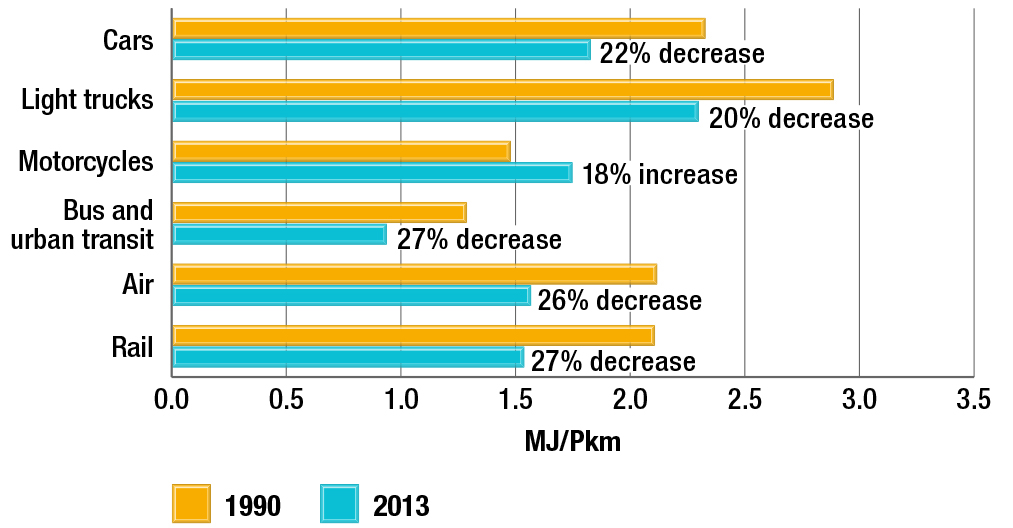
Figure 6.9 Passenger transportation energy intensity by mode of transportation, 1990 and 2013
Text version
Figure 6.9 is a graph with horizontal bars that indicates that all the modes of transportation, with the exception of motorcycles, saw a reduction in energy intensity from 1990 through 2013. The modes of transportation showing the greatest improvement were air transport (26%), rail (27%), bus and urban transit (27%), followed by cars (22%) and light trucks (20%).
Energy efficiency
Improvements in energy efficiency for passenger transportation generated energy savings of 300.0 PJ, or $10.2 billion in the transportation sector in 2013.
The amount of energy consumed for passenger transportation increased by 20 percent, from 1,151.1 PJ in 1990 to 1,379.6 PJ in 2013. Figure 6.10 shows that without the improvements in energy efficiency, energy consumption during this period would have increased by 46 percent.
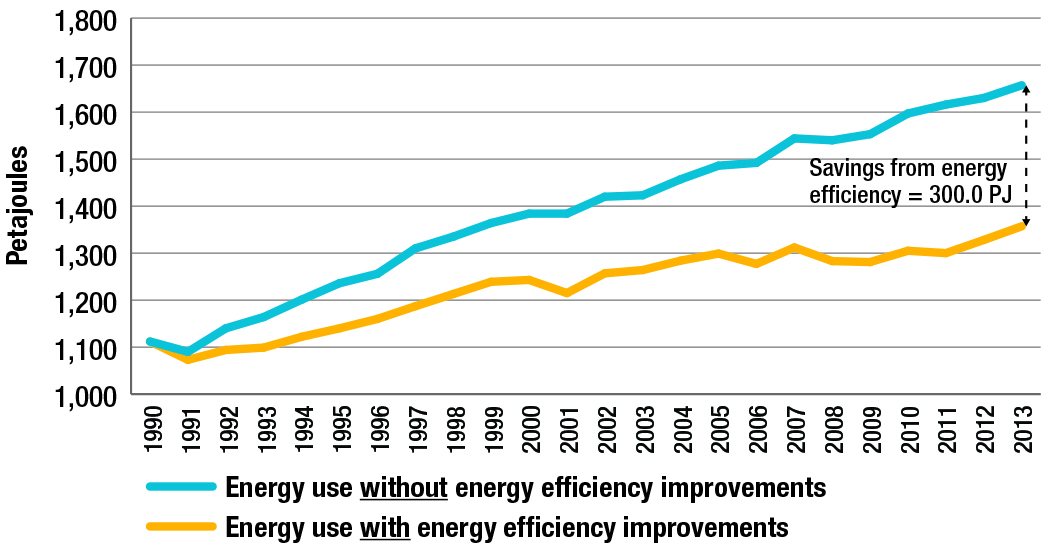
Figure 6.10 Passenger transportation energy use, with and without energy efficiency improvements, 1990–2013
Text version
Figure 6.10 is a graph with two curves that shows energy consumption for passenger transportation, with and without improvements in energy efficiency between 1990 and 2013. Energy efficiency improvement for passenger transportation generated energy saving of 300.0 PJ in 2013.
Figure 6.11 indicates the impact of various factors on the change in energy consumption of the passenger transportation subsector between 1990 and 2013. The effects of those factors can be enumerated as follows:
- activity effect – The effect of activity, that is, the number of Pkm travelled, translated into an increase in energy consumption of 43 percent, or 522.3 PJ, and in the associated GHG emissions of 35.4 Mt. This increase in Pkm is mainly due to a 190 percent increase in the activity of light trucks and a 133 percent increase in air transport activities.
- structure effect – Changes in the combination of the modes of transportation, that is, the relative shares of Pkm attributed to air, rail and road transport, are used to measure the structural changes. Hence, an overall change of structure would decrease (or increase) energy consumption if the relative share of a more (or less) efficient mode increases in relation to that of the others. The relative shares of Pkm travelled increased significantly for passenger air transport and light trucks. The overall structural effect was positive, given the growing taste for minivans and SUVs, which consume more fuel than other modes of transportation. Consequently, the analyses show an increase of 22.8 PJ in energy consumption and 1.5 Mt in associated GHG emissions attributable to the effect of structure.
- energy efficiency effect – Improvements in energy efficiency (27 percent) in passenger transportation generated energy savings of 300.0 PJ and avoided 20.3 Mt of associated GHG emissions. The light-vehicle segment (automobiles, light trucks and motorcycles) for passenger transportation accounted for 74 percent of those savings.

Figure 6.11 Impact of activity, structure, and energy efficiency on the change in passenger transportation energy use, 1990-2013
Text version
Figure 6.11 is a graph with vertical bars that indicates the impact of various factors on the change in energy consumption of the passenger transportation subsector between 1990 and 2013. These factors are measured by activity effect, structure effect and energy efficiency effect. Total change in energy use (228.5 PJ) is equal to the activity effect (522.3 PJ) plus the structure effect (22.8 PJ) plus the energy efficiency effect (-300.0 PJ) plus other (-16.6 PJ). Other refers to non-commercial air transport, which is included in the value for the “Overall change in energy consumption,” but excluded from the factorization analysis.
Trends – Freight transportation energy use and GHG emissions
In Canada, the freight transportation subsector includes four modes of transportation: road, air, marine and rail. Transportation by truck is divided into three types: light truck, medium truck and heavy truck. The energy consumption for freight transportation is linked to tonne-kilometres (Tkm). One Tkm describes the transportation of one tonne of freight over a distance of one kilometre.
The freight transportation energy use increased by 78 percent, from 673.4 PJ in 1990 to 1,197.6 PJ in 2013. Consequently, there was a 76 percent increase of associated GHG emissions, from 48.3 Mt in 1990 to 85.2 Mt in 2013. Figure 6.12 shows an increase in energy use for all modes of truck freight transportation and rail transportation. Trucks saw the greatest increase, consuming 85 percent of total freight transportation energy use in 2013, compared to 70 percent in 1990. Marine and air transport showed decreased energy use (18 percent and 4 percent, respectively).
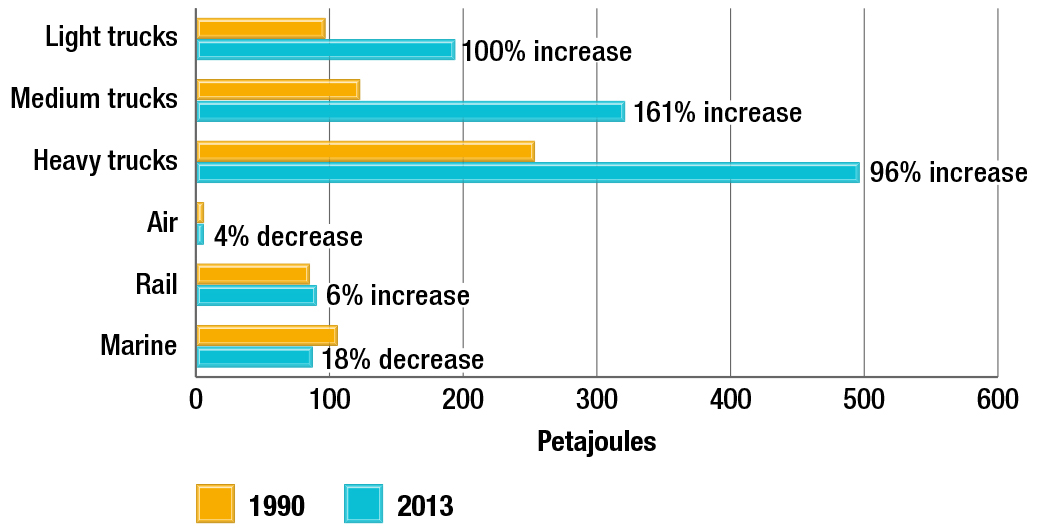
Figure 6.12 Freight transportation energy use by mode of transportation, 1990 and 2013
Text version
Figure 6.12 is a graph with horizontal bars on energy consumption for freight transportation by mode in 1990 and 2013. The energy consumption of heavy trucks increased by 96 percent over the period 1990-2013, medium trucks by 161 percent, light trucks by 100 percent and rail by 6 percent. By contrast, the energy consumption of other modes decreased, i.e. marine by 18 percent and air by 4 percent.
The mix of fuels used in the freight transportation subsector remained relatively constant between 1990 and 2013. Diesel was the main energy source, representing 65 percent of all the fuels consumed for freight transportation (Figure 6.13).
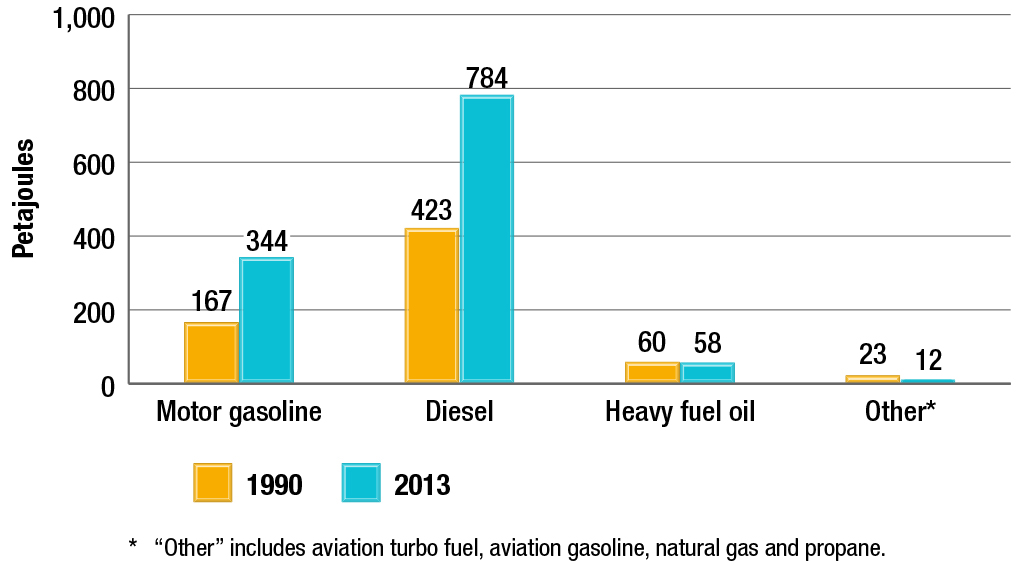
Figure 6.13 Freight transportation energy use by fuel type, 1990 and 2013
Text version
Figure 6.13 is a graph with vertical bars on energy consumption for freight transportation by fuel type in 1990 and 2013. The mix of fuels used in the freight transportation subsector remained relatively constant between 1990 and 2013. Diesel was the main energy source, representing 65 percent of all the fuels consumed for freight transportation in 2013.
Just-in-time delivery is stimulating the demand for transportation using heavy trucks.
Adoption of the just-in-time stocking scheme by many businesses has had a significant impact on the freight transportation subsector. Such a system generally requires less inventory storage space because the orders are delivered at the moment they are required for production.
Using transport vehicles as virtual warehouses requires a transportation system that is “in-time” and very efficient. This need is most often met by using heavy trucks and the use of this type of truck for freight transportation has therefore increased considerably during this period. Between 1990 and 2013, the number of heavy trucks increased 46 percent, and the average distance travelled increased 78 percent, reaching 92,296 km per year. However, heavy trucks are not only travelling greater distances but also transporting more freight, involving the use of an increasing number of trailers. This new trend has contributed to the increase in the number of Tkm and energy use in the freight transportation subsector.
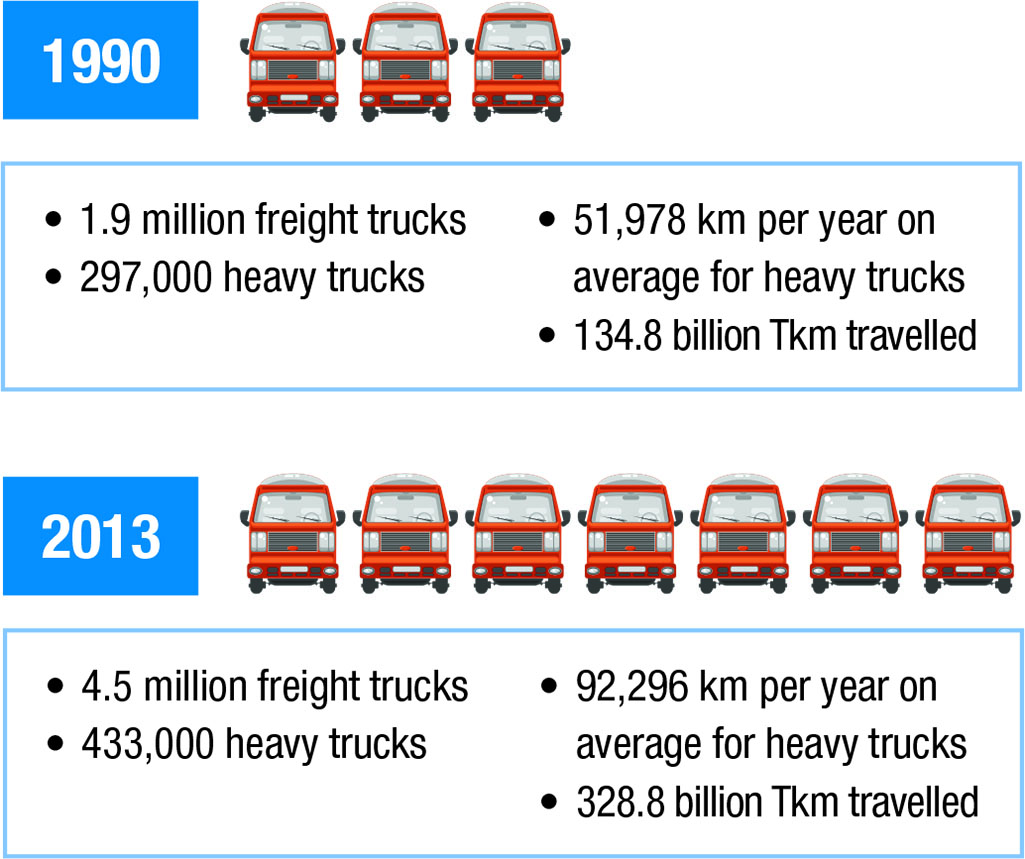
Figure 6.14 Energy indicators for freight road transportation, 1990 and 2013
Text version
Figure 6.14 is an illustration of energy indicators for freight transportation in 1990 and in 2013. It shows an increase in the number of freight vehicles from 1.9 million in 1990 to 4.5 million in 2013. Over the same period, 297,000 heavy trucks travelled an average of 51978 km and 134.8 billion Tkm in 1990 and 433,000 heavy trucks travelled an average of 92,296 km and 328.8 billion Tkm in 2013.
Rail transport remains the main mode of freight transportation in Canada.
For many goods, such as coal and cereals, trucks are not an efficient mode of transportation. Rail and marine transport continue to be the modes of choice. They therefore have an important place in the freight transportation sector. Rail transport holds the first position in terms of Tkm of freight transported with 386.1 billion Tkm in 2013, 55 percent more than in 1990. In second position, heavy trucks transported 251.5 billion Tkm in 2013, which is 128 percent more than in 1990. In third position, marine transport was used to ship 201.1 billion Tkm in 2013, which is an increase of 6 percent over the figure for 1990.

Figure 6.15 Freight transportation energy use in relation to the activity by mode, 1990 and 2013
Text version
Figure 6.15 is a graph with horizontal bars that shows the energy consumption for freight transportation in relation to the activity by mode between 1990 and 2013. All the modes of freight transportation have become more efficient with respect to energy consumption, based on the number of Tkm. However, the energy efficiency for rail and maritime transport is higher than that of trucks for freight transportation.
Since 1990, all the modes of freight transportation have become more efficient with respect to energy consumption, based on the number of Tkm. However, the sector’s energy intensity has increased by 11 percent over the period, from 1.17 MJ/Tkm to 1.30 MJ/Tkm travelled, due to the increased use of trucks, which are more energy-intensive than other types of freight transportation. Figure 6.15 shows that the energy efficiency for rail and marine transport is higher than that of trucks. In fact, these two modes of transport have high activity levels and relatively low energy consumption. For example, rail transportation is approximately nine times more efficient than heavy trucks. On the other hand, the average energy consumption for heavy trucks changed from 42.5 L of fuel per 100 km in 1990 to 32.5 L in 2013.
Freight transportation energy intensity and efficiency
Improvements in energy efficiency for freight transportation generated energy savings of 212.1 PJ, or $7.0 billion in 2013.
Between 1990 and 2013, energy consumption for freight transportation increased 78 percent, from 673.4 PJ to 1,197.6 PJ. Figure 6.16 shows that without the improvements in energy efficiency, energy consumption during this period would have increased by 109 percent.
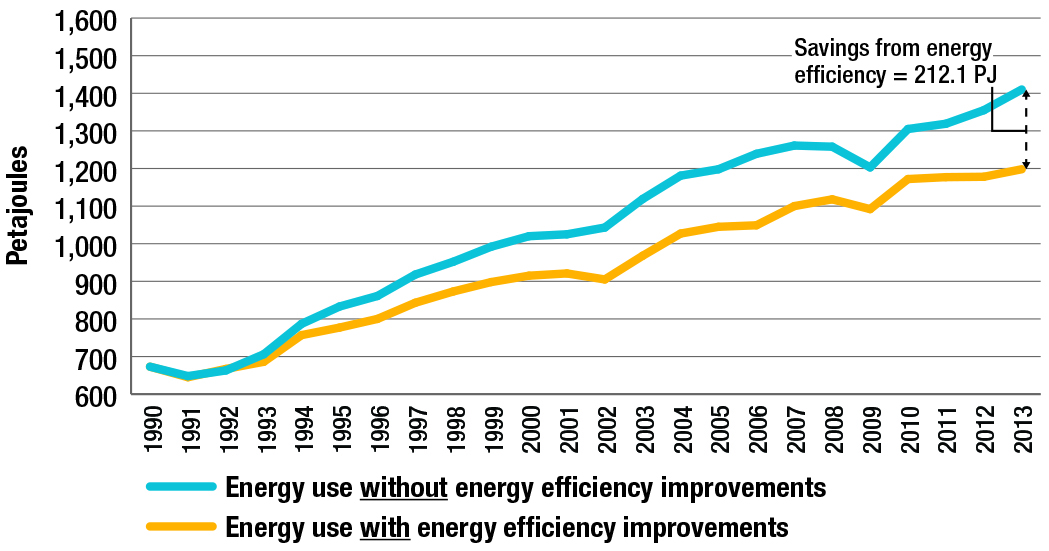
Figure 6.16 Freight transportation energy use, with and without energy efficiency improvements, 1990–2013
Text version
Figure 6.16 is a graph with two curves that shows energy consumption for freight transportation, with and without improvements in energy efficiency between 1990 and 2013. The graph illustrates a growing energy saving that reached 212.1 PJ in 2013.
Figure 6.17 indicates the impact of various factors on the change in energy consumption of the freight transportation subsector between 1990 and 2013. The effects of those factors can be enumerated as follows:
- activity effect – The effect of activity, that is, the number of Tkm travelled, translated into an increase in energy consumption of 62 percent, or 419.2 PJ, and in the associated GHG emissions of 29.8 Mt. This increase in the number of Tkm transported is mainly due to a 144 percent increase in the activity of trucks.
- structure effect – Changes in the combination of the modes of transportation, that is, the relative shares of Tkm attributed to air, marine, rail and road transport, are used to measure the structural changes. Hence, an overall change of structure would result in a decrease (or increase) in energy consumption if the relative share of a more (or less) efficient mode increases in relation to that of the others. The change between the modes is a result of the increase of the relative share of freight transported by heavy trucks compared with other modes. The overall structural effect was positive given the growth in trade between Canada and the United States and just-in-time delivery demanded by clients, thus contributing to an increase in the use of road transport, which consumes more energy per Tkm than other modes. Consequently, the analyses show an increase of 317.0 PJ in energy consumption and an increase of 22.6 Mt in associated GHG emissions attributable to the effect of structure.
- energy efficiency effect – Due to improvements in energy efficiency (31 percent) in freight transportation, energy savings of 212.1 PJ were achieved and associated GHG emissions were reduced by 15.1 Mt. The road vehicle segment (light trucks, medium trucks and heavy trucks) for freight transportation accounted for 74 percent of those savings.
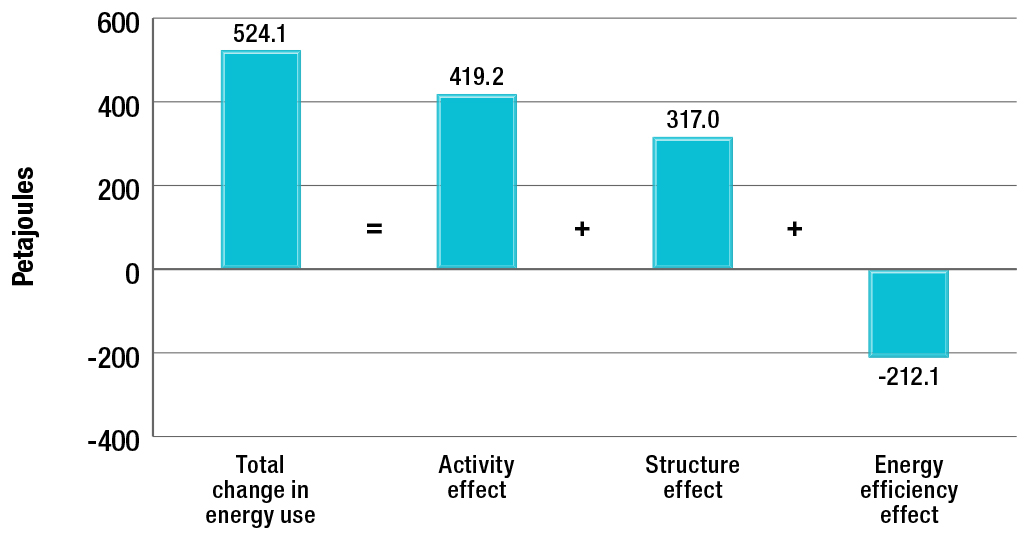
Figure 6.17 Impact of activity, structure, and energy efficiency on the change in freight transportation energy use, 1990-2013
Text version
Figure 6.17 is a graph with vertical bars that indicates the impact of various factors on the change in energy consumption of the freight transportation subsector between 1990 and 2013. These factors are measured by activity effect, structure effect and energy efficiency effect. Total change in energy use (524.1 PJ) is equal to the activity effect (419.2 PJ) plus the structure effect (317.0 PJ) plus the energy efficiency effect (-212.1 PJ).
Appendix A: Reconciliation of data
Figure A: Reconciliation of data with Canada’s Report on Energy Supply-Demand in Canada (RESD) – 2013 (petajoules)
| RESD data (PJ) | Residential wood (PJ) | Commercial & public admin. diesel (PJ) |
Industrial; Commercial & public admin. aviation fuels (PJ) |
Industrial; Commercial & public admin. motor gasoline (PJ) |
LFO – Canadian airlines, railways, road transport and urban transit (PJ) |
LFO – retail pump sales (PJ) | Pipeline fuels (PJ) | Wood waste & pulping liquor (PJ) |
Waste fuels used in cement industry (PJ) |
Re-allocation of producer consumption by refineries and mining industries (PJ) |
Other adjustments (PJ)3 | Data presented in this report (PJ) |
|
|---|---|---|---|---|---|---|---|---|---|---|---|---|---|
| Sector | |||||||||||||
| Residential | 1,343 | 174 | 1,517 | ||||||||||
| Commercial/ Institutional |
1,018 | (58) | (21) | (22) | 0 | 917 | |||||||
| Industrial | 2,636 | (2) | (35) | 0 | 412 | 5 | 508 | 3,525 | |||||
| Transportation | 2,688 | 58 | 23 | 57 | 0 | 0 | (140) | (0) | 2,686 | ||||
| Agriculture | 279 | 279 | |||||||||||
| Final Demand | 7,964 | 174 | 0 | 0 | 0 | 0 | 0 | (140) | 412 | 5 | 508 | (0) | 8,923 |
| Non-Energy | 1,072 | 1,072 | |||||||||||
| Producer Consumption |
1,406 | 140 | (508) | 1,038 | |||||||||
| Net Supply | 10,443 | 174 | 0 | 0 | 0 | 0 | 0 | 0 | 412 | 5 | 0 | (0) | 11,033 |
| Fuel Conversion | |||||||||||||
| Electricity, Steam & Coal/ Coke Input Fuels1 |
4,005 | 4,005 | |||||||||||
| Electricity, Steam & Coal/ Coke Production2 |
(2,357) | (2,357) | |||||||||||
| Total Primary | 12,090 | 174 | 0 | 0 | 0 | 0 | 0 | 0 | 412 | 5 | 0 | (0) | 12,681 |
Notes on sources of energy use data for five end-use sectors:
Residential: Base data taken from RESD (Table 2-1) Residential plus residential wood use (estimated from Natural Resources Canada’s Residential End-Use Model).
Commercial/institutional: Base data taken from RESD (Table 2-1) Public administration and Commercial and other institutional less (Table 4-1) Public administration and Commercial and other institutional motor gasoline, diesel, aviation gasoline and aviation turbo fuel columns.
Industrial: Base data taken from RESD (Table 2-1) Total Industrial plus (Table 10) Solid wood waste and spent pulping liquor less (Table 8) Wood waste and spent pulping liquor used for electricity generation multiplied by a conversion factor, plus (Table 4-1) Producer consumption for refining and mining industries of still gas, diesel, heavy fuel oil, light fuel oil, kerosene, petroleum coke and refinery LPG columns, plus (Canadian Industrial Energy End-Use Data and Analysis Centre) Waste fuels from the cement industry, less Motor gasoline from Industrial sector, less Aviation fuels from Industrial sector.
Transportation: Base data taken from RESD (Table 2-1) Total transportation less Pipelines plus (Table 4-1) Public administration and Commercial and other institutional motor gasoline, diesel, aviation gasoline and aviation turbo fuel columns, plus Motor gasoline from Industrial sector, plus Aviation fuels from Industrial sector.
Agriculture: Base data taken from RESD (Table 2-1) representing the sum of Agriculture energy source fuels.
1 “Electricity, Steam & Coal/Coke Input Fuels” represents the amount of input energy from source fuels (coal, uranium, etc.) that are transformed to electricity, steam, coke and coke gas.
2 “Electricity, Steam & Coal/Coke Production” represents the amount of electricity, steam, coke and coke gas produced. The difference between these items is referred to as conversion losses.
3 Discrepancy between the total Canada data and the sum of the provinces.
Appendix B: Glossary of terms
- Activity:
- This term characterizes major drivers of energy use in a sector (e.g. floor space area in the commercial/institutional sector).
- Agriculture:
- The agriculture sector includes all types of farms, including livestock, field crops, grain and oilseed farms, as well as activities related to hunting and trapping. Energy used in this sector is for farm production and includes energy use by establishments engaged in agricultural activities and in providing services to agriculture. Agriculture energy use is included in total secondary energy use for Canada.
- Apartment:
- This type of dwelling includes dwelling units in apartment blocks or apartment hotels; units in duplexes or triplexes (i.e. where the division between dwelling units is horizontal); suites in structurally converted houses; living quarters located above or in the rear of stores, restaurants, garages or other business premises; caretakers’ quarters in schools, churches, warehouses, etc.; and private quarters for employees in hospitals or other types of institutions.
- Appliance:
- This term is for energy-consuming equipment used in the home for purposes other than air conditioning, centralized water heating and lighting. Appliances include cooking appliances (gas stoves and ovens, electric stoves and ovens and microwave ovens) as well as refrigerators, freezers, clothes washers and dishwashers. Other appliances include devices such as televisions, video cassette recorders, digital video disc players, radios, computers and set-top boxes.
- Auxiliary equipment:
- With the exception of auxiliary motors (see Auxiliary motors), auxiliary equipment includes stand-alone equipment powered directly from an electrical outlet, such as computers, photocopiers, refrigerators and desktop lamps. It also includes equipment that can be powered by natural gas, propane or other fuels, such as clothes dryers and cooking appliances.
- Auxiliary motors:
- This term refers to devices used to transform electric power into mechanical energy to provide a service, such as pumps, ventilators, compressors and conveyors.
- Annual fuel utilization efficiency (AFUE):
- The AFUE refers to the amount of energy supplied to a natural gas or oil furnace compared with the amount of energy delivered to the home in the form of heat. For example, a furnace that has a 90 percent AFUE will lose 10 percent of the energy it is supplied (conversion loss) and will deliver 90 percent of the energy supplied in the form of heat to the dwelling.
- Biomass:
- Biomass includes wood waste and pulping liquor. Wood waste is a fuel consisting of bark, shavings, sawdust and low-grade lumber and lumber rejects from the operation of pulp mills, sawmills and plywood mills. Pulping liquor is a substance that consists of primarily lignin and other wood constituents and chemicals that are byproducts of the manufacture of chemical pulp. It can produce steam for industrial processes when it is burned in a boiler or produce electricity through thermal generation.
- Bitumen:
- Bitumen is a dense type of petroleum that is often mixed with sand, clay and water in its natural state. Because it is too thick to flow, it is not usually recoverable at commercial rates through a well (see Oil sands, Unconventional crude oil).
- Capacity utilization rate:
- The rate of capacity use is a measure of the intensity with which industries use their production capacity. The rate is the ratio of an industry’s actual output to its estimated potential output.
- Carbon dioxide (CO2):
- This compound of carbon and oxygen is formed when carbon is burned. Carbon dioxide is a colourless gas that absorbs infrared radiation, mostly at wavelengths between 12 and 18 microns. It behaves as a one-way filter, allowing incoming, visible light to pass through in one direction while preventing outgoing infrared radiation from passing in the opposite direction. The one-way filtering effect of carbon dioxide causes an excess of the infrared radiation to be trapped in the atmosphere; thus it acts as a “greenhouse” and has the potential to increase the surface temperature of the planet (see Greenhouse gas).
- Compact fluorescent lamp (CFL), also known as compact fluorescent light bulb:
- A compact fluorescent bulb is a smaller version of a fluorescent lamp. These bulbs use 67 to 75 percent less energy but provide comparable lighting to that which is supplied by an incandescent bulb.
- Commercial/institutional sector:
- The commercial/institutional sector in Canada includes activities related to trade, finance, real estate, public administration, education and commercial services (including tourism). These activities have been grouped into 10 activity types based on the North American Industry Classification System. Although street lighting is included in total energy use for the sector, it is excluded from the factorization analysis because it is not associated with floor space activity.
- Conventional crude oil:
- This is a liquid form of petroleum that can be economically produced through a well by using normal production practices and without further processing or dilution.
- Cooling degree-day (CDD):
- The cooling degree-day is a measure of how hot a location was over a period relative to a base temperature. In this publication, the base temperature is 18°C and the period is one year. If the daily average temperature exceeds the base temperature, the number of cooling degree-days for that day is the difference between the two temperatures. However, if the daily average is equal to or less than the base temperature, the number of cooling degree-days for that day is zero. The number of cooling degree-days for a longer period is the sum of the daily cooling degree-days for the days in that period.
- Cooling degree-day index:
- This index is a measure of how relatively hot (or cold) a summer was compared with the cooling degree-day (CDD) average. When the CDD index is above (below) 1, the observed temperature is warmer (colder) than normal. The CDD normal represents a weighted average of the 1951–1980 CDDs observed in a number of weather stations across Canada.
- Dwelling:
- A dwelling is a structurally separate set of living premises with a private entrance from outside the building or from a common hallway or stairway inside. A private dwelling is one in which one person, a family or other small group of individuals may reside, such as a single house or apartment.
- Electricity conversion loss:
- This term refers to the energy lost during the conversion from primary energy (petroleum, natural gas, coal, hydro, uranium and biomass) to electrical energy. Losses occur during generation, transmission and distribution of electricity and include plant and unaccounted-for uses.
- End use:
- An end use is any specific activity that requires energy (e.g. lighting, space heating, water heating and manufacturing processes).
- Energy efficiency:
- This term refers to how effectively energy is being used for a particular purpose. For example, providing a similar (or better) level of service with less energy consumption on a per unit basis is considered an improvement in energy efficiency.
- Energy intensity:
- Energy intensity is the amount of energy use per unit of activity. Examples of activity measures in this publication are households, floor space, passenger-kilometres, tonne-kilometres, physical units of production and constant dollar value of gross domestic product (also see Activity).
- Energy source:
- This term refers to any substance that supplies heat or power (e.g. petroleum, natural gas, coal, renewable energy and electricity).
- Freight transportation:
- This subsector of the transportation sector includes the energy used by transportation modes that transport freight and whose activity is measured in tonne-kilometres. These modes include trucking, rail, marine and air.
- Floor space (area):
- Floor space is the area enclosed by exterior walls of a building. In the residential sector, it excludes parking areas, basements or other floors below ground level; these areas are included in the commercial/institutional sector. It is measured in square metres.
- Gigajoule (GJ):
- One gigajoule equals 1 × 109 joules (see Petajoule).
- Greenhouse gas (GHG):
- A greenhouse gas absorbs and radiates heat in the lower atmosphere that otherwise would be lost in space. The greenhouse effect is essential for life on this planet because it keeps average global temperatures high enough to support plant and animal growth. The main greenhouse gases are carbon dioxide (CO2), methane (CH4), chlorofluorocarbons (CFCs) and nitrous oxide (N2O). The most abundant greenhouse gas is CO2, accounting for approximately 70 percent of total GHG emissions (see Carbon dioxide, Methane).
- Greenhouse gas intensity:
- This intensity is the amount of greenhouse gases emitted per unit of energy used.
- Gross domestic product (GDP):
- This measure is the total value of goods and services produced within Canada during a given year. Also referred to as annual economic output or, more simply, output. To avoid counting the same output more than once, GDP includes only final goods and services – not those that are used to make another product. GDP figures are reported in constant 2007 dollars.
- Gross output (GO):
- The GO is the total value of goods and services produced by an industry. It is the sum of the industry’s shipments plus the change in value due to labour and capital investment. Gross output figures are reported in constant 2007 dollars.
- Heating degree-day (HDD):
- The HDD is a measure of how cold a location was over a period, relative to a base temperature. In this publication, the base temperature is 18°C and the period is one year. If the daily average temperature is below the base temperature, the number of heating degree-days for that day is the difference between the two temperatures. However, if the daily average temperature is equal to or higher than the base temperature, the number of heating degree-days for that day is zero. The number of heating degree-days for a longer period is the sum of the daily heating degree-days for the days in that period.
- Heating degree-day index:
- This index is a measure of how relatively cold (or hot) a winter was when compared with the heating degree-day (HDD) average. When the HDD index is above (below) 1, the observed temperature is colder (warmer) than normal. The HDD normal represents a weighted average of the 1951–1980 HDDs observed in a number of weather stations across Canada.
- Heavy truck:
- A heavy truck has a gross vehicle weight that is more than, or equal to, 14,970 kilograms (kg) (33,001 pounds [lb.]). The gross vehicle weight is the weight of the empty vehicle plus the maximum anticipated load weight.
- Household:
- A household is a person or a group of people occupying one dwelling unit. The number of households will, therefore, be equal to the number of occupied dwellings. Housing stock: Housing stock is the number of physical dwellings, as opposed to the number of households, which refers to the number of occupied dwellings. Therefore, housing stock includes both occupied and unoccupied dwellings.
- Industrial sector:
- The Canadian industrial sector includes all manufacturing industries, all mining activities, forestry and construction.
- Joule (J):
- A joule is the international unit of measure for energy – the energy produced by the power of one watt flowing for a second. There are 3.6 million joules in one kilowatt hour (see Kilowatt hour).
- Just-in-time inventory:
- This inventory system limits the required warehouse space by having orders arrive at the company only as they are required.
- Kilowatt hour (kWh):
- This measurement is equivalent to 1,000 watt hours. A kilowatt hour is the amount of electricity consumed by ten 100-watt bulbs burning for an hour. One kilowatt hour equals 3.6 million joules (see Watt).
- Light-duty vehicle:
- This segment of passenger transportation vehicles includes small cars, large cars, motorcycles and light trucks.
- Light truck:
- A light truck has a gross vehicle weight of up to 3,855 kg (8,500 lb.). The gross vehicle weight is the weight of the empty vehicle plus the maximum anticipated load weight. This class of vehicles includes pickup trucks, minivans and sport utility vehicles.
- Lighting:
- The use of energy to light the interior and exterior of a dwelling.
- Liquefied petroleum gases (LPG) and gas plant natural gas liquids (NGL):
- Propane and butane are liquefied gases extracted from natural gas (i.e. gas plant NGL) or from refined petroleum products (i.e. LPG) at the processing plant.
- Medium truck:
- A medium truck has a gross vehicle weight ranging from 3,856 to 14,969 kg (8,501 to 33,000 lb.). The gross vehicle weight is the weight of the empty vehicle plus the maximum anticipated load weight.
- Megajoule (MJ):
- One megajoule equals 1 × 106 joules (see Joule).
- Methane (CH4):
- Methane is a very potent greenhouse gas, as the release of one tonne of methane has the same GHG impact as 21 t of carbon dioxide. It has an energy content of 20.3 MJ/m³ (see Greenhouse gas).
- Minimum energy performance standards:
- These standards are established to ensure a minimum standard for appliances across Canada and ensure environmental concerns are met through reduced energy consumption and therefore reduced emissions.
- Mobile home:
- A moveable dwelling designed and constructed to be transported by road on its own chassis to a site and placed on a temporary foundation (such as blocks, posts or a prepared pad). If required, it can be moved to a new location.
- North American Industry Classification System (NAICS):
- This classification system categorizes establishments into groups with similar economic activities. The structure of NAICS, adopted by Statistics Canada in 1997 to replace the 1980 Standard Industrial Classification (SIC), was developed by the statistical agencies of Canada, Mexico and the United States.
- Occupied dwelling:
- An occupied dwelling acts as a residence for a household, where the number of households will equal the number of occupied dwellings. Occupied dwellings may be occupied on a full-time or part-time basis.
- Off-road transportation:
- Off-road transportation is a subsector of the transportation sector, which includes the energy used by off-road vehicles. These vehicles include items such as lawnmowers, snowmobiles and ATVs. Due to limitations in available data, this subsector is not analyzed in detail.
- Oil sands:
- The oil sands are a deposit of sand and other rock material saturated with bitumen, a type of crude oil (see Bitumen, Unconventional crude oil).
- Passenger-kilometre (Pkm):
- This is an activity measure in the passenger transportation subsector that describes the transportation of one passenger across a distance of one kilometre.
- Passenger transportation:
- This subsector of the transportation sector includes the energy used by transportation modes that transport passengers and whose activity is measured in passenger-kilometres. These modes include light-duty vehicles, buses and urban transit, passenger rail and passenger aviation.
- Petajoule (PJ):
- One petajoule equals 1 x 1015 joules (see Joule).
- Pulping liquor:
- This substance consists primarily of lignin, other wood constituents and chemicals that are by-products of the manufacture of chemical pulp. It can produce steam for industrial processes when burned in a boiler and/or produce electricity through thermal generation.
- Residential sector:
- The residential sector in Canada includes four major types of dwellings: single detached homes, single attached homes, apartments and mobile homes. Households use energy primarily for space and water heating, the operation of appliances, lighting and space cooling.
- Sector:
- A sector is the broadest category for which energy consumption and intensity are considered within the Canadian economy (e.g. residential, commercial/institutional, industrial, transportation, agriculture and electricity generation).
- Service level:
- This term characterizes the increased penetration of auxiliary equipment in commercial/institutional buildings and the increased penetration of appliances and space-cooling units in residential dwellings.
- Single attached (dwelling):
- Each half of a semi-detached (double) house and each section of a row or terrace are defined as single attached dwellings. A single dwelling attached to a non-residential structure also belongs to this category.
- Single detached (dwelling):
- This type of dwelling is commonly called a single house (i.e. a house containing one dwelling unit and completely separated on all sides from any other building or structure).
- Space cooling:
- This term refers to the conditioning of room air for human comfort by a refrigeration unit (e.g. air conditioner or heat pump) or by the circulation of chilled water through a central- or district-cooling system.
- Space heating:
- This term refers to the use of mechanical equipment to heat all or part of a building and includes the principal space-heating system and any supplementary equipment.
- Structure:
- Structure refers to change in the makeup of each sector. For example, in the industrial sector, a relative increase in output from one industry compared to another is considered a structural change; in the electricity generation sector, a relative increase in production from one fuel process compared to another is considered a structural change.
- Synthetic crude oil (SCO):
- This term refers to a mixture of hydrocarbons, similar to light crude oil, derived by upgrading bitumen from oil sands or conventional heavy crude oil.
- Terajoule (TJ):
- One terajoule equals 1 × 1012 joules (see Joule).
- Thermal envelope:
- Described as the shell of a dwelling, the thermal envelope protects the dwelling from the elements. The envelope consists of the basement walls and floor, the above-grade walls, the roof and the windows and doors. To maintain the indoor environment, the envelope must control the flow of heat, air and moisture between the inside and the outside of the dwelling.
- Tonne-kilometre (Tkm):
- This term is an activity measure in the freight transportation subsector describing the transportation of one tonne across a distance of one kilometre.
- Unconventional crude oil:
- This term is for crude oil that is not classified as conventional crude oil (e.g. bitumen) (see Bitumen, Oil sands).
- Upstream mining:
- The companies that explore for, develop and produce Canada’s petroleum resources are known as the upstream sector of the petroleum industry.
- Waste fuel:
- This name is applied to any number of energy sources other than conventional fuels used in the cement industry. It includes materials such as tires, municipal waste and landfill off-gases.
- Water heater:
- This term refers to an automatically controlled vessel designed for heating water and storing heated water.
- Water heating:
- This term refers to the use of energy to heat water for hot running water, as well as the use of energy to heat water on stoves and in auxiliary water heating equipment for bathing, cleaning and other non-cooking applications.
- Watt (W):
- A watt is a unit of power equal to one joule of energy per second. For example, a 40-watt light bulb uses 40 watts of electricity (see Kilowatt hour).
- Wood waste:
- This term refers to a fuel that consists of bark, shavings, sawdust, low-grade lumber and lumber rejects from the operation of pulp mills, sawmills and plywood mills.
Appendix C: List of abbreviations
$2007 – constant 2007 dollars
bbl. – barrel
CANSIM – Canadian Socio-Economic Information System
CFL – compact fluorescent lamp, also known as compact fluorescent light bulb
DVD – digital video disc or digital versatile disc
GDP – gross domestic product
GHG – greenhouse gas
GJ – gigajoule = 1 × 109 joules
GO – gross output
GWh – gigawatt hour = 1 × 109 Wh
ICE – Industrial Consumption of Energy survey
km – kilometre
kW – kilowatt
kWh – kilowatt hour = 1 × 103 Wh
L – litre
LPG – liquefied petroleum gases
m2 – square metre
m3 – cubic metre
MJ – megajoule = 1 × 106 joules
Mt of CO2e – megatonne of carbon dioxide equivalent = 1 × 106 tonnes
NRCan – Natural Resources Canada
OEE – Office of Energy Efficiency
PJ – petajoule = 1 × 1015 joules
Pkm – passenger-kilometre
RESD – Report on Energy Supply and Demand in Canada
TJ – terajoule = 1 × 1012 joules
Tkm – tonne-kilometre
VCR – videocassette recorder
W – watt
Wh – watt-hour
